Paul van Yperen's Blog, page 120
June 27, 2022
The last laugh, Part 1: Max Hansen
For a few precious years, a decidedly light-hearted, sensual and frivolous spirit swept through German movie theatres. The musical comedies of the late Weimar Republic, produced in a short period between the coming of sound and before the Nazi takeover are some of the hidden gems of that era, presented at this year’s Il Cinema Ritrovato festival in the programme 'The Last Laugh: German musical comedies 1930-1932'. Rooted in the operetta tradition of the 19th century but adapted to contemporary aesthetics and mores, these films introduced popular comedians and singers to the movie audience, while celebrating the urbane, sophisticated and hedonistic modernity of the Weimar Republic’s cultural scene.
One of the highlights of the programme is Das Kabinett des Dr. Larifari (1930) by Robert Wohlmuth, a parody of the silent expressionist classic, Das Cabinet des Dr. Caligari/The Cabinet of Dr. Caligari (Robert Wiene, 1920). The comedy was written by Max Hansen and Paul Morgan and they were also the stars. Tomorrow EFSP will focus on Morgan, but today's post presents the Danish cabaret artist, actor, comedian and singer Max Hansen (1897-1961), who was known as 'The Little Caruso'. During the 1920s, he was one of the most popular stars in Berlin.
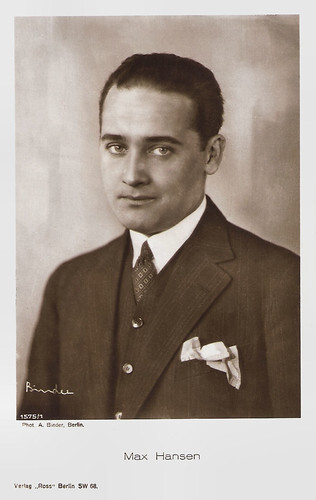
German postcard by Ross Verlag, no. 1575/1, 1927-1928. Photo: Alex Binder, Berlin.
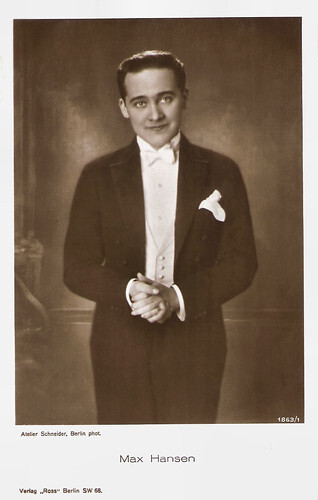
German postcard by Ross Verlag, no. 1863/1, 1927-1928. Photo: Atelier Schneider, Berlin.
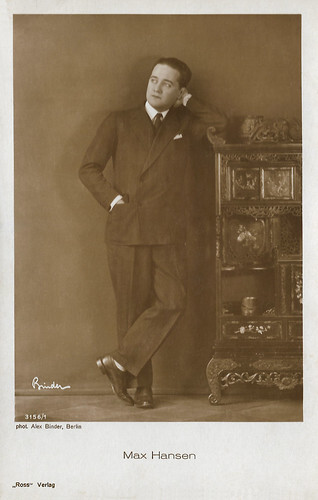
German postcard by Ross Verlag, no. 3156/1, 1928-1929. Photo: Alex Binder, Berlin.
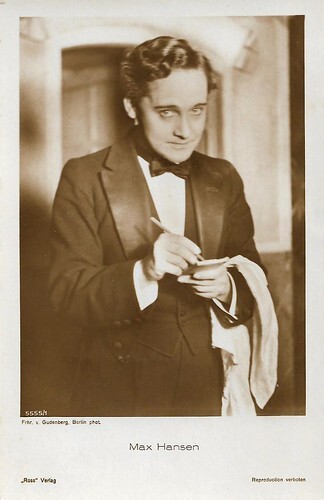
German postcard by Ross Verlag, no. 5555/1, 1930-1931. Photo: Freiherr von Gudenberg, Berlin.
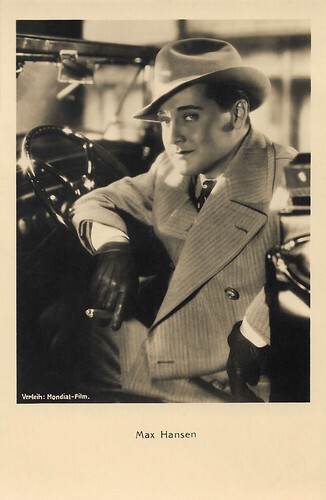
Austrian postcard by Iris Verlag, no. 6307. Photo: Mondial Film.
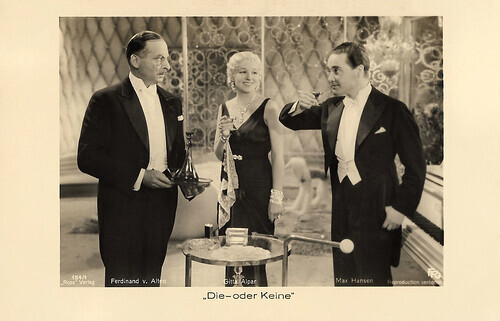
German postcard by Ross Verlag, no. 154/1. Photo: FFG (Carl Froelich Film Produktion). Ferdinand von Alten, Gitta Alpar and Max Hansen in Die - oder keine/She - or Nobody (Carl Froelich, 1932).
Who Takes Love Seriously?
Max Hansen was born Max Josef Haller in Mannheim, Imperial Germany in 1897. He was an illegitimate child to the Danish actress Eva Haller and the Swedish Officer Schürer von Waldheim (according to other sources he had a Jewish father, the Hungarian artist Joseph Walder). Max grew up with foster parents in Munich, where he first appeared at the Cabaret Simplizissimus at the age of 17. In 1914 he moved to Vienna, where he completed his studies as a ballad singer. Filmportal.de : “Thinking that it may perhaps be advantageous to draw attention to his Scandinavian origins, he changes his name to Hansen. Profiting from his powerful, highly modulating voice, he becomes known as the ‘little Caruso’ in cabarets and variety theatres, performing comical couplets, sketches and opera parodies.”
In 1923, Hansen was discovered by Hubert Marischka. He asked him for the tenor role of Baron Kolomán Zsupán in the Emmerich Kálmán operetta 'Gräfin Mariza' (Countess Mariza) at the Theater an der Wien in Vienna. After 900 performances, the popular production moved to the Metropoltheater in Berlin, where Hansen became also very successful. In Berlin, he founded the KadeKo, the Kabarett der Komiker (the Cabaret of Comedians) with Paul Morgan and Kurt Robitschek in 1924. Hansen was engaged by Max Reinhardt for his revival of Jacques Offenbach's 'La belle Hélène', and by Erik Charell for his production of Franz Lehar's 'Die lustige Witwe' (The Merry Widow). Hansen's greatest stage success was playing Leopold the waiter in Ralph Benatzky's operetta-musical 'Im weißen Rößl' (The White Horse Inn) in 1930.
He had already undertaken this part in the silent film Im weißen Rößl/The White Horse Inn (Richard Oswald, 1926) with Liane Haid . A year earlier, he had made his film debut in Husarenfieber/Hussars Fever (Georg Jacoby, 1925) with Georg Alexander . In the following years he appeared in popular silent films like Familie Schimeck/The Schimeck Family (Alfred Halm, Rudolf Dworsky, 1926), and Venus im Frack/Venus in evening dress (Robert Land, 1927) with Carmen Boni . From 1925 on, Hansen also recorded his own hits, which audiences appreciated for their parody and cabaret-like wit.
His real film career began in the sound film era. His first sound film was Wien, du Stadt der Lieder/Vienna, City of Song (Richard Oswald, 1930) with Charlotte Ander and Paul Morgan . The excellent singer was soon pinned down for swinging musicals and comedies. He found an ideal partner in Jenny Jugo in films like Wer nimmt die Liebe ernst.../Who Takes Love Seriously? (Erich Engel, 1931). He also played opposite Gitta Alpár in Die - oder keine/She, or Nobody (Carl Froelich, 1932).
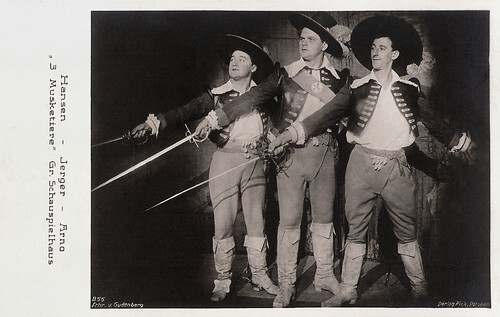
German postcard by Verlag Piek, Postdam, no. 855. Photo: Frhr. von Gudenberg. Max Hansen, Alfred Jerger and Siegfried Arno in the play 'Die drei Musketiere' (The Three Musketeers) (1929) at the Grosse Schauspielhaus.
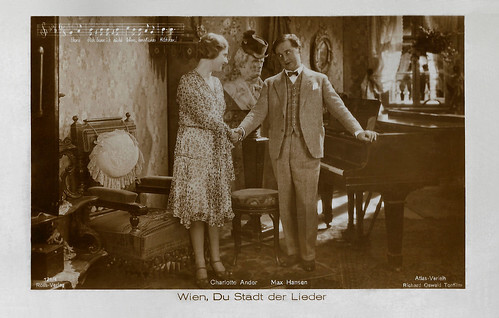
German postcard by Ross Verlag, no. 121/1. Photo: Richard Oswald Tonfilm / Atlas Verleih. Charlotte Ander and Max Hansen in Wien, Du Stadt der Lieder/Vienna, City of Song (Richard Oswald, 1930).
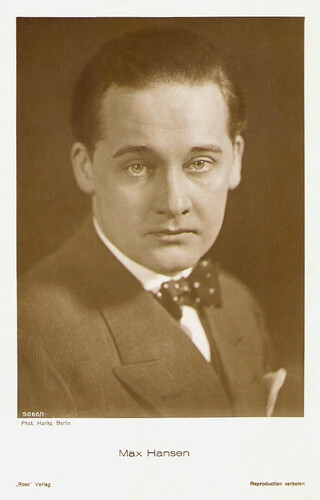
German postcard by Ross Verlag, no. 5060/1, 1930-1931. Photo: Harlip, Berlin.
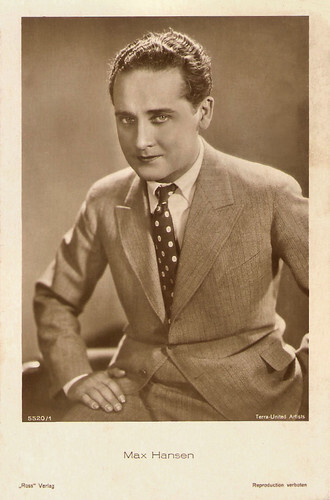
German postcard by Ross Verlag, no. 5520/1, 1930-1931. Photo: Terra / United Artists.
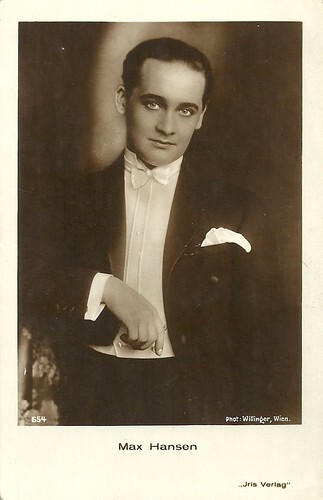
Austrian postcard by Iris Verlag, no. 654. Photo: Willinger, Vienna.
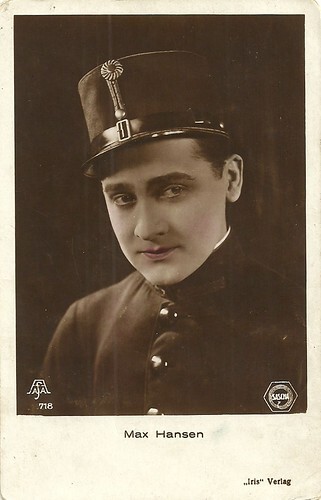
Austrian postcard by Iris Verlag, no. 718. Photo: Sascha Film / Aafa.
Have you ever been in love with me?
Max Hansen satirized Adolf Hitler as a homosexual with his song War'n Sie schon mal in mich verliebt? (Have you ever been in love with me?), which caused the rage of the Nazis. He was thrown with tomatoes at the premiere of the comedy Das häßliche Mädchen/The Ugly Girl (Hermann Kosterlitz, 1933). The film was made in early 1933, during the transition from the Weimar Republic to Nazi Germany, and premièred in September that year. According to Wikipedia , the film's representation of the ‘ugly girl’ as an outsider has been described as a metaphorical way to explore the outsider existence of Jews. Star Dolly Haas and director Hermann Kosterlitz, both Jewish, left Germany and later worked in the United States, where Kosterlitz became well known as Henry Koster.
Hansen returned to Vienna and worked again at the Theater an der Wien. He starred in the film Csardas (Jacob Fleck, Luise Fleck, Walter Kolm-Veltée, 1935) with Irén Zilahy. He also performed in Switzerland, Amsterdam, Oslo and Helsinki. In 1936 he met Zarah Leander on a Scandinavian tour and engaged her as his stage partner in the operetta 'Axel an der Himmels Tür' (Axel at Heaven’s Gate), with music by Ralph Benatzky, produced in Theater an der Wien. It was a hit. After Austria was invaded by Germany in 1938, Hansen emigrated to Denmark, where he founded his own theatre at Copenhagen. He also appeared in Danish films like Tror du jeg er født i går!/Do you think I was born yesterday! (Lau Lauritzen, Jr., Alice O'Fredericks, 1941) and En flicka för mejA girl for me (Börje Larsson, 1943). In addition, he wrote several songs under the pseudonym ‘Sylvester’.
In 1951 he returned to Germany and was successful once again singing the role of Leopold the waiter in 'The White Horse Inn'. In 1953 Hansen moved back to Copenhagen, where he died in 1961. His final film appearance was in the Danish comedy Hvad vil De ha'?/What do you want? (Jens Henriksen, Preben Neergaard, 1956) starring Dirch Passer. Hansen was married to Austrian actress Lizzi Waldmüller till 1938 and since 1940 to Britta Annette Sylvester-Hvid. He had four children. His daughter Ann-Mari Max Hansen (1949) and his son Max Hansen Jr. (1954) are both actors too. In 2004 German director Douglas Wolfsperger portrayed Hansen in his documentary War'n Sie schon mal in mich verliebt?
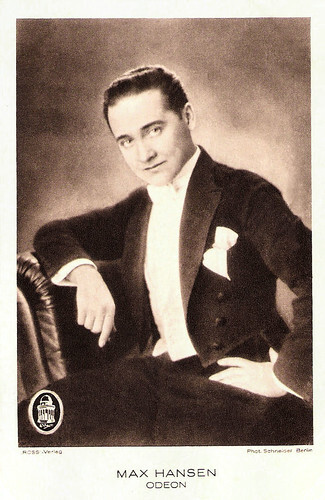
German postcard by Ross Verlag / Odeon. Photo: Schneider, Berlin.
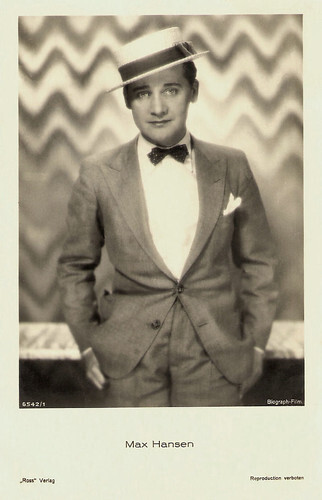
German postcard by Ross Verlag, no. 5542/1, 1930-1931. Photo: Biograph-Film.
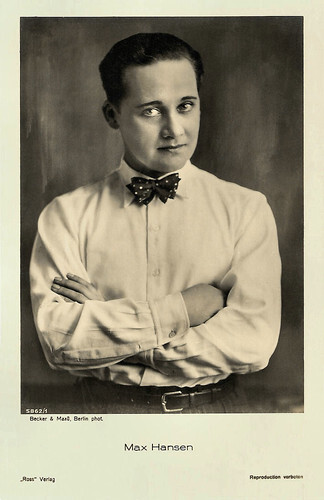
German postcard by Ross Verlag, no. 5862/1, 1930-1931. Photo: Becker & Maass, Berlin.
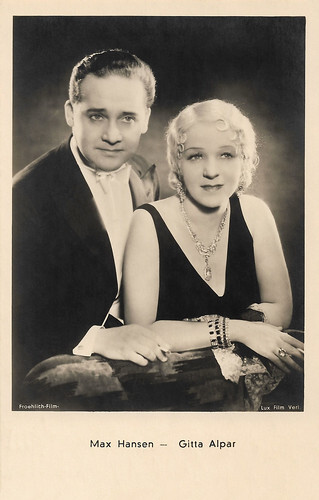
Austrian postcard by Iris Verlag, no. 6608. Photo: Froelich Film / Lux Film Verleih. Max Hansen and Gitta Alpar in Die - oder keine/She - or Nobody (Carl Froelich, 1932).
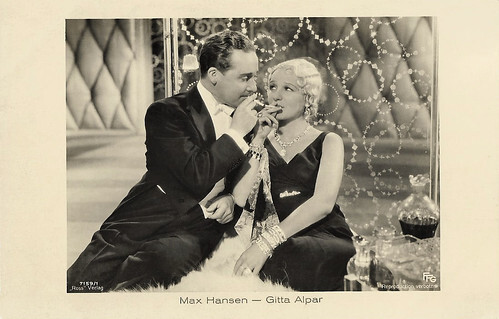
German postcard by Ross Verlag, no. 7159/1, 1932-1933. Photo: FFG. Max Hansen and Gitta Alpar in Die - oder keine/This One or None (Carl Froelich, 1932).
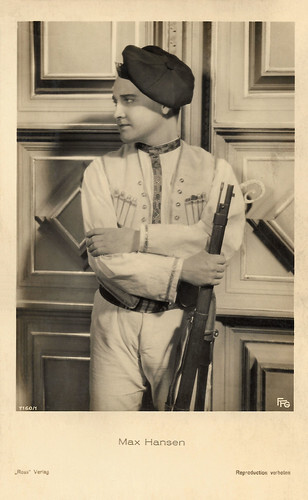
German postcard by Ross Verlag, no. 7160/1, 1932-1933. Photo: FFG. Max Hansen in Die - oder keine/She, or Nobody (Carl Froelich, 1932).
Max Hansen sings War'n Sie schon mal in mich verliebt?. Source: Edmolch (YouTube).
Sources: Thomas Staedeli (Cyranos), Stephanie D’heil (Steffi-line), (IMDb), Filmportal.de, Wikipedia, and .
One of the highlights of the programme is Das Kabinett des Dr. Larifari (1930) by Robert Wohlmuth, a parody of the silent expressionist classic, Das Cabinet des Dr. Caligari/The Cabinet of Dr. Caligari (Robert Wiene, 1920). The comedy was written by Max Hansen and Paul Morgan and they were also the stars. Tomorrow EFSP will focus on Morgan, but today's post presents the Danish cabaret artist, actor, comedian and singer Max Hansen (1897-1961), who was known as 'The Little Caruso'. During the 1920s, he was one of the most popular stars in Berlin.

German postcard by Ross Verlag, no. 1575/1, 1927-1928. Photo: Alex Binder, Berlin.

German postcard by Ross Verlag, no. 1863/1, 1927-1928. Photo: Atelier Schneider, Berlin.

German postcard by Ross Verlag, no. 3156/1, 1928-1929. Photo: Alex Binder, Berlin.

German postcard by Ross Verlag, no. 5555/1, 1930-1931. Photo: Freiherr von Gudenberg, Berlin.

Austrian postcard by Iris Verlag, no. 6307. Photo: Mondial Film.

German postcard by Ross Verlag, no. 154/1. Photo: FFG (Carl Froelich Film Produktion). Ferdinand von Alten, Gitta Alpar and Max Hansen in Die - oder keine/She - or Nobody (Carl Froelich, 1932).
Who Takes Love Seriously?
Max Hansen was born Max Josef Haller in Mannheim, Imperial Germany in 1897. He was an illegitimate child to the Danish actress Eva Haller and the Swedish Officer Schürer von Waldheim (according to other sources he had a Jewish father, the Hungarian artist Joseph Walder). Max grew up with foster parents in Munich, where he first appeared at the Cabaret Simplizissimus at the age of 17. In 1914 he moved to Vienna, where he completed his studies as a ballad singer. Filmportal.de : “Thinking that it may perhaps be advantageous to draw attention to his Scandinavian origins, he changes his name to Hansen. Profiting from his powerful, highly modulating voice, he becomes known as the ‘little Caruso’ in cabarets and variety theatres, performing comical couplets, sketches and opera parodies.”
In 1923, Hansen was discovered by Hubert Marischka. He asked him for the tenor role of Baron Kolomán Zsupán in the Emmerich Kálmán operetta 'Gräfin Mariza' (Countess Mariza) at the Theater an der Wien in Vienna. After 900 performances, the popular production moved to the Metropoltheater in Berlin, where Hansen became also very successful. In Berlin, he founded the KadeKo, the Kabarett der Komiker (the Cabaret of Comedians) with Paul Morgan and Kurt Robitschek in 1924. Hansen was engaged by Max Reinhardt for his revival of Jacques Offenbach's 'La belle Hélène', and by Erik Charell for his production of Franz Lehar's 'Die lustige Witwe' (The Merry Widow). Hansen's greatest stage success was playing Leopold the waiter in Ralph Benatzky's operetta-musical 'Im weißen Rößl' (The White Horse Inn) in 1930.
He had already undertaken this part in the silent film Im weißen Rößl/The White Horse Inn (Richard Oswald, 1926) with Liane Haid . A year earlier, he had made his film debut in Husarenfieber/Hussars Fever (Georg Jacoby, 1925) with Georg Alexander . In the following years he appeared in popular silent films like Familie Schimeck/The Schimeck Family (Alfred Halm, Rudolf Dworsky, 1926), and Venus im Frack/Venus in evening dress (Robert Land, 1927) with Carmen Boni . From 1925 on, Hansen also recorded his own hits, which audiences appreciated for their parody and cabaret-like wit.
His real film career began in the sound film era. His first sound film was Wien, du Stadt der Lieder/Vienna, City of Song (Richard Oswald, 1930) with Charlotte Ander and Paul Morgan . The excellent singer was soon pinned down for swinging musicals and comedies. He found an ideal partner in Jenny Jugo in films like Wer nimmt die Liebe ernst.../Who Takes Love Seriously? (Erich Engel, 1931). He also played opposite Gitta Alpár in Die - oder keine/She, or Nobody (Carl Froelich, 1932).

German postcard by Verlag Piek, Postdam, no. 855. Photo: Frhr. von Gudenberg. Max Hansen, Alfred Jerger and Siegfried Arno in the play 'Die drei Musketiere' (The Three Musketeers) (1929) at the Grosse Schauspielhaus.

German postcard by Ross Verlag, no. 121/1. Photo: Richard Oswald Tonfilm / Atlas Verleih. Charlotte Ander and Max Hansen in Wien, Du Stadt der Lieder/Vienna, City of Song (Richard Oswald, 1930).

German postcard by Ross Verlag, no. 5060/1, 1930-1931. Photo: Harlip, Berlin.

German postcard by Ross Verlag, no. 5520/1, 1930-1931. Photo: Terra / United Artists.

Austrian postcard by Iris Verlag, no. 654. Photo: Willinger, Vienna.

Austrian postcard by Iris Verlag, no. 718. Photo: Sascha Film / Aafa.
Have you ever been in love with me?
Max Hansen satirized Adolf Hitler as a homosexual with his song War'n Sie schon mal in mich verliebt? (Have you ever been in love with me?), which caused the rage of the Nazis. He was thrown with tomatoes at the premiere of the comedy Das häßliche Mädchen/The Ugly Girl (Hermann Kosterlitz, 1933). The film was made in early 1933, during the transition from the Weimar Republic to Nazi Germany, and premièred in September that year. According to Wikipedia , the film's representation of the ‘ugly girl’ as an outsider has been described as a metaphorical way to explore the outsider existence of Jews. Star Dolly Haas and director Hermann Kosterlitz, both Jewish, left Germany and later worked in the United States, where Kosterlitz became well known as Henry Koster.
Hansen returned to Vienna and worked again at the Theater an der Wien. He starred in the film Csardas (Jacob Fleck, Luise Fleck, Walter Kolm-Veltée, 1935) with Irén Zilahy. He also performed in Switzerland, Amsterdam, Oslo and Helsinki. In 1936 he met Zarah Leander on a Scandinavian tour and engaged her as his stage partner in the operetta 'Axel an der Himmels Tür' (Axel at Heaven’s Gate), with music by Ralph Benatzky, produced in Theater an der Wien. It was a hit. After Austria was invaded by Germany in 1938, Hansen emigrated to Denmark, where he founded his own theatre at Copenhagen. He also appeared in Danish films like Tror du jeg er født i går!/Do you think I was born yesterday! (Lau Lauritzen, Jr., Alice O'Fredericks, 1941) and En flicka för mejA girl for me (Börje Larsson, 1943). In addition, he wrote several songs under the pseudonym ‘Sylvester’.
In 1951 he returned to Germany and was successful once again singing the role of Leopold the waiter in 'The White Horse Inn'. In 1953 Hansen moved back to Copenhagen, where he died in 1961. His final film appearance was in the Danish comedy Hvad vil De ha'?/What do you want? (Jens Henriksen, Preben Neergaard, 1956) starring Dirch Passer. Hansen was married to Austrian actress Lizzi Waldmüller till 1938 and since 1940 to Britta Annette Sylvester-Hvid. He had four children. His daughter Ann-Mari Max Hansen (1949) and his son Max Hansen Jr. (1954) are both actors too. In 2004 German director Douglas Wolfsperger portrayed Hansen in his documentary War'n Sie schon mal in mich verliebt?

German postcard by Ross Verlag / Odeon. Photo: Schneider, Berlin.

German postcard by Ross Verlag, no. 5542/1, 1930-1931. Photo: Biograph-Film.

German postcard by Ross Verlag, no. 5862/1, 1930-1931. Photo: Becker & Maass, Berlin.

Austrian postcard by Iris Verlag, no. 6608. Photo: Froelich Film / Lux Film Verleih. Max Hansen and Gitta Alpar in Die - oder keine/She - or Nobody (Carl Froelich, 1932).

German postcard by Ross Verlag, no. 7159/1, 1932-1933. Photo: FFG. Max Hansen and Gitta Alpar in Die - oder keine/This One or None (Carl Froelich, 1932).

German postcard by Ross Verlag, no. 7160/1, 1932-1933. Photo: FFG. Max Hansen in Die - oder keine/She, or Nobody (Carl Froelich, 1932).
Max Hansen sings War'n Sie schon mal in mich verliebt?. Source: Edmolch (YouTube).
Sources: Thomas Staedeli (Cyranos), Stephanie D’heil (Steffi-line), (IMDb), Filmportal.de, Wikipedia, and .
Published on June 27, 2022 22:00
June 26, 2022
Directed by Erich von Stroheim
Highlights at Il Cinema Ritrovato in Bologna are always the cine-concerts. This year, the Bologna Opera House Orchestra, conducted by Timothy Brock, will be back to Piazza Maggiore to accompany two masterpieces turning 100. Tonight, the magnificent Foolish Wives by Erich von Stroheim (1885-1957) will be the first cine-concert. We will be there. So today's post is on Erich von Stroheim's short but interesting career as a director.
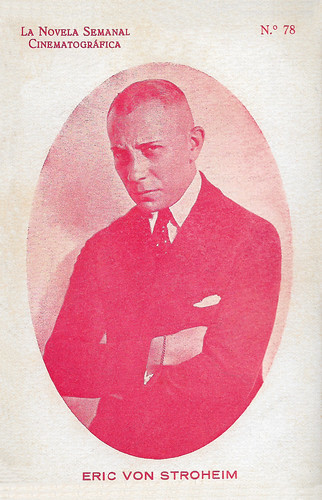
Spanish card by La Novela Semanal Cinematográfica, no. 78. Erich von Stroheim.
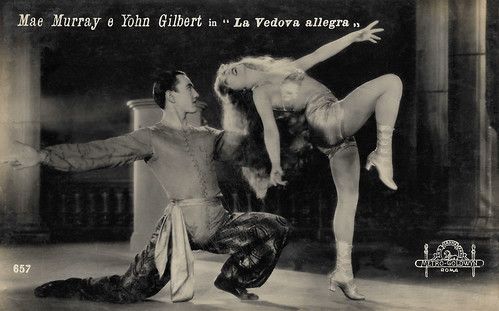
Italian postcard by Casa Editrice Ballerini & Fratini, Firenze, no. 657. Photo: Metro-Goldwyn-Film, Roma. Mae Murray and John Gilbert in The Merry Widow (Erich von Stroheim, 1925).
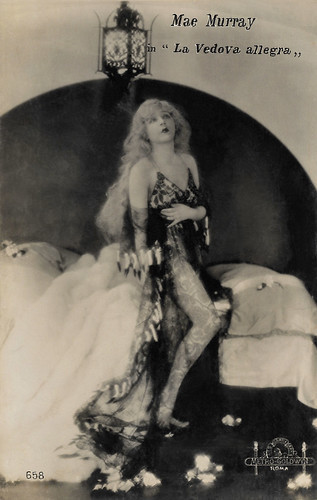
Italian postcard by Casa Editrice Ballerini & Fratini, Firenze, no. 658. Photo: Metro-Goldwyn, Roma. Mae Murray in The Merry Widow (Erich von Stroheim, 1925).
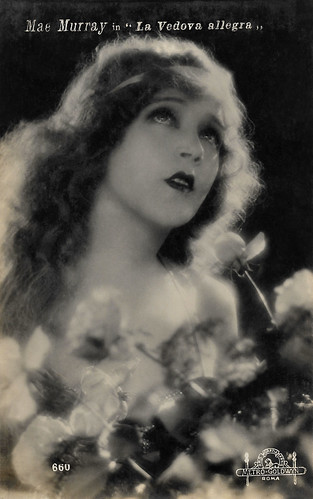
Italian postcard by Casa Editrice Ballerini & Fratini, Firenze, no. 660. Photo: Metro-Goldwyn, Roma. Mae Murray in The Merry Widow (Erich von Stroheim, 1925).
Blind Husbands (1919), The Devil's Passkey (1920) and Foolish Wives (1922)
Erich von Stroheim's directorial debut was Blind Husbands, made in 1919 for Carl Laemmle's Universal. He filmed a script he had written himself about a disastrous love triangle among tourists in the Dolomites. For this film, he also designed the set, did the editing and played a leading role. The film was a great box office success and brought him further directing assignments for Universal Studios.
Stroheim's second film, The Devil's Passkey from 1920, is considered lost today, and only a few stills exist. This film was also very successful, so Stroheim was able to indulge in wild and costly extravagances in his next production, Foolish Women (1921).
Blind Husbands (1919), The Devil's Pass Key (1920) and Foolish Wives (1922) formed a triptych of so-called "sex dramas", films about love triangles and adultery. All three films were about an American wife who went to Europe and, thanks to the attention of a European gentleman, became aware of her own sexuality. The role of the gentleman in Blind Husbands (1919) and Foolish Wives (1922) was played by von Stroheim himself.
Von Stroheim became known as a demanding director, obsessed with details and not afraid to spend money. He often took on multiple roles, including not only director and screenwriter but also actor, film editor and set and costume designer. His reputation was established with Foolish Wives He paints a vitriolic portrait of a society corrupted by money. As a perfectionist, he demanded that wardrobes and chests of drawers, which were not opened once, be filled with clothes.
Foolish Wives cost almost a million dollars which in 1922 was a considerable sum for a film. Von Stroheim had a life-size replica of Monte Carlo built and frequently filmed on location. The film ended up being Universal's biggest hit to date but managed to make little profit due to the high costs.
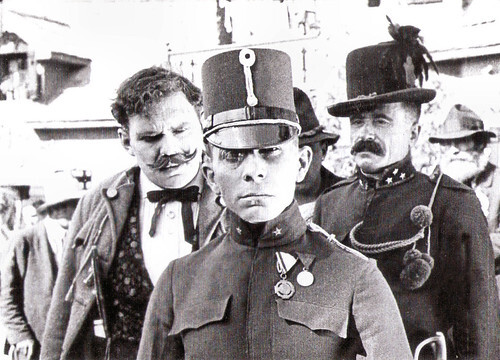
Italian programme card for Il Cinema Ritrovata 2007. Photo: Erich von Stroheim in Blind Husbands (Erich von Stroheim, 1919).
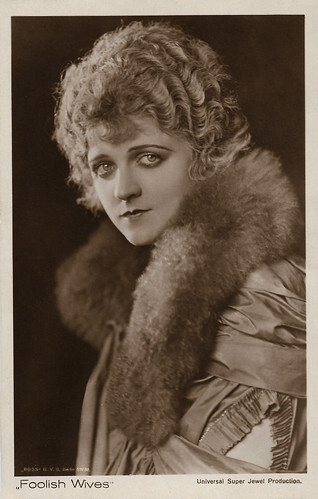
German postcard by Ross Verlag. Photo: Universal / Super Jewel. Miss DuPont in Foolish Wives (Erich von Stroheim, 1922).
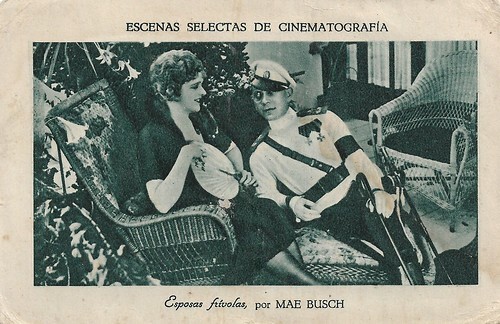
Spanish minicard in the Escenas selectas de cinematografía series, series A, no. 2, for Chocolate Guillèn. Erich von Stroheim in Foolish Wives (Von Stroheim, 1922). The lady depicted is not Mae Busch but Miss Dupont.
Merry-Go-Round (1923) and Greed (1924)
Erich von Stroheim's films were also known for the slow pace at which the story was told. Because of this, Universal, under production head Irving Thalberg, often left the editing to other people. Foolish Wives was a third shorter than von Stroheim actually intended. Halfway through the production of his fourth film, Merry-Go-Round (1923), he was fired by Thalberg.
He had once again not adhered to the studio's specifications. Von Stroheim ordered the necessary military uniforms in Vienna, because in his opinion this was the only way to portray the necessary authenticity. He had extras who appeared as soldiers drill for days until he was satisfied with the shots. He had the Prater in Vienna recreated in great detail on the studio lot. Von Stroheim was replaced by Rupert Julian and he left for Goldwyn.
His best-known film is maybe his fifth, Greed (1924), an adaptation of the novel 'McTeague' by Frank Norris. This film is now considered von Stroheim's masterpiece. The version of the film edited by von Stroheim followed the novel very closely. This led to a 42-reel version, lasting more than eight hours. Von Stroheim, however, had to contend with Irving Thalberg again, who became his boss when Goldwyn merged with Metro (where Thalberg was working at the time).
Thalberg demanded that Von Stroheim shorten the film. The new version included 24 reels, still too long for theatrical release. Rex Ingram shortened the film to an 18-reel version. Eventually, a ten reel version lasting just over two hours was released in cinemas, much to von Stroheim's dismay.
This version received mixed reviews from critics and was not a success in cinemas. The few who had seen the original, complete version said it was one of the greatest masterpieces in film history. However, this version has been lost and probably destroyed.
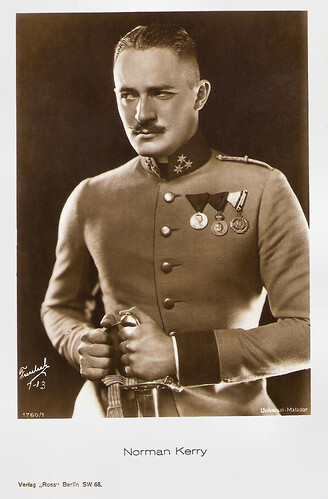
German postcard by Ross Verlag, Berlin, no. 1760/1, 1927-1928. Photo: Freulich / Universal-Matador. Norman Kerry in Merry-Go-Round (Rupert Julian, Erich von Stroheim, 1923).
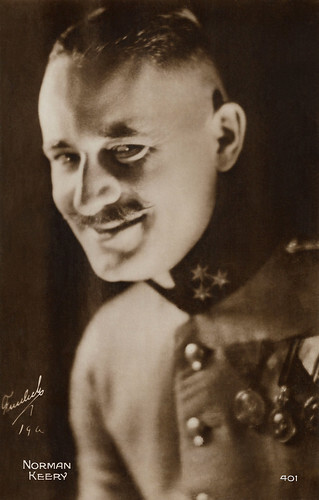
French postcard by Cinémagazine-Edition, no. 401. Photo: Roman Freulich. Norman Kerry in Merry-Go-Round (Rupert Julian, Erich von Stroheim, 1923). Norman Kerry's surname is misspelled on the card as Keery.
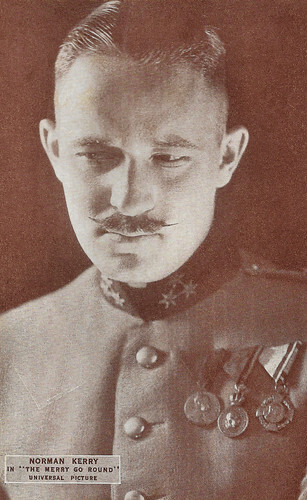
American postcard. Photo: Universal. Norman Kerry in Merry-Go-Round (Erich von Stroheim, 1923).
The Merry Widow (1925) and The Wedding March (1928)
For MGM, Erich von Stroheim made The Merry Widow, starring Mae Murray and John Gilbert as the romantic couple Sally O'Hara and Prince Danilo. It was an adaptation of Franz Lehár's operetta. He hijacked the operetta to make a film about orgies in a royal court with cripples, sex addicts and degenerate monarchs. The film was a huge success.
Von Stroheim made his next film for Paramount, The Wedding March (1925). Von Stroheim had also seen these films as part of a triptych, with Merry-Go-Round as the first part, about decadence in the Habsburg Empire.
Due to the great success of The Merry Widow, Stroheim was given a free hand again and was initially able to shape the production of The Wedding March at Paramount entirely according to his own ideas. Again, however, he exceeded the planned shooting time and budget to such an extent that filming was abandoned.
The Wedding March was also far too long to be released in cinemas, and was released in two parts, with the second part being shown as a stand-alone film, The Honeymoon.Today, only a fragment of the first part exists. The second part, The Honeymoon, is considered lost.
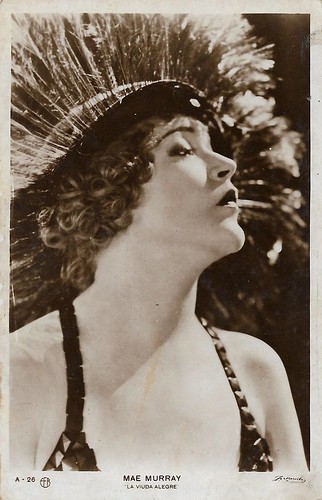
Spanish postcard by EFB (Editorial Fotografica, Barcelona), no. A-26. Photo: Zerkowitz. Mae Murray in The Merry Widow (Erich von Stroheim, 1925).
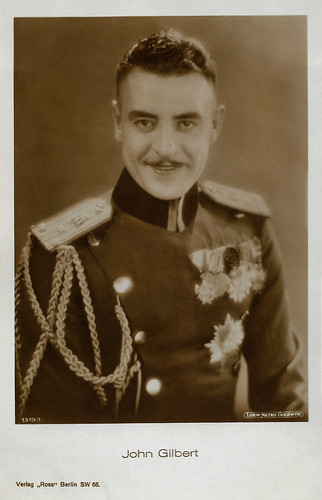
German postcard by Ross Verlag, no. 1319/1, 1927-1928. Photo: Loew Metro Goldwyn. John Gilbert in The Merry Widow (Erich von Stroheim, 1925).
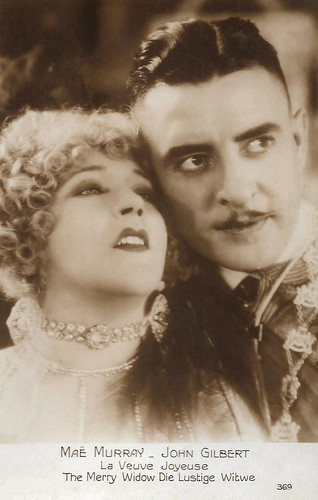
French postcard in the Les Vedettes de Cinéma Series, by A.N., Paris, no. 369. Mae Murray [the trema is a mistake] and John Gilbert in The Merry Widow (Erich von Stroheim, 1925). The film was a huge success.
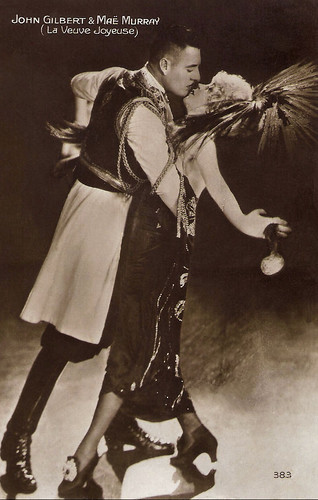
French postcard by Cinémagazine-Edition, Paris, no. 383. Photo: Metro-Goldwyn-Film. John Gilbert and Mae Murray in The Merry Widow (Erich von Stroheim, 1925).
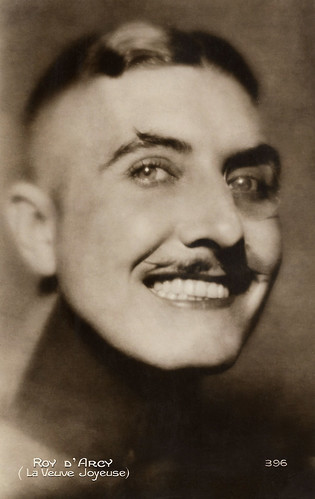
French postcard by Cinémagazine-Edition, Paris, no. 396. Photo: Roy d'Arcy in The Merry Widow (Erich Von Stroheim, 1925).
Queen Kelly (1928) and Walking down Broadway (1932)
Erich von Stroheim's last film was Queen Kelly in 1928. Stroheim used up countless hours of footage for the prologue alone. Due to friction with leading actress and producer Gloria Swanson, Joseph Kennedy, Swanson's co-producer and partner, forced the director to leave. Kennedy declared: "Stroheim must never be allowed to direct a film again".
Swanson had a few more scenes shot without Stroheim to bring the plot to a close. However, this version was only shown a few times in Europe and then disappeared into the archives. A restored version of the existing material according to Stroheim's original plans was only made available to the public in 1985.
His reputation as a director was ruined as a result, and Von Stroheim was forced to return to the camera as a performer for other directors. In 1929 he played the title role in his first sound film, The Great Gabbo by James Cruze. Just like at the beginning of his career, he was now often seen again as a villain in supporting roles. During this period, Stroheim was also frequently forced to work as a technical advisor and assistant dramaturge.
All Von Stroheim's films were silent movies. Fox allowed him to direct the sound film Walking Down Broadway in 1932, but the film was entirely re-edited on the orders of producer Sol Wurtzel and enhanced with new scenes shot by Alfred Werker. The final version was released in 1933 under the title Hello, Sister.
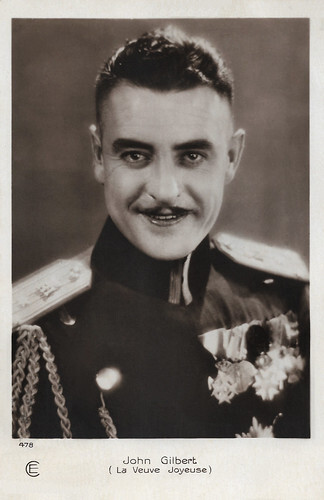
French postcard by Cinémagazine-Edition, Paris, no. 478. Photo: Metro-Goldwyn-Film. John Gilbert in The Merry Widow (Erich von Stroheim, 1925).
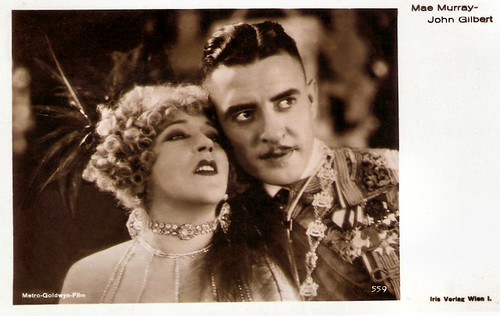
Austrian postcard by Iris Verlag, no. 559. Photo: Metro-Goldwyn-Film. John Gilbert and Mae Murray in The Merry Widow (Erich von Stroheim, 1925).
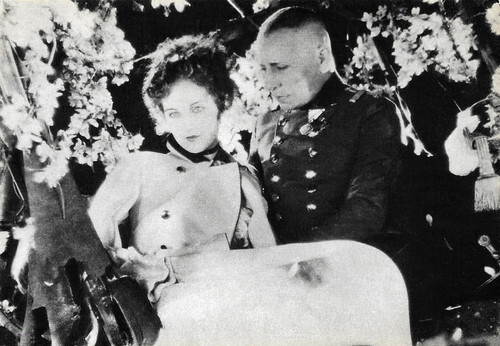
Italian card for the Il Cinema Ritrovato festival. Photo: Fay Wray and Erich von Stroheim in The Wedding March (Erich von Stroheim, 1928).
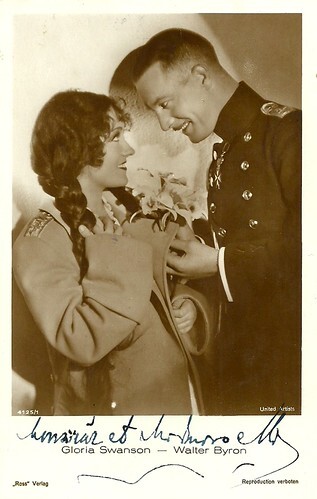
German postcard by Ross Verlag, no. 4125/1, 1929-1930. Photo: United Artists. Walter Byron and Gloria Swanson in Queen Kelly (Erich von Stroheim, 1929).
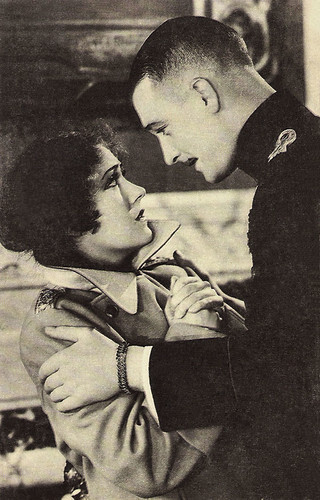
Spanish postcard by Casa Molina, Madrid. Gloria Swanson and Walter Byron in Queen Kelly (Erich von Stroheim, 1929).
Sources: Wikipedia (Dutch, French and German) and .

Spanish card by La Novela Semanal Cinematográfica, no. 78. Erich von Stroheim.

Italian postcard by Casa Editrice Ballerini & Fratini, Firenze, no. 657. Photo: Metro-Goldwyn-Film, Roma. Mae Murray and John Gilbert in The Merry Widow (Erich von Stroheim, 1925).

Italian postcard by Casa Editrice Ballerini & Fratini, Firenze, no. 658. Photo: Metro-Goldwyn, Roma. Mae Murray in The Merry Widow (Erich von Stroheim, 1925).

Italian postcard by Casa Editrice Ballerini & Fratini, Firenze, no. 660. Photo: Metro-Goldwyn, Roma. Mae Murray in The Merry Widow (Erich von Stroheim, 1925).
Blind Husbands (1919), The Devil's Passkey (1920) and Foolish Wives (1922)
Erich von Stroheim's directorial debut was Blind Husbands, made in 1919 for Carl Laemmle's Universal. He filmed a script he had written himself about a disastrous love triangle among tourists in the Dolomites. For this film, he also designed the set, did the editing and played a leading role. The film was a great box office success and brought him further directing assignments for Universal Studios.
Stroheim's second film, The Devil's Passkey from 1920, is considered lost today, and only a few stills exist. This film was also very successful, so Stroheim was able to indulge in wild and costly extravagances in his next production, Foolish Women (1921).
Blind Husbands (1919), The Devil's Pass Key (1920) and Foolish Wives (1922) formed a triptych of so-called "sex dramas", films about love triangles and adultery. All three films were about an American wife who went to Europe and, thanks to the attention of a European gentleman, became aware of her own sexuality. The role of the gentleman in Blind Husbands (1919) and Foolish Wives (1922) was played by von Stroheim himself.
Von Stroheim became known as a demanding director, obsessed with details and not afraid to spend money. He often took on multiple roles, including not only director and screenwriter but also actor, film editor and set and costume designer. His reputation was established with Foolish Wives He paints a vitriolic portrait of a society corrupted by money. As a perfectionist, he demanded that wardrobes and chests of drawers, which were not opened once, be filled with clothes.
Foolish Wives cost almost a million dollars which in 1922 was a considerable sum for a film. Von Stroheim had a life-size replica of Monte Carlo built and frequently filmed on location. The film ended up being Universal's biggest hit to date but managed to make little profit due to the high costs.

Italian programme card for Il Cinema Ritrovata 2007. Photo: Erich von Stroheim in Blind Husbands (Erich von Stroheim, 1919).

German postcard by Ross Verlag. Photo: Universal / Super Jewel. Miss DuPont in Foolish Wives (Erich von Stroheim, 1922).

Spanish minicard in the Escenas selectas de cinematografía series, series A, no. 2, for Chocolate Guillèn. Erich von Stroheim in Foolish Wives (Von Stroheim, 1922). The lady depicted is not Mae Busch but Miss Dupont.
Merry-Go-Round (1923) and Greed (1924)
Erich von Stroheim's films were also known for the slow pace at which the story was told. Because of this, Universal, under production head Irving Thalberg, often left the editing to other people. Foolish Wives was a third shorter than von Stroheim actually intended. Halfway through the production of his fourth film, Merry-Go-Round (1923), he was fired by Thalberg.
He had once again not adhered to the studio's specifications. Von Stroheim ordered the necessary military uniforms in Vienna, because in his opinion this was the only way to portray the necessary authenticity. He had extras who appeared as soldiers drill for days until he was satisfied with the shots. He had the Prater in Vienna recreated in great detail on the studio lot. Von Stroheim was replaced by Rupert Julian and he left for Goldwyn.
His best-known film is maybe his fifth, Greed (1924), an adaptation of the novel 'McTeague' by Frank Norris. This film is now considered von Stroheim's masterpiece. The version of the film edited by von Stroheim followed the novel very closely. This led to a 42-reel version, lasting more than eight hours. Von Stroheim, however, had to contend with Irving Thalberg again, who became his boss when Goldwyn merged with Metro (where Thalberg was working at the time).
Thalberg demanded that Von Stroheim shorten the film. The new version included 24 reels, still too long for theatrical release. Rex Ingram shortened the film to an 18-reel version. Eventually, a ten reel version lasting just over two hours was released in cinemas, much to von Stroheim's dismay.
This version received mixed reviews from critics and was not a success in cinemas. The few who had seen the original, complete version said it was one of the greatest masterpieces in film history. However, this version has been lost and probably destroyed.

German postcard by Ross Verlag, Berlin, no. 1760/1, 1927-1928. Photo: Freulich / Universal-Matador. Norman Kerry in Merry-Go-Round (Rupert Julian, Erich von Stroheim, 1923).

French postcard by Cinémagazine-Edition, no. 401. Photo: Roman Freulich. Norman Kerry in Merry-Go-Round (Rupert Julian, Erich von Stroheim, 1923). Norman Kerry's surname is misspelled on the card as Keery.

American postcard. Photo: Universal. Norman Kerry in Merry-Go-Round (Erich von Stroheim, 1923).
The Merry Widow (1925) and The Wedding March (1928)
For MGM, Erich von Stroheim made The Merry Widow, starring Mae Murray and John Gilbert as the romantic couple Sally O'Hara and Prince Danilo. It was an adaptation of Franz Lehár's operetta. He hijacked the operetta to make a film about orgies in a royal court with cripples, sex addicts and degenerate monarchs. The film was a huge success.
Von Stroheim made his next film for Paramount, The Wedding March (1925). Von Stroheim had also seen these films as part of a triptych, with Merry-Go-Round as the first part, about decadence in the Habsburg Empire.
Due to the great success of The Merry Widow, Stroheim was given a free hand again and was initially able to shape the production of The Wedding March at Paramount entirely according to his own ideas. Again, however, he exceeded the planned shooting time and budget to such an extent that filming was abandoned.
The Wedding March was also far too long to be released in cinemas, and was released in two parts, with the second part being shown as a stand-alone film, The Honeymoon.Today, only a fragment of the first part exists. The second part, The Honeymoon, is considered lost.

Spanish postcard by EFB (Editorial Fotografica, Barcelona), no. A-26. Photo: Zerkowitz. Mae Murray in The Merry Widow (Erich von Stroheim, 1925).

German postcard by Ross Verlag, no. 1319/1, 1927-1928. Photo: Loew Metro Goldwyn. John Gilbert in The Merry Widow (Erich von Stroheim, 1925).

French postcard in the Les Vedettes de Cinéma Series, by A.N., Paris, no. 369. Mae Murray [the trema is a mistake] and John Gilbert in The Merry Widow (Erich von Stroheim, 1925). The film was a huge success.

French postcard by Cinémagazine-Edition, Paris, no. 383. Photo: Metro-Goldwyn-Film. John Gilbert and Mae Murray in The Merry Widow (Erich von Stroheim, 1925).

French postcard by Cinémagazine-Edition, Paris, no. 396. Photo: Roy d'Arcy in The Merry Widow (Erich Von Stroheim, 1925).
Queen Kelly (1928) and Walking down Broadway (1932)
Erich von Stroheim's last film was Queen Kelly in 1928. Stroheim used up countless hours of footage for the prologue alone. Due to friction with leading actress and producer Gloria Swanson, Joseph Kennedy, Swanson's co-producer and partner, forced the director to leave. Kennedy declared: "Stroheim must never be allowed to direct a film again".
Swanson had a few more scenes shot without Stroheim to bring the plot to a close. However, this version was only shown a few times in Europe and then disappeared into the archives. A restored version of the existing material according to Stroheim's original plans was only made available to the public in 1985.
His reputation as a director was ruined as a result, and Von Stroheim was forced to return to the camera as a performer for other directors. In 1929 he played the title role in his first sound film, The Great Gabbo by James Cruze. Just like at the beginning of his career, he was now often seen again as a villain in supporting roles. During this period, Stroheim was also frequently forced to work as a technical advisor and assistant dramaturge.
All Von Stroheim's films were silent movies. Fox allowed him to direct the sound film Walking Down Broadway in 1932, but the film was entirely re-edited on the orders of producer Sol Wurtzel and enhanced with new scenes shot by Alfred Werker. The final version was released in 1933 under the title Hello, Sister.

French postcard by Cinémagazine-Edition, Paris, no. 478. Photo: Metro-Goldwyn-Film. John Gilbert in The Merry Widow (Erich von Stroheim, 1925).

Austrian postcard by Iris Verlag, no. 559. Photo: Metro-Goldwyn-Film. John Gilbert and Mae Murray in The Merry Widow (Erich von Stroheim, 1925).

Italian card for the Il Cinema Ritrovato festival. Photo: Fay Wray and Erich von Stroheim in The Wedding March (Erich von Stroheim, 1928).

German postcard by Ross Verlag, no. 4125/1, 1929-1930. Photo: United Artists. Walter Byron and Gloria Swanson in Queen Kelly (Erich von Stroheim, 1929).

Spanish postcard by Casa Molina, Madrid. Gloria Swanson and Walter Byron in Queen Kelly (Erich von Stroheim, 1929).
Sources: Wikipedia (Dutch, French and German) and .
Published on June 26, 2022 21:00
June 25, 2022
Alla Nazimova
One of the fixtures at Il Cinema Ritrovato is the programme '100 Years ago'. One of the masterpieces of 1922 was Salomé by Charles Bryant and the Russian-born film and theatre actress, screenwriter, and film producer Alla Nazimova. Nazimova (1879–1945) was a grand, highly flamboyant star of American silent cinema. On Broadway, she was noted for her work in the classic plays of Ibsen, Chekhov and Turgenev.
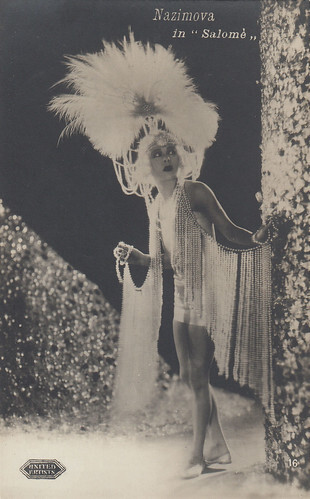
Italian postcard by Casa Editrice Ballerini & Fratini, no. 16. Photo: United Artists. Alla Nazimova in Salome (Charles Bryant, 1922). Collection: Marlene Pilaete.
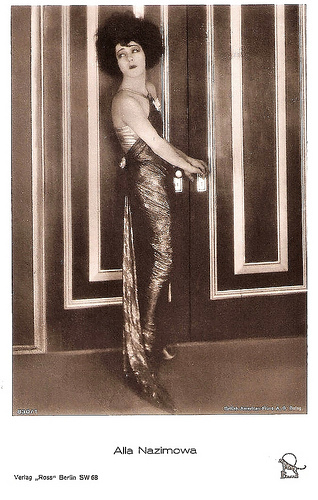
German postcard by Ross Verlag, no. 830/1, 1925-1926. Photo: British-American Films A.G. Balag. Publicity still for Camille (Ray C. Smallwood, 1921).
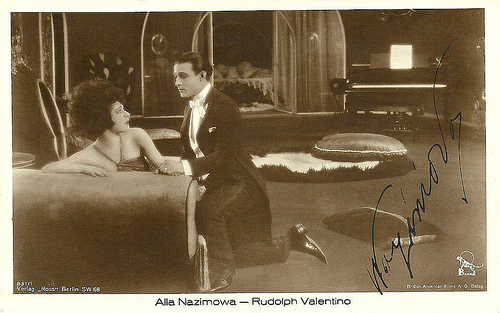
German postcard by Ross Verlag, no. 831/1, 1925-1926. Photo: British American Films / Balag. Collection: Didier Hanson. Publicity still for Camille (Ray C. Smallwood, 1921) with Rudolph Valentino .
Stanislavski
Alla Nazimova (Russian: Алла Назимовa) was born Marem-Ides Leventon (Russian name Adelaida Yakovlevna Leventon) in Yalta, Crimea, Russian Empire, in 1879. She was the youngest of three children of Jewish parents Yakov Abramovich Leventon, a pharmacist, and Sofia (Sara) Lvovna Horowitz, who moved to Yalta in 1870 from Kishinev.
At age 17 Alla Leventon abandoned her training as a violinist and went to Moscow to work in theatre with V.I. Nemirovich-Danchenko. In 1892, she joined Constantin Stanislavski's Moscow Art Theatre using the name of Alla Nazimova for the first time. Her stage name was a combination of Alla (a diminutive of Adelaida) and the surname of Nadezhda Nazimova, the heroine of the Russian novel Children of the Streets.
Nazimova's theatre career blossomed early. In 1899 she married Sergei Golovin, a fellow actor, but they soon separated. Gary Brumburgh at IMDb : “She grew discontented with Stanislavsky and later performed in repertory. She met the legendary Pavel Orlenev, a close friend of Anton Chekhov and Maxim Gorky, and entered into both a personal and professional relationship with him.”
By 1903 she was touring Russian provinces. She also toured Europe, including London and Berlin, with Orlenev. They immigrated to the United States in 1905. He soon returned, but she was signed up by the American producer Henry Miller. Although she spoke not a word of English, she so impressed the Shubert brothers that they hired her on the condition she learn English in six months.
In 1906 she made her Broadway debut in the title role of 'Hedda Gabler' by Henrik Ibsen with critical and popular success. She also played other Ibsen characters: Nora in 'A Doll’s House', Hedwig in 'The Wild Duck', and Hilda in 'The Master Builder'. She quickly became extremely popular and remained a major Broadway star for years.
From 1912 to 1925 Nazimova maintained a ‘fake marriage’ with British actor and director Charles Bryant, who was often her co-star. In order to bolster this arrangement with Bryant, Nazimova kept her marriage to Golovin secret.
Due to her notoriety in a 35-minute 1915 pacifist play entitled War Brides, Nazimova made her silent film debut in the film version, War Brides (Herbert Brenon, 1916), which was produced by independent producer Lewis J. Selznick. She made $100,000 touring in War Brides and an additional $60,000 for the film version. The film's lost status makes it now a sought-after title.
In 1917, she negotiated a contract with Metro Pictures, a precursor to MGM, that included a weekly salary of $13,000. She moved from New York to Hollywood, where she made a number of highly successful films for Metro, including a part as a reformed prostitute in Revelation (George D. Baker, 1918), which earned her a considerable amount of money.
Nazimova soon felt confident enough in her abilities to begin producing and writing films in which she also starred. Examples are Eye for Eye (Albert Capellani, 1918), The Brat (Herbert Blache, 1919) and Madame Peacock (Ray C. Smallwood, 1920).
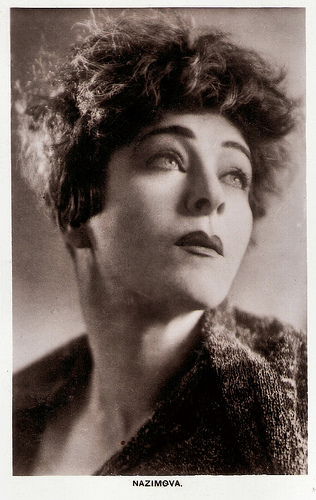
British postcard in the Picturegoer Series, London, no. 203
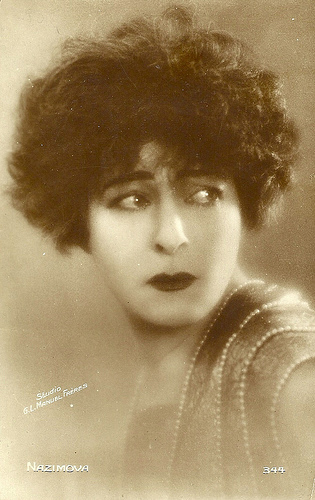
French postcard, no. 344. Photo: Studio G.L. Manuel Frères. Collection: Didier Hanson.
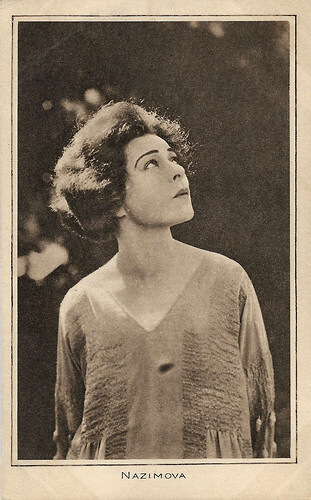
British postcard in the Pictures Portrait Gallery by Pictures Ltd., no. 174.
Lavish Art Deco sets
Alla Nazimova starred in Camille (Ray C. Smallwood, 1921) as the courtesan Marguerite opposite Rudolph Valentino as her idealistic young lover Armand. Camille is based on the play adaptation 'La Dame aux Camélias' (The Lady of the Camellias) by Alexandre Dumas, fils.
The film was set in 1920s Paris, whereas the original version took place in Paris in the 1840s. It had lavish Art Deco sets and Rudolph Valentino later married the art director, Natacha Rambova. Jennifer Horne at The Women Film Pioneers Project : “Working under contract with Metro Pictures Corporation between late 1917 and April 1921, her company, Nazimova Productions, produced nine largely profitable, feature-length films and brought along the writing talent of writer-producer June Mathis. Details regarding the supervisory roles Nazimova played in the production of many of her films remain confusing since not all of Nazimova’s contributions are reflected in the official credits on films.”
In her film adaptations of A Doll's House (Charles Bryant, 1922), based on Henrik Ibsen, and Salomé (Charles Bryant, 1923), based on Oscar Wilde's play, Nazimova developed her own filmmaking techniques, which were considered daring at the time.
Despite the film being only a little over an hour in length and having no real action to speak of, Salomé cost over $350,000 to make. All the sets were constructed indoors to be able to have complete control over the lighting. The film was shot completely in black and white, matching the illustrations done by Aubrey Beardsley in the printed edition of Wilde's play. The costumes, designed by Natacha Rambova, used material only from Maison Lewis of Paris, such as the real silver lamé loincloths worn by the guards.
Both A Doll's House and Salomé were commercial failures. Gary Brumburgh: “The monetary losses she suffered as a producer were astronomical.” Marlene Pilaete adds: "A Doll’s House and Salome were commercial failures but not exactly critical failures, especially A Doll’s House which received mainly positive reviews. The reviews for Salome ranged from favourable to dismissive, which is understandable as it is a much more unconventional movie."
By 1925 Nazimova could no longer afford to invest in more films, and financial backers withdrew their support. Left with few options, she gave up on the film industry. She became an American citizen in 1927.
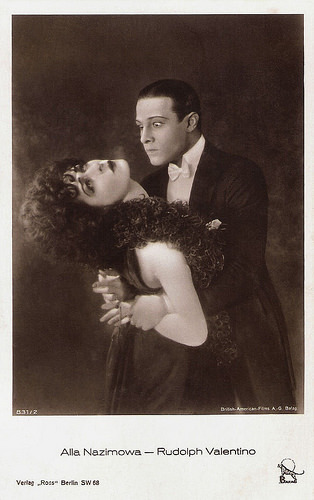
German postcard by Ross Verlag, Berlin, no. 831/2, 1925-1926. Photo: British-American-Films A.G. (Balag). Publicity still for Camille (Ray C. Smallwood, 1921) with Rudolph Valentino.
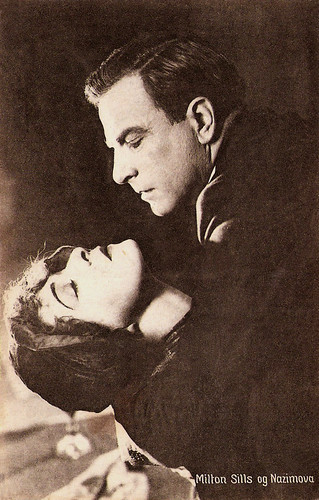
Danish postcard by Stenders Kunstforlag, no. 39. Photo: First National Pictures. Publicity still for Madonna of the Streets (Edwin Carewe, 1924) with Milton Sills .
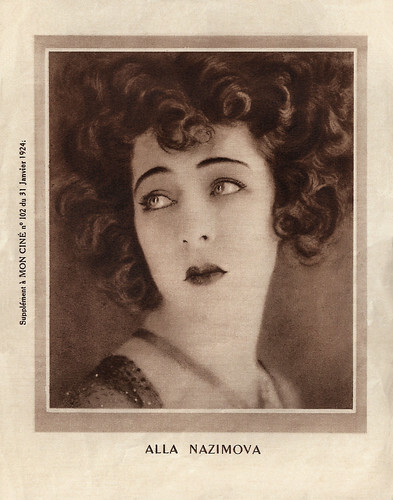
French card by Mon Ciné. The card was a supplement to the magazine Mon Ciné, no. 102, published 3 January 1924.
Outlandish parties at her mansion on Sunset Boulevard
In 1928, Alla Nazimova returned to the Broadway stage as Madame Ranevsky in Eva Le Gallienne’s production of Anton Chekhov’s The Cherry Orchard.
Acclaimed were also her starring roles as Natalya Petrovna in Rouben Mamoulian's 1930 production of Turgenev's 'A Month in the Country', Christine in Eugene O’Neill’s 'Mourning Becomes Electra' (1931), O-Lan in Pearl Buck’s 'The Good Earth' 1932), and as Mrs. Alving in Ibsen's 'Ghosts' (1935).
In the early 1940s, she played character roles in a few more films. She played Robert Taylor 's mother who is in a concentration camp in Nazi Germany in Escape (Mervyn Le Roy, 1940) and Tyrone Power 's mother in Blood and Sand (Rouben Mamoulian, 1941). Her final film was Since You Went Away (John Cromwell, 1944), an epic about the American home front during World War II.
Nazimova openly conducted relationships with women, and there were outlandish parties at her mansion on Sunset Boulevard, in Hollywood, California, known as ‘The Garden of Alla’. She is credited with having originated the phrase ‘sewing circle’ as a discreet code for lesbian or bisexual actresses.
Nazimova helped start the careers of both of Rudolph Valentino 's wives, Jean Acker and Natacha Rambova. Although she was involved in a lesbian affair with Acker, it is debated if Nazimova and Rambova had a sexual affair. Nazimova was impressed by Rambova's skills as an art director, and Rambova designed the innovative sets for her film productions of Camille and Salomé.
Of those Nazimova is confirmed to have been involved romantically, the list includes actress Eva Le Gallienne, director Dorothy Arzner, writer Mercedes de Acosta, and Oscar Wilde's niece, Dolly Wilde. Nazimova lived with Glesca Marshall from 1929 until her death.
In 1945 Alla Nazimova died of coronary thrombosis in a hospital in Los Angeles. She was 66.
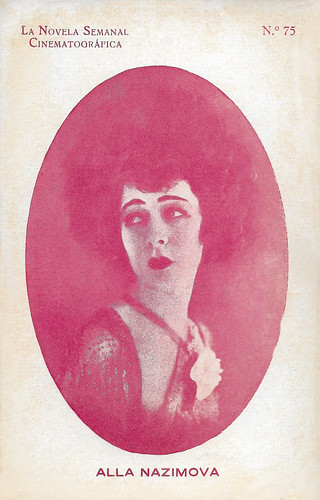
Spanish postcard by La Novela Semanal Cinematografica, no. 75.
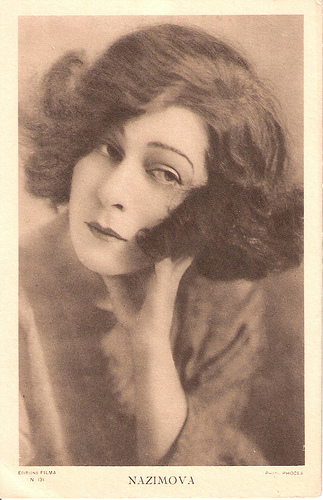
French postcard by Editions Filma, no. 131. Photo: Phocea was a French distributor in the early 1920s, that apparently distributed films with Nazimova in France then.
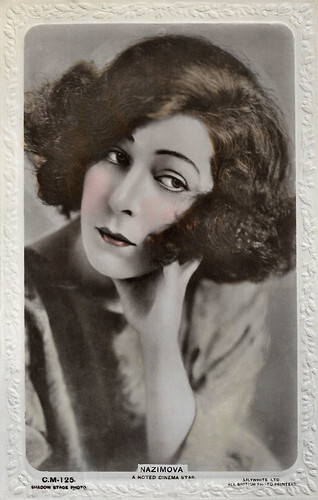
British postcard by Lilywhite Ltd, no. C.M. 125. Caption: Nazimova, A Noted Cinema Star. Sent by mail in 1921.
Sources: Marlene Pilaete (by mail), Jennifer Horne (Women Film Pioneers Project), (IMDb), Sandra Brennan (AllMovie), Encyclopaedia Britannica, Wikipedia and .

Italian postcard by Casa Editrice Ballerini & Fratini, no. 16. Photo: United Artists. Alla Nazimova in Salome (Charles Bryant, 1922). Collection: Marlene Pilaete.

German postcard by Ross Verlag, no. 830/1, 1925-1926. Photo: British-American Films A.G. Balag. Publicity still for Camille (Ray C. Smallwood, 1921).

German postcard by Ross Verlag, no. 831/1, 1925-1926. Photo: British American Films / Balag. Collection: Didier Hanson. Publicity still for Camille (Ray C. Smallwood, 1921) with Rudolph Valentino .
Stanislavski
Alla Nazimova (Russian: Алла Назимовa) was born Marem-Ides Leventon (Russian name Adelaida Yakovlevna Leventon) in Yalta, Crimea, Russian Empire, in 1879. She was the youngest of three children of Jewish parents Yakov Abramovich Leventon, a pharmacist, and Sofia (Sara) Lvovna Horowitz, who moved to Yalta in 1870 from Kishinev.
At age 17 Alla Leventon abandoned her training as a violinist and went to Moscow to work in theatre with V.I. Nemirovich-Danchenko. In 1892, she joined Constantin Stanislavski's Moscow Art Theatre using the name of Alla Nazimova for the first time. Her stage name was a combination of Alla (a diminutive of Adelaida) and the surname of Nadezhda Nazimova, the heroine of the Russian novel Children of the Streets.
Nazimova's theatre career blossomed early. In 1899 she married Sergei Golovin, a fellow actor, but they soon separated. Gary Brumburgh at IMDb : “She grew discontented with Stanislavsky and later performed in repertory. She met the legendary Pavel Orlenev, a close friend of Anton Chekhov and Maxim Gorky, and entered into both a personal and professional relationship with him.”
By 1903 she was touring Russian provinces. She also toured Europe, including London and Berlin, with Orlenev. They immigrated to the United States in 1905. He soon returned, but she was signed up by the American producer Henry Miller. Although she spoke not a word of English, she so impressed the Shubert brothers that they hired her on the condition she learn English in six months.
In 1906 she made her Broadway debut in the title role of 'Hedda Gabler' by Henrik Ibsen with critical and popular success. She also played other Ibsen characters: Nora in 'A Doll’s House', Hedwig in 'The Wild Duck', and Hilda in 'The Master Builder'. She quickly became extremely popular and remained a major Broadway star for years.
From 1912 to 1925 Nazimova maintained a ‘fake marriage’ with British actor and director Charles Bryant, who was often her co-star. In order to bolster this arrangement with Bryant, Nazimova kept her marriage to Golovin secret.
Due to her notoriety in a 35-minute 1915 pacifist play entitled War Brides, Nazimova made her silent film debut in the film version, War Brides (Herbert Brenon, 1916), which was produced by independent producer Lewis J. Selznick. She made $100,000 touring in War Brides and an additional $60,000 for the film version. The film's lost status makes it now a sought-after title.
In 1917, she negotiated a contract with Metro Pictures, a precursor to MGM, that included a weekly salary of $13,000. She moved from New York to Hollywood, where she made a number of highly successful films for Metro, including a part as a reformed prostitute in Revelation (George D. Baker, 1918), which earned her a considerable amount of money.
Nazimova soon felt confident enough in her abilities to begin producing and writing films in which she also starred. Examples are Eye for Eye (Albert Capellani, 1918), The Brat (Herbert Blache, 1919) and Madame Peacock (Ray C. Smallwood, 1920).

British postcard in the Picturegoer Series, London, no. 203

French postcard, no. 344. Photo: Studio G.L. Manuel Frères. Collection: Didier Hanson.

British postcard in the Pictures Portrait Gallery by Pictures Ltd., no. 174.
Lavish Art Deco sets
Alla Nazimova starred in Camille (Ray C. Smallwood, 1921) as the courtesan Marguerite opposite Rudolph Valentino as her idealistic young lover Armand. Camille is based on the play adaptation 'La Dame aux Camélias' (The Lady of the Camellias) by Alexandre Dumas, fils.
The film was set in 1920s Paris, whereas the original version took place in Paris in the 1840s. It had lavish Art Deco sets and Rudolph Valentino later married the art director, Natacha Rambova. Jennifer Horne at The Women Film Pioneers Project : “Working under contract with Metro Pictures Corporation between late 1917 and April 1921, her company, Nazimova Productions, produced nine largely profitable, feature-length films and brought along the writing talent of writer-producer June Mathis. Details regarding the supervisory roles Nazimova played in the production of many of her films remain confusing since not all of Nazimova’s contributions are reflected in the official credits on films.”
In her film adaptations of A Doll's House (Charles Bryant, 1922), based on Henrik Ibsen, and Salomé (Charles Bryant, 1923), based on Oscar Wilde's play, Nazimova developed her own filmmaking techniques, which were considered daring at the time.
Despite the film being only a little over an hour in length and having no real action to speak of, Salomé cost over $350,000 to make. All the sets were constructed indoors to be able to have complete control over the lighting. The film was shot completely in black and white, matching the illustrations done by Aubrey Beardsley in the printed edition of Wilde's play. The costumes, designed by Natacha Rambova, used material only from Maison Lewis of Paris, such as the real silver lamé loincloths worn by the guards.
Both A Doll's House and Salomé were commercial failures. Gary Brumburgh: “The monetary losses she suffered as a producer were astronomical.” Marlene Pilaete adds: "A Doll’s House and Salome were commercial failures but not exactly critical failures, especially A Doll’s House which received mainly positive reviews. The reviews for Salome ranged from favourable to dismissive, which is understandable as it is a much more unconventional movie."
By 1925 Nazimova could no longer afford to invest in more films, and financial backers withdrew their support. Left with few options, she gave up on the film industry. She became an American citizen in 1927.

German postcard by Ross Verlag, Berlin, no. 831/2, 1925-1926. Photo: British-American-Films A.G. (Balag). Publicity still for Camille (Ray C. Smallwood, 1921) with Rudolph Valentino.

Danish postcard by Stenders Kunstforlag, no. 39. Photo: First National Pictures. Publicity still for Madonna of the Streets (Edwin Carewe, 1924) with Milton Sills .

French card by Mon Ciné. The card was a supplement to the magazine Mon Ciné, no. 102, published 3 January 1924.
Outlandish parties at her mansion on Sunset Boulevard
In 1928, Alla Nazimova returned to the Broadway stage as Madame Ranevsky in Eva Le Gallienne’s production of Anton Chekhov’s The Cherry Orchard.
Acclaimed were also her starring roles as Natalya Petrovna in Rouben Mamoulian's 1930 production of Turgenev's 'A Month in the Country', Christine in Eugene O’Neill’s 'Mourning Becomes Electra' (1931), O-Lan in Pearl Buck’s 'The Good Earth' 1932), and as Mrs. Alving in Ibsen's 'Ghosts' (1935).
In the early 1940s, she played character roles in a few more films. She played Robert Taylor 's mother who is in a concentration camp in Nazi Germany in Escape (Mervyn Le Roy, 1940) and Tyrone Power 's mother in Blood and Sand (Rouben Mamoulian, 1941). Her final film was Since You Went Away (John Cromwell, 1944), an epic about the American home front during World War II.
Nazimova openly conducted relationships with women, and there were outlandish parties at her mansion on Sunset Boulevard, in Hollywood, California, known as ‘The Garden of Alla’. She is credited with having originated the phrase ‘sewing circle’ as a discreet code for lesbian or bisexual actresses.
Nazimova helped start the careers of both of Rudolph Valentino 's wives, Jean Acker and Natacha Rambova. Although she was involved in a lesbian affair with Acker, it is debated if Nazimova and Rambova had a sexual affair. Nazimova was impressed by Rambova's skills as an art director, and Rambova designed the innovative sets for her film productions of Camille and Salomé.
Of those Nazimova is confirmed to have been involved romantically, the list includes actress Eva Le Gallienne, director Dorothy Arzner, writer Mercedes de Acosta, and Oscar Wilde's niece, Dolly Wilde. Nazimova lived with Glesca Marshall from 1929 until her death.
In 1945 Alla Nazimova died of coronary thrombosis in a hospital in Los Angeles. She was 66.

Spanish postcard by La Novela Semanal Cinematografica, no. 75.

French postcard by Editions Filma, no. 131. Photo: Phocea was a French distributor in the early 1920s, that apparently distributed films with Nazimova in France then.

British postcard by Lilywhite Ltd, no. C.M. 125. Caption: Nazimova, A Noted Cinema Star. Sent by mail in 1921.
Sources: Marlene Pilaete (by mail), Jennifer Horne (Women Film Pioneers Project), (IMDb), Sandra Brennan (AllMovie), Encyclopaedia Britannica, Wikipedia and .
Published on June 25, 2022 22:00
June 24, 2022
Forever Sophia
We are in Bologna for our favourite festival. One of the main programmes of Il Cinema Ritrovato 2022 is 'Forever Sophia', curated by Emiliano Morreale and Gian Luca Farinelli. Sophia Loren is a symbol of Italy's rebirth from the postwar period to the 1960s, going from national beauty queen to international glamour idol. Nowadays, La Loren is still one of the most recognisable Italian icons in the world. Morreale and Farinelli focus in 'Forever Sophia' on her filmography: the hidden treasures, forgotten gems and nuanced roles. And so do we in this post with postcards of 16 remarkable and unforgettable films starring Sophia Loren.
 /
/
Italian postcard by Bromofoto, Milano, no. 717. Photo: Minerva Film. Sophia Loren in Un giornata in pretura/A Day in Court (Steno, 1954).

Italian postcard in the series Gli Artisti di Napoli. Photo: Totò and Sophia Loren in Miseria e nobiltà/Misery and Nobility (Mario Mattoli, 1954).

French postcard by P.I. / Korès, no. 38. Photo: Constantin Film. Publicity still for La bella mugnaia/The Miller's Wife (Mario Camerini, 1955).

German postcard printed by Krüger, no. 902/304. Photo: Georg Michalke. Sophia Loren (1934) in her 42nd Italian film, La donna del fiume/The woman of the river (Mario Soldati, 1955).
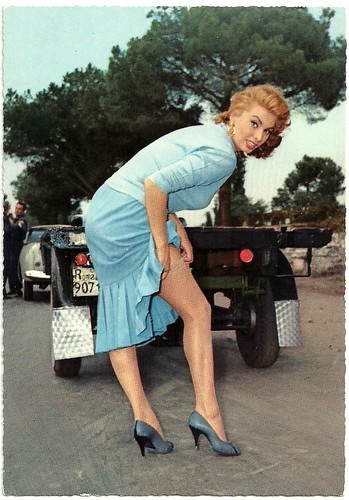
German postcard. Photo Ufa. Publicity still for La fortuna di essere donna/What a Woman! (Alessandro Blasetti, 1956).
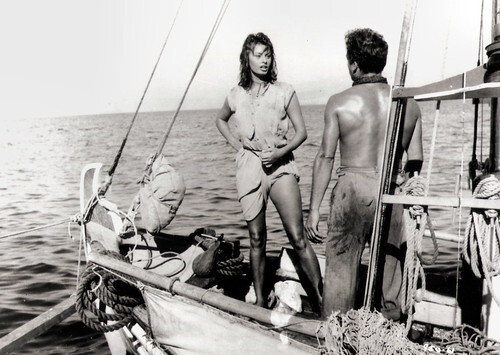
German press photo by ORF Fotodienst, 1988. Sophia Loren and Jorge Mistral in Boy on a Dolphin (Jean Negulesco, 1957).
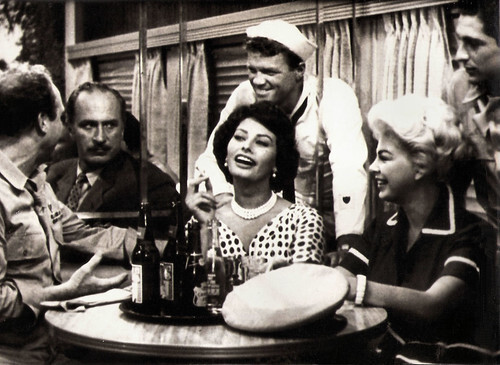
Vintage photo. Jack Warden, Sophia Loren and Barbara Nichols in That Kind of Woman (Sidney Lumet, 1959).
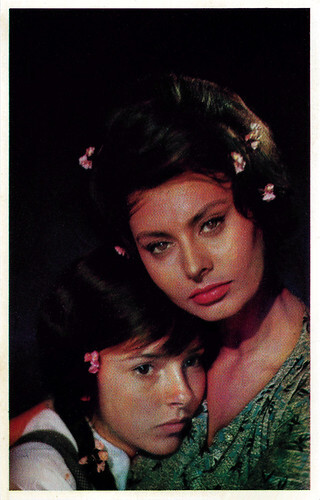
Belgian postcard by Ets. Dagneaux & Co. for STAR, Chewing-gum. Sophia Loren and Eleonora Brown in La ciociara/Two Women (Vittorio De Sica, 1960).

German postcard by ISV, no. A 93. Photo: 20th Century Fox. Publicity still for the British film The Millionairess (Anthony Asquith, 1960).
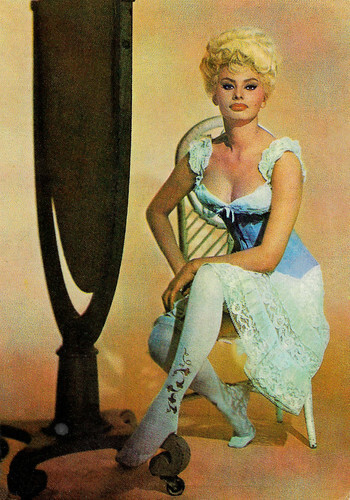
Romanian postcard by Casa Filmului Acin, no. 516. Sophia Loren in Heller in Pink Tights (George Cukor, 1960).
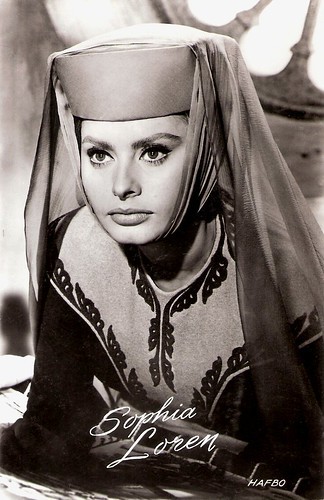
Dutch postcard by Uitg. Takken, Utrecht, no. 4894. Photo: Hafbo. Publicity still from El Cid (Anthony Mann, 1961).
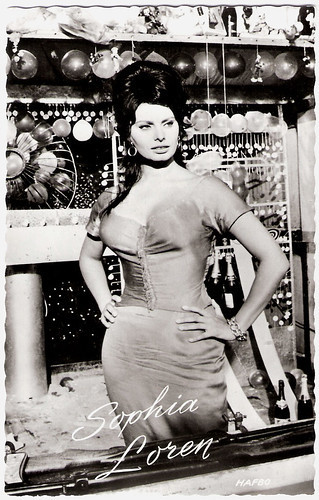
German postcard by Filmbilder-Vertrieb Ernst Freihoff, EssenParis, no. 5096. Photo: publicity still for Boccaccio '70 (Vittorio De Sica, 1962).
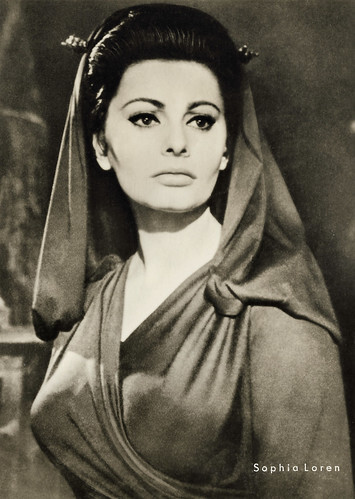
East-German postcard VEB Progress Film-Vertrieb, Berlin, no. 55/71, 1971. Sophia Loren in The Fall of the Roman Empire (Anthony Mann, 1964).
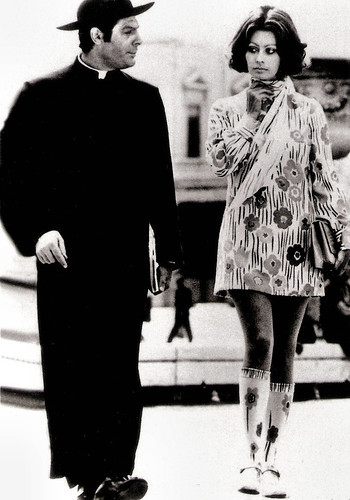
German postcard by pwe Verlag, München (Munich). Photo: Marcello Mastroianni and Sophia Loren in La moglie del prete/The Priest's Wife (Dino Risi, 1970).
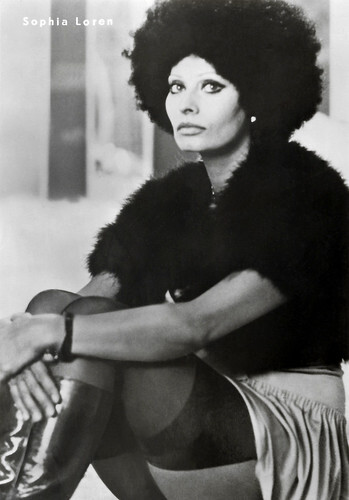
East-German postcard by VEB Progress Film-Vertrieb, Berlin, no. 21/77. Sophia Loren in La pupa del gangster/Get Rita (Giorgio Capitani, 1975).
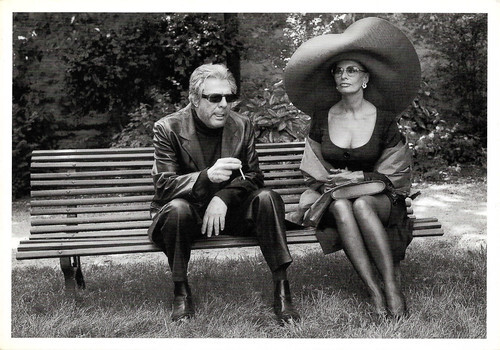
French postcard in the Collection Magie Noire by Éditions Hazan, Paris, 1997, no. 6521. Photo: Constant Anée. Marcello Mastroianni and Sophia Loren in Prêt-à-Porter (Robert Altman, 1994).
 /
/ Italian postcard by Bromofoto, Milano, no. 717. Photo: Minerva Film. Sophia Loren in Un giornata in pretura/A Day in Court (Steno, 1954).

Italian postcard in the series Gli Artisti di Napoli. Photo: Totò and Sophia Loren in Miseria e nobiltà/Misery and Nobility (Mario Mattoli, 1954).

French postcard by P.I. / Korès, no. 38. Photo: Constantin Film. Publicity still for La bella mugnaia/The Miller's Wife (Mario Camerini, 1955).

German postcard printed by Krüger, no. 902/304. Photo: Georg Michalke. Sophia Loren (1934) in her 42nd Italian film, La donna del fiume/The woman of the river (Mario Soldati, 1955).

German postcard. Photo Ufa. Publicity still for La fortuna di essere donna/What a Woman! (Alessandro Blasetti, 1956).

German press photo by ORF Fotodienst, 1988. Sophia Loren and Jorge Mistral in Boy on a Dolphin (Jean Negulesco, 1957).

Vintage photo. Jack Warden, Sophia Loren and Barbara Nichols in That Kind of Woman (Sidney Lumet, 1959).

Belgian postcard by Ets. Dagneaux & Co. for STAR, Chewing-gum. Sophia Loren and Eleonora Brown in La ciociara/Two Women (Vittorio De Sica, 1960).

German postcard by ISV, no. A 93. Photo: 20th Century Fox. Publicity still for the British film The Millionairess (Anthony Asquith, 1960).

Romanian postcard by Casa Filmului Acin, no. 516. Sophia Loren in Heller in Pink Tights (George Cukor, 1960).

Dutch postcard by Uitg. Takken, Utrecht, no. 4894. Photo: Hafbo. Publicity still from El Cid (Anthony Mann, 1961).

German postcard by Filmbilder-Vertrieb Ernst Freihoff, EssenParis, no. 5096. Photo: publicity still for Boccaccio '70 (Vittorio De Sica, 1962).

East-German postcard VEB Progress Film-Vertrieb, Berlin, no. 55/71, 1971. Sophia Loren in The Fall of the Roman Empire (Anthony Mann, 1964).

German postcard by pwe Verlag, München (Munich). Photo: Marcello Mastroianni and Sophia Loren in La moglie del prete/The Priest's Wife (Dino Risi, 1970).

East-German postcard by VEB Progress Film-Vertrieb, Berlin, no. 21/77. Sophia Loren in La pupa del gangster/Get Rita (Giorgio Capitani, 1975).

French postcard in the Collection Magie Noire by Éditions Hazan, Paris, 1997, no. 6521. Photo: Constant Anée. Marcello Mastroianni and Sophia Loren in Prêt-à-Porter (Robert Altman, 1994).
Published on June 24, 2022 22:00
June 23, 2022
Beach Party!
It is summer and holiday time! We are in Italy and tomorrow we are going to Bologna for the Il Cinema Ritrovato festival. So today at EFSP, we are organising a beach party with the stars. You are very welcome!
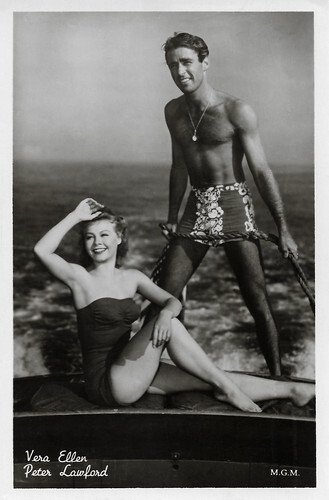
Belgian postcard by Nieuwe Merksemsche Chocolaterie S.P.R.I., Merksem (Anvers / Antwerpen). Photo: M.G.M., 1950.
Blonde, slim Vera-Ellen (1921-1981) was one of the most vivacious and vibrant musical film talents to glide through Hollywood in the 1940s and 1950s. Whether performing solo or dueting with the best male partners of her generation, including Fred Astaire, Gene Kelly, and Donald O'Connor, Vera-Ellen gave life to some of the most extraordinary dance routines ever caught on film. She was a dance sensation in a string of light-hearted but successful films. Vera-Ellen retired from acting in the late 1950s.
English-American actor Peter Lawford (1923-1984), is mainly known as a member of the Rat Pack from which he was later banned due to an argument with Frank Sinatra and as the husband of Patricia Kennedy. Although he was never considered a very important actor, he has played in many famous films. He also appeared frequently on television. He was the first one to kiss Elizabeth Taylor and, according to him, the last one to speak to Marilyn Monroe before she died.
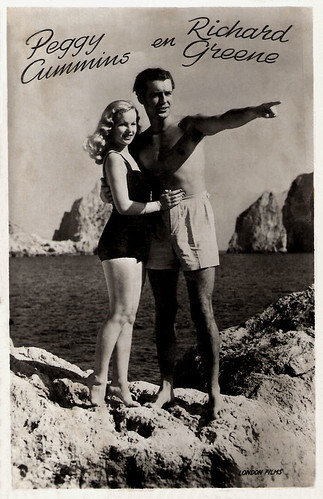
Dutch postcard. Photo: London Films. Publicity still for That Dangerous Age (Gregory Ratoff, 1949).
Darkly handsome British film and television actor Richard Greene (1918-1985) was a matinee idol of the late 1930s who appeared in more than 40 films. He was perhaps best known for the lead role in the long-running British TV series The Adventures of Robin Hood (1955-1960).
Blonde and beautiful Irish actress Peggy Cummins (1925-2017) was unforgettable in the Film Noir classic Gun Crazy (Joseph H. Lewis, 1950) as the trigger-happy femme fatale who robs banks with her lover.
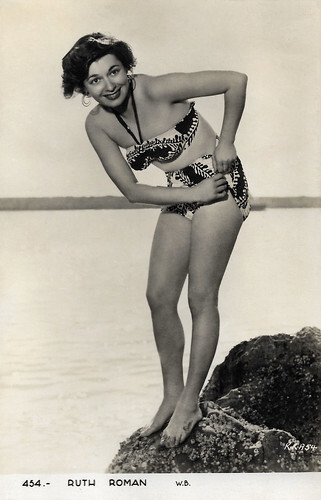
Spanish postcard, no. 454. Photo: Warner Bros.
American actress Ruth Roman (1922–1999) had a memorable role in Alfred Hitchcock's thriller Strangers on a Train (1951).
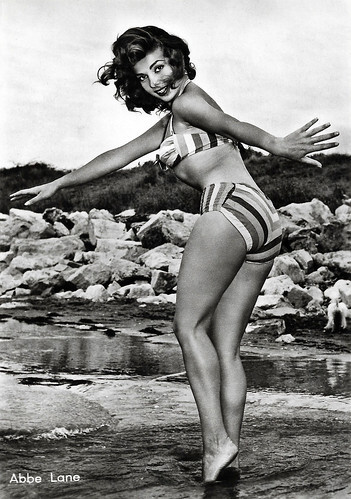
Italian postcard by Bromostampa, Milano, no. 123.
Va-va-voom singer Abbe Lane (1932) achieved her greatest success as the vocalist for Xavier Cugat's orchestra, but she also appeared in several American and Italian films. The beautiful, curvaceous Lane was nicknamed 'the swingingest sexpot in show business.'
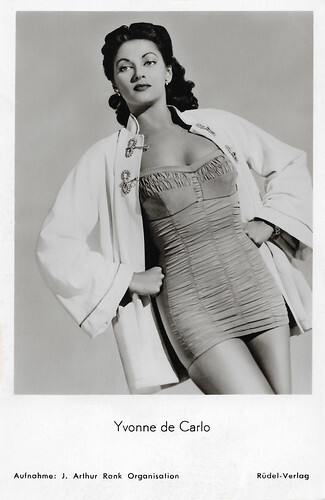
West-German postcard by Rüdel-Verlag, Hamburg-Bergedorf, no. 542. Photo: J. Arthur Rank Organisation. Yvonne de Carlo in Hotel Sahara (Ken Annakin, 1951).
Dark-haired Hollywood beauty Yvonne De Carlo (1922–2007) was a Canadian American actress, singer, and dancer whose career in film, television, and musical theatre spanned six decades. From the 1950s on, she also starred in British and Italian films. She achieved her greatest popularity as the ghoulish matriarch Lily in the TV sitcom The Munsters (1964-1966).
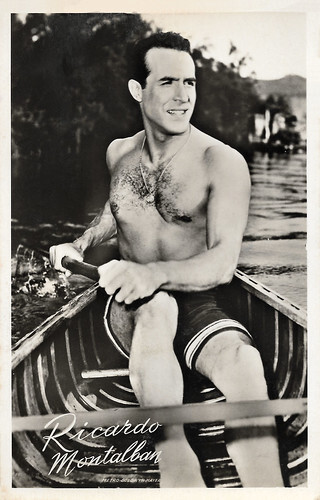
Dutch postcard by Takken, Utrecht, no. 1694. Photo: Metro-Goldwyn-Mayer. Ricardo Montalban takes a few minutes between scenes of Two Weeks with Love (Roy Rowland, 1952) to start a summer tan.
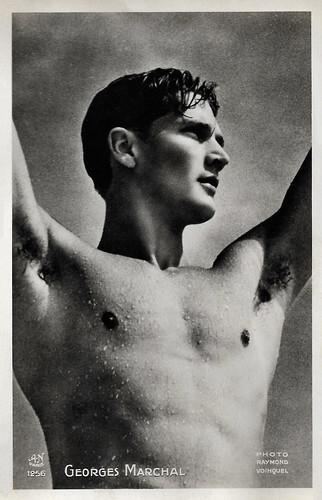
French postcard by A.N., Paris, no. 1256. Photo: Raymond Voinquel.
Handsome and athletic Georges Marchal (1920-1997) was one of the main lead actors in the French cinema of the 1950s, together with Jean Marais. He starred in several costume dramas and Swashbucklers and later appeared in films by Luis Buñuel.
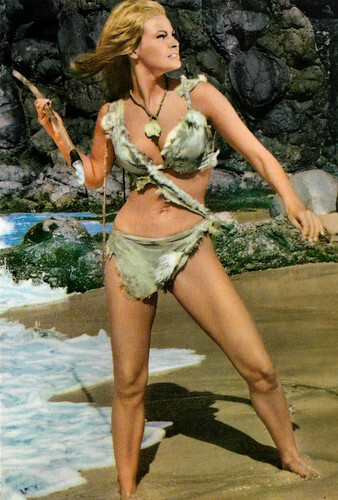
Italian postcard, no. 100 104. Raquel Welch in One Million Years BC (Don Chaffey, 1966).
American actress Raquel Welch (1940) is one of the icons of the 1960s and 1970s. She first won attention for her role in Fantastic Voyage (1966). In Great Britain, she then made One Million Years B.C. (1966). Although she had only three lines in the film, a poster of Welch in a furry prehistoric bikini became an amazing bestseller and catapulted her to stardom.
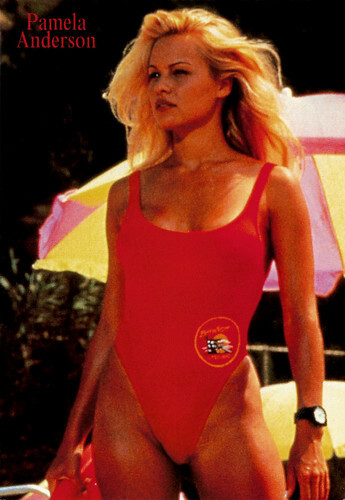
British postcard by Heroes Publishing LTD, London, no. SPC2610. Pamela Anderson as C.J. Parker in the TV series Baywatch (1992-1997).
Sexy Canadian-American actress and model Pamela Anderson (1967) is best known for the TV series Home Improvement, Baywatch and V.I.P., but the platinum blonde but naturally born brunette also appeared in a dozen of feature films and on a record 14 Playboy covers. Furthermore she is an international celebrity thanks to her rocky marriages, her animal rights activism and her changing bust sizes.
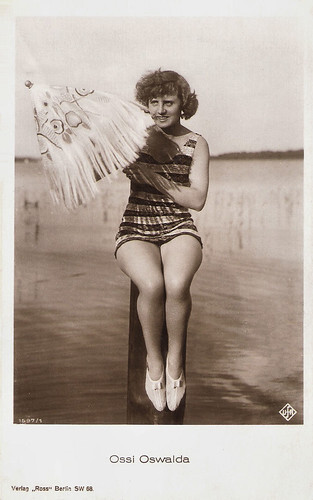
German postcard by Ross Verlag, Berlin, no. 1597/1, 1927-1928. Photo: Ufa.
Ossi Oswalda (1895-1947) was one of the most popular comediennes of German silent cinema.
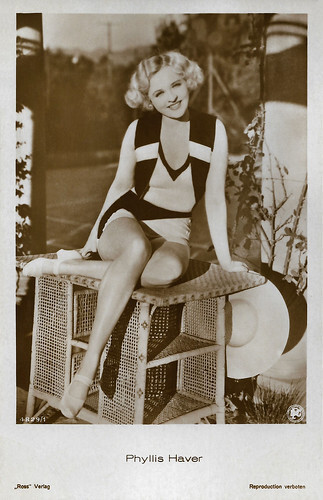
German postcard by Ross Verlag, no. 4829/1, 1929-1930. Photo: DPG.
Phyllis Haver (1899-1960) was an American actress of the silent film era. With her curvy figure and blonde hair, she started her career as one of the most popular of Mack Sennett's bathing beauties. Haver quickly worked her way up to leading roles and she was signed by Cecil B. De Mille. Among her best roles were Roxy Hart in the first film version of Chicago (1927) and as Shanghai Mabel in What Price Glory? (1927).
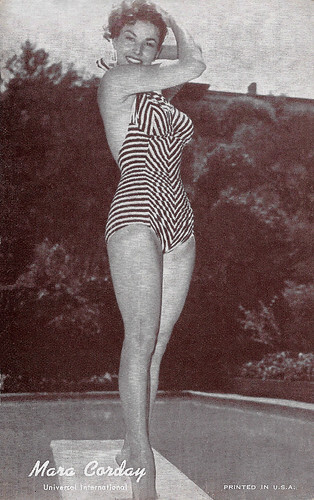
American Arcade card. Photo: Universal International.
American actress Mara Corday (1930) was also a popular showgirl, model and Playboy Playmate of the 1950s.
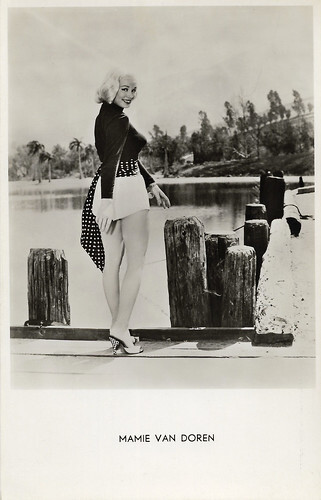
Belgian postcard, no. 96.
Voluptuous American actress Mamie Van Doren (1931) was a sex symbol of the 1950s and 1960s. Van Doren starred in several exploitation films such as Untamed Youth (1957), loaded with rock 'n' roll and juvenile delinquency. Her onscreen wardrobe usually consisted of tight sweaters, low-cut blouses, form-fitting dresses, and daring swimsuits. Mamie and her colleague blonde bombshells Marilyn Monroe and Jayne Mansfield were known as 'The Three M's.'
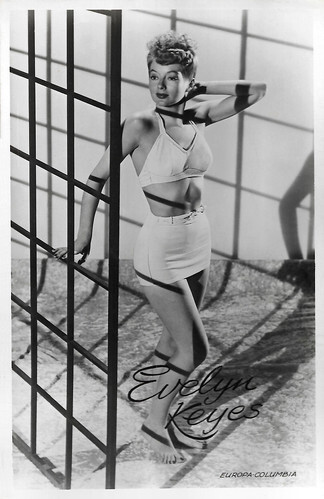
Dutch postcard, no. 3198. Photo: Europa Columbia.
Evelyn Keyes (1916-2008) was an American film actress. She is best known for her role as Suellen O'Hara in Gone with the Wind (1939) and for the female lead in the blockbuster hit The Jolson Story (1946). Her final film was The Seven Year's Itch (1955) starring Marilyn Monroe.
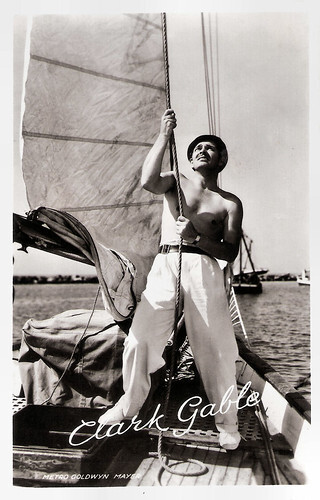
Dutch postcard by Fotoarchief Film en Toneel, no. 3234. Photo: Metro-Goldwyn-Mayer.
With his natural charm and knowing smile, Clark Gable (1901-1959) was 'The King of Hollywood' during the 1930s. He often portrayed down-to-earth, bravado characters with a carefree attitude, and was seen as the epitome of masculinity. Gable won an Academy Award for Best Actor for It Happened One Night (1934), and was nominated for leading roles in Mutiny on the Bounty (1935) and for his best-known role as Rhett Butler in Gone with the Wind (1939).
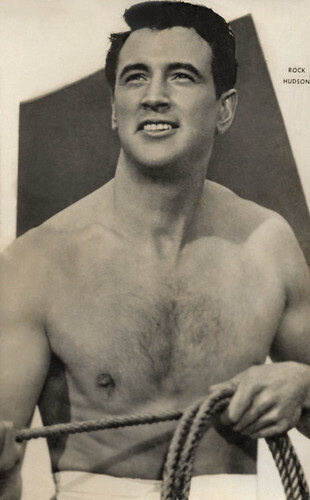
Spanish postcard by Marte. Sent by mail in 1957.
Handsome American actor Rock Hudson (1925–1985) was a popular Hollywood star in the 1950s and 1960s. He was teamed up in romantic comedies with Doris Day, but he also starred in dramatic roles in Magnificent Obsession (1954) and Giant (1956). In later years, he starred on TV in the mystery series McMillan & Wife (1971-1977) and the soap opera Dynasty (1984-1985). Hudson, secretly gay, became in 1985 the first major celebrity who died from an AIDS-related illness.
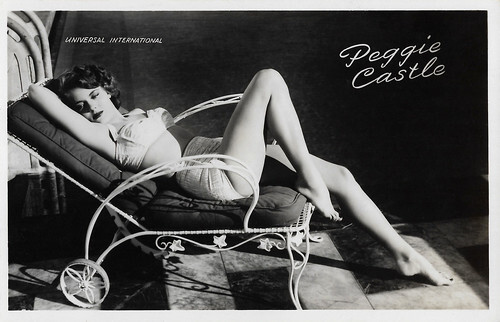
Dutch postcard by Takken, no. 461. Photo: Universal International.
Tall, sultry, green-eyed blonde Peggie Castle (1927-1973) was an American actress who specialised in playing the "other woman" in B-movies. Castle was Miss Cheesecake in 1949.
Arrivederci!

Belgian postcard by Nieuwe Merksemsche Chocolaterie S.P.R.I., Merksem (Anvers / Antwerpen). Photo: M.G.M., 1950.
Blonde, slim Vera-Ellen (1921-1981) was one of the most vivacious and vibrant musical film talents to glide through Hollywood in the 1940s and 1950s. Whether performing solo or dueting with the best male partners of her generation, including Fred Astaire, Gene Kelly, and Donald O'Connor, Vera-Ellen gave life to some of the most extraordinary dance routines ever caught on film. She was a dance sensation in a string of light-hearted but successful films. Vera-Ellen retired from acting in the late 1950s.
English-American actor Peter Lawford (1923-1984), is mainly known as a member of the Rat Pack from which he was later banned due to an argument with Frank Sinatra and as the husband of Patricia Kennedy. Although he was never considered a very important actor, he has played in many famous films. He also appeared frequently on television. He was the first one to kiss Elizabeth Taylor and, according to him, the last one to speak to Marilyn Monroe before she died.

Dutch postcard. Photo: London Films. Publicity still for That Dangerous Age (Gregory Ratoff, 1949).
Darkly handsome British film and television actor Richard Greene (1918-1985) was a matinee idol of the late 1930s who appeared in more than 40 films. He was perhaps best known for the lead role in the long-running British TV series The Adventures of Robin Hood (1955-1960).
Blonde and beautiful Irish actress Peggy Cummins (1925-2017) was unforgettable in the Film Noir classic Gun Crazy (Joseph H. Lewis, 1950) as the trigger-happy femme fatale who robs banks with her lover.

Spanish postcard, no. 454. Photo: Warner Bros.
American actress Ruth Roman (1922–1999) had a memorable role in Alfred Hitchcock's thriller Strangers on a Train (1951).

Italian postcard by Bromostampa, Milano, no. 123.
Va-va-voom singer Abbe Lane (1932) achieved her greatest success as the vocalist for Xavier Cugat's orchestra, but she also appeared in several American and Italian films. The beautiful, curvaceous Lane was nicknamed 'the swingingest sexpot in show business.'

West-German postcard by Rüdel-Verlag, Hamburg-Bergedorf, no. 542. Photo: J. Arthur Rank Organisation. Yvonne de Carlo in Hotel Sahara (Ken Annakin, 1951).
Dark-haired Hollywood beauty Yvonne De Carlo (1922–2007) was a Canadian American actress, singer, and dancer whose career in film, television, and musical theatre spanned six decades. From the 1950s on, she also starred in British and Italian films. She achieved her greatest popularity as the ghoulish matriarch Lily in the TV sitcom The Munsters (1964-1966).

Dutch postcard by Takken, Utrecht, no. 1694. Photo: Metro-Goldwyn-Mayer. Ricardo Montalban takes a few minutes between scenes of Two Weeks with Love (Roy Rowland, 1952) to start a summer tan.

French postcard by A.N., Paris, no. 1256. Photo: Raymond Voinquel.
Handsome and athletic Georges Marchal (1920-1997) was one of the main lead actors in the French cinema of the 1950s, together with Jean Marais. He starred in several costume dramas and Swashbucklers and later appeared in films by Luis Buñuel.

Italian postcard, no. 100 104. Raquel Welch in One Million Years BC (Don Chaffey, 1966).
American actress Raquel Welch (1940) is one of the icons of the 1960s and 1970s. She first won attention for her role in Fantastic Voyage (1966). In Great Britain, she then made One Million Years B.C. (1966). Although she had only three lines in the film, a poster of Welch in a furry prehistoric bikini became an amazing bestseller and catapulted her to stardom.

British postcard by Heroes Publishing LTD, London, no. SPC2610. Pamela Anderson as C.J. Parker in the TV series Baywatch (1992-1997).
Sexy Canadian-American actress and model Pamela Anderson (1967) is best known for the TV series Home Improvement, Baywatch and V.I.P., but the platinum blonde but naturally born brunette also appeared in a dozen of feature films and on a record 14 Playboy covers. Furthermore she is an international celebrity thanks to her rocky marriages, her animal rights activism and her changing bust sizes.

German postcard by Ross Verlag, Berlin, no. 1597/1, 1927-1928. Photo: Ufa.
Ossi Oswalda (1895-1947) was one of the most popular comediennes of German silent cinema.

German postcard by Ross Verlag, no. 4829/1, 1929-1930. Photo: DPG.
Phyllis Haver (1899-1960) was an American actress of the silent film era. With her curvy figure and blonde hair, she started her career as one of the most popular of Mack Sennett's bathing beauties. Haver quickly worked her way up to leading roles and she was signed by Cecil B. De Mille. Among her best roles were Roxy Hart in the first film version of Chicago (1927) and as Shanghai Mabel in What Price Glory? (1927).

American Arcade card. Photo: Universal International.
American actress Mara Corday (1930) was also a popular showgirl, model and Playboy Playmate of the 1950s.

Belgian postcard, no. 96.
Voluptuous American actress Mamie Van Doren (1931) was a sex symbol of the 1950s and 1960s. Van Doren starred in several exploitation films such as Untamed Youth (1957), loaded with rock 'n' roll and juvenile delinquency. Her onscreen wardrobe usually consisted of tight sweaters, low-cut blouses, form-fitting dresses, and daring swimsuits. Mamie and her colleague blonde bombshells Marilyn Monroe and Jayne Mansfield were known as 'The Three M's.'

Dutch postcard, no. 3198. Photo: Europa Columbia.
Evelyn Keyes (1916-2008) was an American film actress. She is best known for her role as Suellen O'Hara in Gone with the Wind (1939) and for the female lead in the blockbuster hit The Jolson Story (1946). Her final film was The Seven Year's Itch (1955) starring Marilyn Monroe.

Dutch postcard by Fotoarchief Film en Toneel, no. 3234. Photo: Metro-Goldwyn-Mayer.
With his natural charm and knowing smile, Clark Gable (1901-1959) was 'The King of Hollywood' during the 1930s. He often portrayed down-to-earth, bravado characters with a carefree attitude, and was seen as the epitome of masculinity. Gable won an Academy Award for Best Actor for It Happened One Night (1934), and was nominated for leading roles in Mutiny on the Bounty (1935) and for his best-known role as Rhett Butler in Gone with the Wind (1939).

Spanish postcard by Marte. Sent by mail in 1957.
Handsome American actor Rock Hudson (1925–1985) was a popular Hollywood star in the 1950s and 1960s. He was teamed up in romantic comedies with Doris Day, but he also starred in dramatic roles in Magnificent Obsession (1954) and Giant (1956). In later years, he starred on TV in the mystery series McMillan & Wife (1971-1977) and the soap opera Dynasty (1984-1985). Hudson, secretly gay, became in 1985 the first major celebrity who died from an AIDS-related illness.

Dutch postcard by Takken, no. 461. Photo: Universal International.
Tall, sultry, green-eyed blonde Peggie Castle (1927-1973) was an American actress who specialised in playing the "other woman" in B-movies. Castle was Miss Cheesecake in 1949.
Arrivederci!
Published on June 23, 2022 22:00
June 22, 2022
Fern Andra
In film history, Hollywood often lured away talent from Europe, but there are also examples of the contrary. Like 'modern' American actress Fern Andra (1893-1974) who became one of the most popular film stars of the German cinema in the 1910s and early 1920s. In her films she mastered tight roping, riding horses without a saddle, driving cars and motorcycles, bobsleighing, and even boxing.
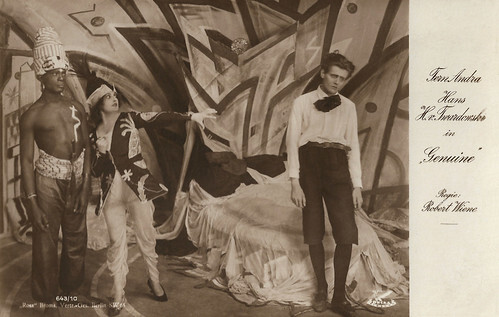
German postcard by Ross Verlag, no. 643/10. Photo: Decla. Fern Andra and Hans Heinrich von Twardowski in Genuine (Robert Wiene, 1920).
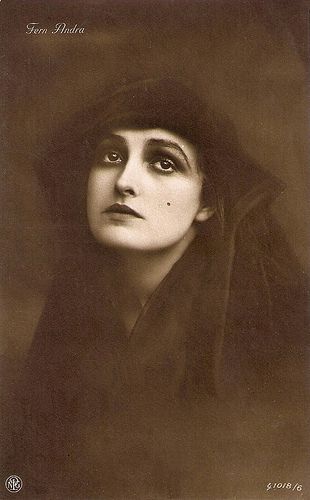
German postcard by Neue Photographische Gesellschaft (NPG), no. 1018/6.
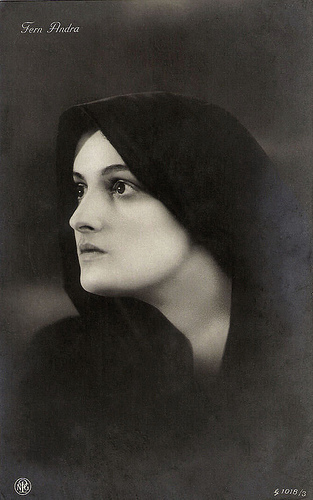
German postcard by NPG, no. G 1018/3.
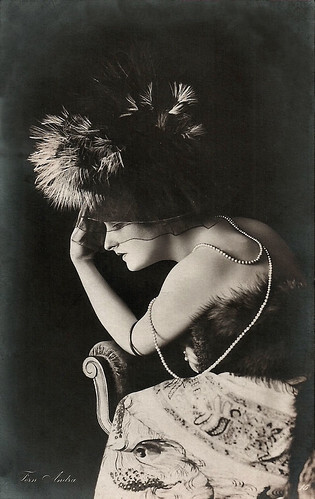
German postcard by Deutsche Gaumont-Gesellschaft, Berlin, no. 15. Photo: Fern Andra Atelier.
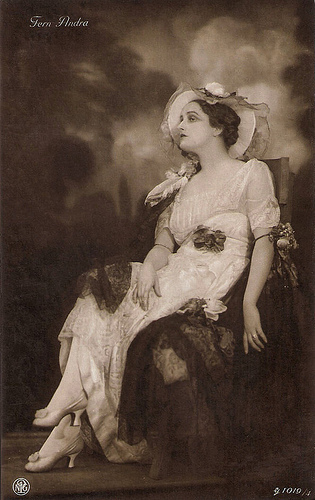
German postcard by NPG, no. G 1019/4.
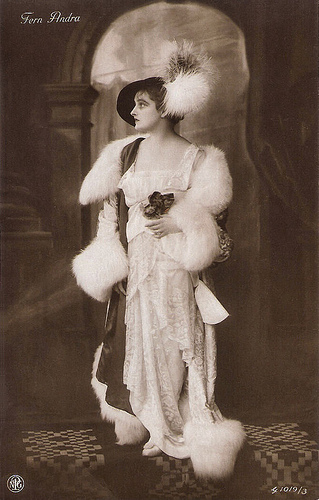
German postcard by NPG, no. G 1019/3.
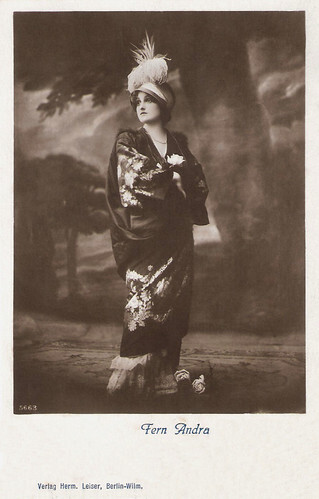
German postcard by Verlag Hermann Leiser, Berlin, no. 2226.
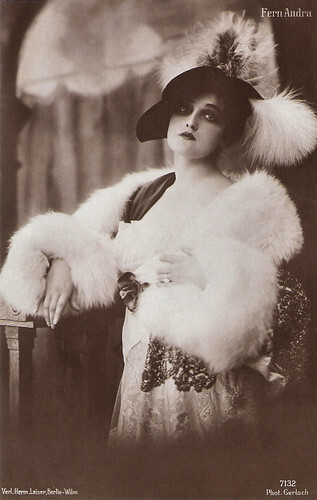
German postcard by Verlag Hermann Leiser, no. 7132. Photo: Gerlach.
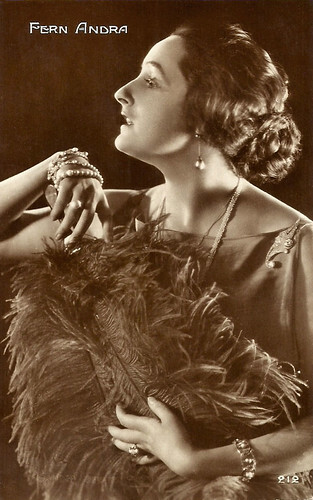
French postcard by Ed. Cinémagazine, no. 212.
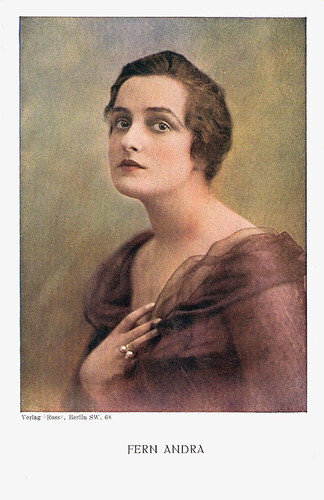
German postcard by Ross Verlag, Berlin.
Circus Dancer
Fern Andra was born as Vernal Edna Andrews in Watseka, Illinois, USA, in 1893. She was the daughter of William P. Andrews and Sarah Emily Evett, also known as Sadie.
When William died in 1898, Sadie remarried Frank St. Clair, a vaudeville actor, circus performer and tight-rope walker. Andra was already appearing in public in a tightrope act by the age of four. She later trained in song and dance. Wikipedia mentions that she made her first film in New York in 1899, a version of Uncle Tom's Cabin, but IMDb does not mention this production, and Hans Michael Bock at Filmportal writes that it was her stage debut.
However, she remained with the circus, with which she embarked on an extensive tour across the United States, Canada and Europe. For a time, she was a member of Bird Millman's acclaimed troupe of wire artists. In London, she became an outrageous ballerina at the Ragtime Revue. In Vienna, she became a student of famed director-teacher Max Reinhardt and appeared in several of his plays and films.
In Berlin, French film director Charles Decroix convinced her to start a career in film. He launched her as André Fern, competing with the leading German stars of those days: Asta Nielsen and Henny Porten. In 1913, aged 19, she appeared in her first German film, Das Ave Maria/The Ave Maria (Charles Decroix, 1913).
Equipped with her aquiline nose, ephebic little body and malicious eyes, Fern showed in short films like Der Stern/The Star (Charles Decroix, 1914) and Ernst ist das Leben/Life is Serious (Fern Andra, 1916), that she possessed a completely 'modern' repertory. Still only moderately well known, she made her only Austrian film in 1915: Zwei Freunde/Two Friends.
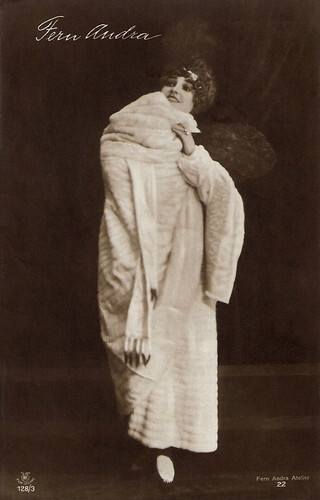
German postcard by Rotophot, Berlin, in the Film Sterne Series, no. 128/3. Photo: Fern Andra Atelier.
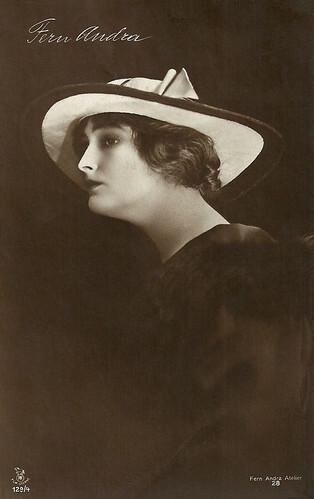
German postcard by Rotophot in the Film-Sterne series, no. 129/4. Photo: Fern Andra Atelier 28.
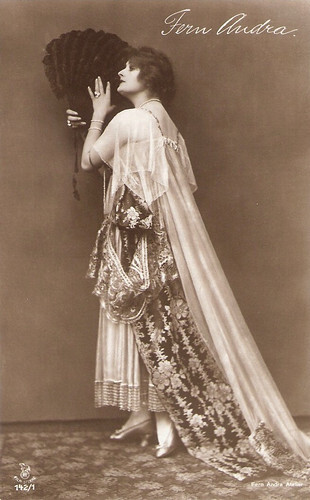
German postcard by Rotophot in the Film Sterne series, no. 142/1. Photo: Fern Andra Atelier.
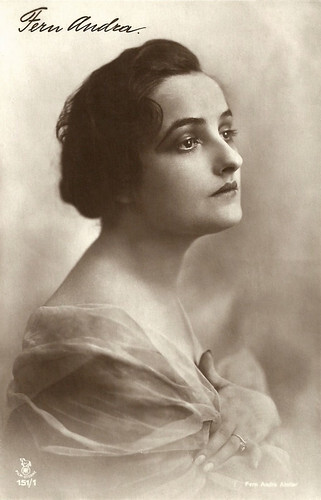
German postcard by Rotophot in the Film-Sterne series, no. 151/1. Photo: Fern Andra Atelier.
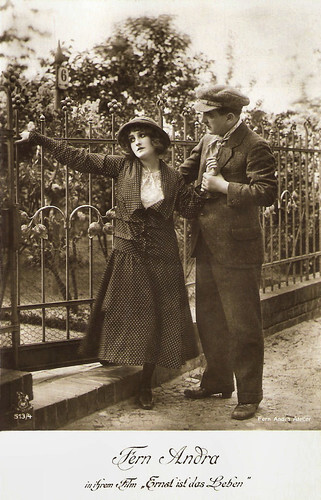
German postcard by Rotophot in the Film Sterne series, no. 513/4. Photo: Fern Andra Atelier. Still from Ernst ist das Leben/Life is Serious (Fern Andra, 1916). The actor is probably Fritz Delius. This card was sent to us by Gill4kleuren (Many thanks, Gill!).
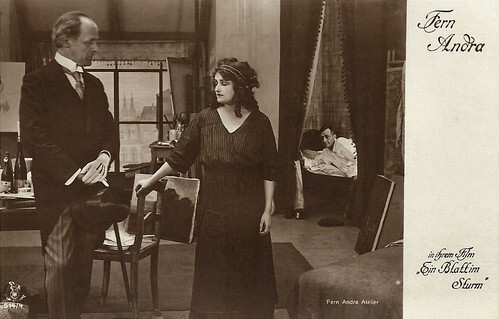
German postcard by Rotophot in the Film-Sterne series, no. 514/4. Photo: Fern Andra Atelier. Fern Andra and (in the back) Alfred Abel in the film Ein Blatt im Sturm... doch das Schicksal hat es verweht (Fern Andra, 1917).
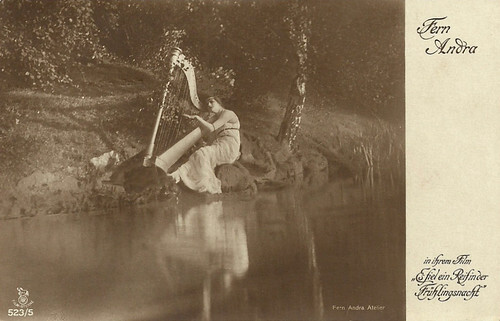
German postcard by Rotophot in the Film-Sterne series, no. 523/5. Photo: Fern Andra Atelier. Fern Andra in Es fiel ein Reif in der Frühlingsnacht (Fern Andra, Kurt Matull, 1915).
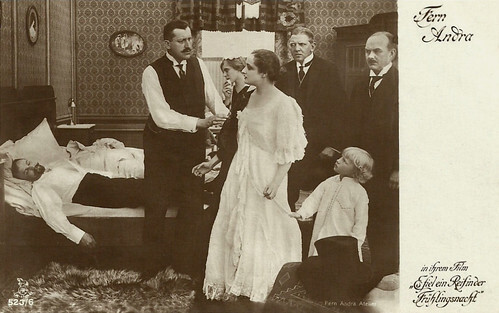
German postcard by Rotophot in the Film-Sterne series, no. 523/6. Photo: Fern Andra Atelier. Fern Andra in Es fiel ein Reif in der Frühlingsnacht (Fern Andra, Kurt Matull, 1915).
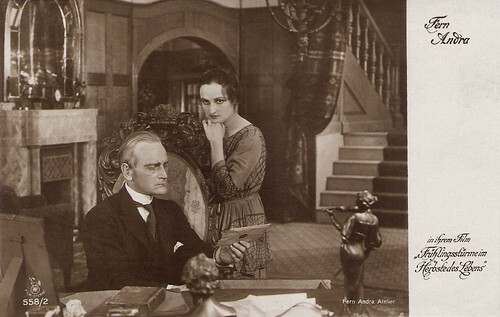
German postcard by Rotophot in the Film Sterne series, no. 558/2. Photo: Fern Andra Atelier. Still from Frühlingsstürme im Herbste des Lebens/Spring Storms (Fern Andra, 1918).
Victims of cruel events
After 4 or 5 of these films, André Fern left audiences breathless over so much defiance. She changed her name definitely into Fern Andra and started her own company, even directing her own films. Georg Glen was the manager of Fern Andra Atelier. The company produced more than 80 films during World War I.
When the USA entered World War I, Fern Andra became looked upon as an enemy and was suspected by Germany to be a spy because she was born in the USA. In order to make an end to these rumors she got married with the Prussian Baron Friedrich von und zu Weichs-Zur-Wenne who was killed in the war a short time later.
Right during the First World War, Fern made one film after another, always about women who are victims of cruel events but who are also determined to settle matters. From 1916 to 1918 she appeared almost exclusively on camera with Alfred Abel. She appeared mainly in sentimental dramas, but also impressed with artistic performances in circus films. The new star created a sensation by mastering tight roping, riding horses without a saddle, driving cars, motorcycles, slalom, bobsleighing, and even boxing.
Moonlight romance, theatres burning down, and luxurious parties in aristocratic milieux. Unfortunately, most of these films were never exported because of the war, and most are lost now. Her films included Eine Motte floh zum Licht/A Moth Flew To The Light (Fern Andra, 1915), Frühlingsstürme im Herbste des Lebens/Spring Storms (Fern Andra, 1918) and Drohende Wolken am Firmament/Threatening Clouds in the Sky (Fern Andra, 1918).
In 1919 she published a novel entitled 'Der Weg, der ins Glashaus führte. Roman eines Frauenlebens', followed in 1920 by an autobiography entitled 'Was ich über mich zu sagen weiss'. Fern Andra was also aware of how to promote her movies and herself. She was so to speak a pioneer of "Making-Of" trailers in which she reported about accidents during the shooting and the work behind the scenes.
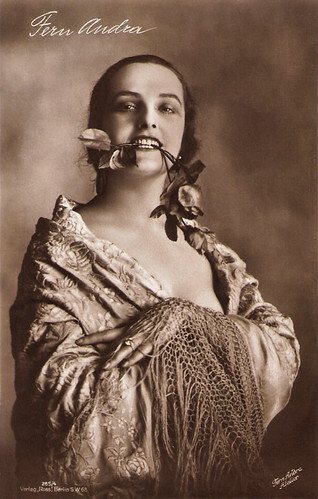
German postcard by Ross Verlag, no. 185/4. Photo: Fern Andra Atelier.
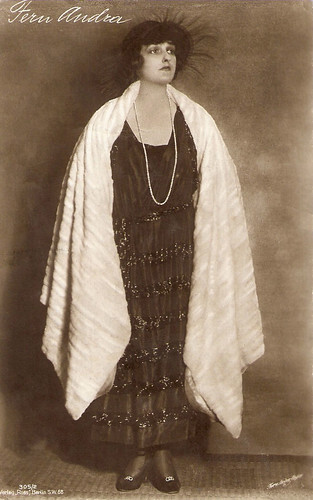
German postcard by Ross Verlag, Berlin. Photo: Fern-Andra-Atelier.
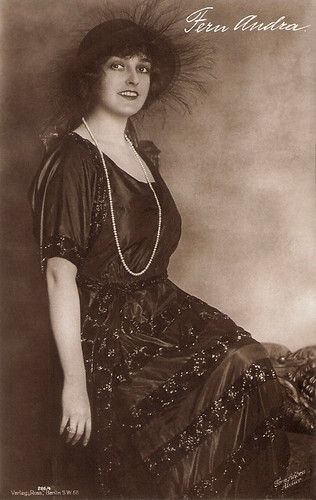
German postcard by Ross Verlag, Berlin, no. 286/4, 1919-1924. Photo: Fern Andra Atelier.
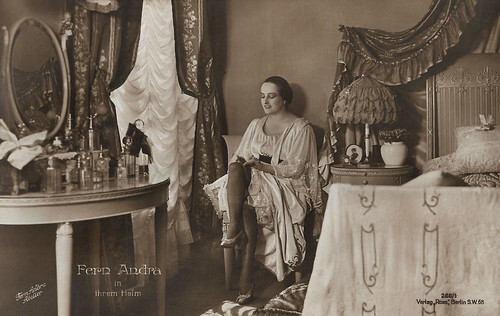
German postcard by Verlag Ross, Berlin / Rotophot, no. 288/1, 1919-1924. Photo: Fern Andra Atelier. Caption: Fern Andra at home. This is one of the few postcards which contains both references to Verlag Ross (front side) and to the Film Sterne series by Rotophot (flip side). Heinrich worked for Rotophot but in 1919, he founded the postcard company that bore his name, Ross Verlag (originally Verlag Ross). In the beginning, Verlag Ross operated as a distributor of postcards but soon became a publisher.
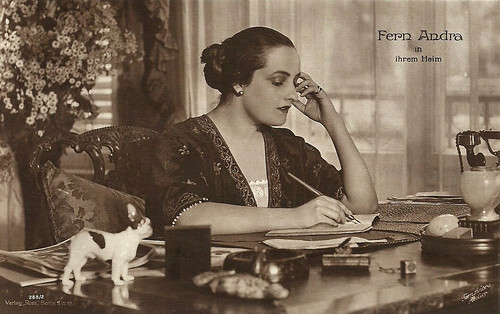
German postcard by Ross Verlag, Berlin, no. 288/2, 1919-1924. Fern Andra Atelier. Caption: Fern Andra in ihrem Heim (Fern Andra at her home).
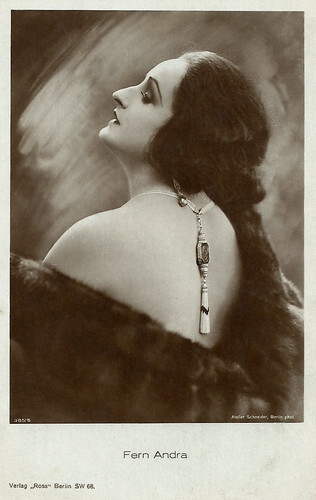
German postcard by Ross Verlag, no. 385/5, 1919-1924. Photo: Atelier Schneider, Berlin.
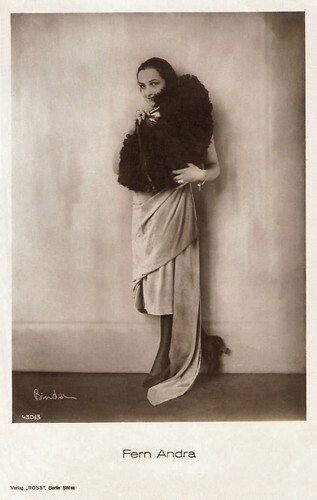
German postcard by Ross Verlag, no. 430/3, 1919-1924. Photo: Alex Binder.
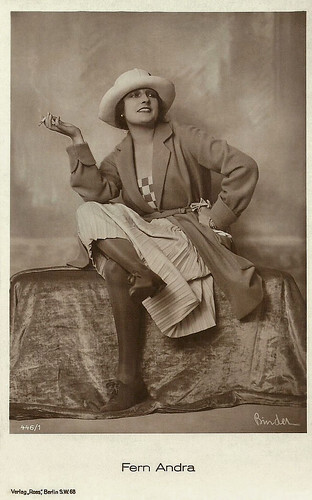
German postcard by Ross Verlag, Berlin, no. 446/1, 1919-1924. Photo: Alex Binder.
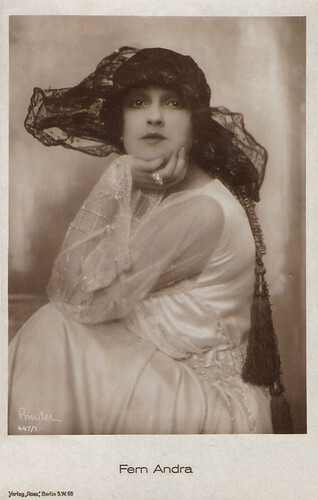
German postcard by Ross Verlag, Berlin, no. 447/1, 1919-1924. Photo Alex Binder.
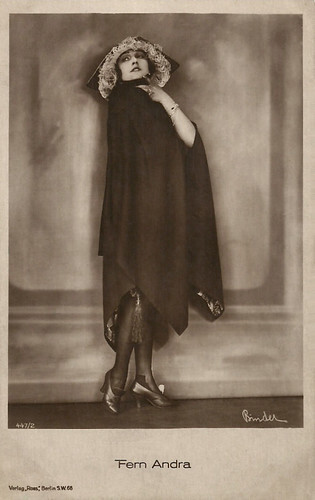
German postcard by Ross Verlag, Berlin, no. 447/2, 1919-1924. Photo: Alex Binder.
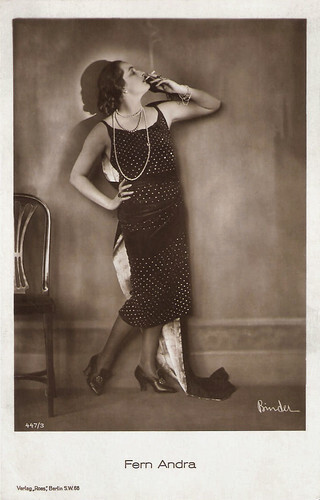
German postcard by Ross Verlag, Berlin, no. 447/3, 1919-1924. Photo: Alex Binder.
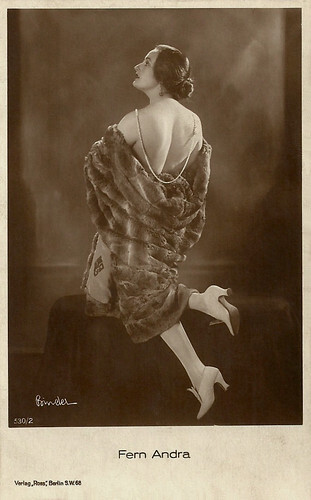
German postcard by Ross Verlag, Berlin, no. 530/2, 1919-1924. Photo: Alex Binder.
Mysterious Priest
In the early 1920s, Fern Andra's films became more sophisticated. She left direction to directors such as Robert Wiene. He directed her in Genuine (Robert Wiene, 1920), probably her best interpretation. Her Genuine is a vamp who uses her powers of seduction to torment and control the men who love her.
Wiene created Genuine as a follow-up to his massively successful film Das Cabinet des Dr. Caligari/The Cabinet of Dr. Caligari (1920), using the same writer, Carl Mayer, and cinematographer, Willy Hameister, who had worked on the earlier film. Production designer César Klein even returned to contribute his bizarre Caligari-like imagery to the film.
Andra's costumes in this film, specially designed for her by Klein, turned her mysterious priest of some cult into one of the most stylised characters of German expressionism. According to IMDb , he infuriated great arousal with an on her body painted costume by César Klein. However, the film did not do well at the box office.
On 4 July 1922, she was involved in the Hamburg-Berlin mail plane accident when the plane experienced engine failure and crashed. The pilot, Lothar von Richthofen, the younger brother of World War I flying ace Manfred von Richthofen (the Red Baron), was killed. Andra was initially misreported as dead but survived. Her companion, director Georg Bluen, also survived and continued working with her until 1925.
After a role as a femme fatale opposite the Italian apache Za-la-Mort (Emilio Ghione), in Der Traum der Za-la-Vie/The Dream of Za-la-Vie (Emilio Ghione, 1924), she said farewell to the German cinema with Frauen der Leidenschaft/Women of Passion (Rolf Randolf, 1926) in which she played Cléo de Mérode, and the comedy Funkzauber/Radio Magic (Richard Oswald, 1927) starring Werner Krauss and Xenia Desni .
In 1924, Fern Andra married the middleweight boxer Kurt Prenzel. The couple went to London where she made a few more films, including the drama Spangles (George Banfield, 1928). Then she moved to Hollywood, where she only made two films, the pre-Code dramas The Eyes of the World (Henry King, 1930) and Lotus Lady (Phil Rosen, 1930). Andra's activities on stage included acting at the Hollywood Playhouse in the 1930s. She also founded the Windsor Theater in Los Angeles. Her final stage appearance came in 1936.
Fern Andra was married four times. Her first husband was Baron Friedrich von und zu Weichs-Zur-Wenne. The marriage ended with his death in 1917. After her marriage to Kurt Prenzel had ended in a divorce, she was the wife of American film actor Ian Keith from 1934 to 1935. Her final husband was Gen. Samuel Edge Dockrell, from 1938 till his death in 1973. All of her unions were childless.
Fern Andra died in Aiken, South Carolina, in 1974, aged 80. She was interred at Cedar Hill Cemetery in Hartford, Connecticut.
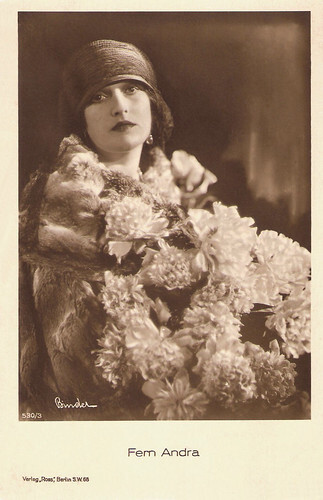
German postcard by Ross Verlag, no. 530/3, 1919-1924. Photo: Atelier Binder.
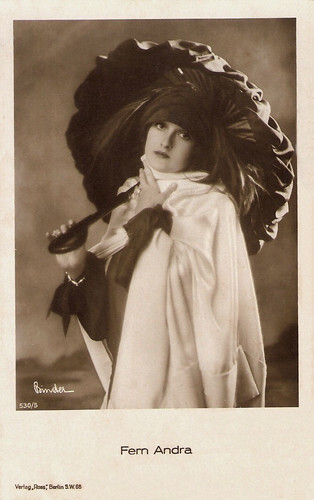
German postcard by Ross Verlag, Berlin, no. 530/5, 1919-1924. Photo: Alex Binder.
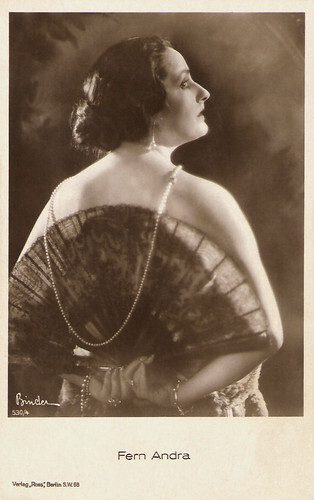
German postcard by Ross Verlag, Berlin, no. 530/4, 1919-1924. Photo: Alex Binder, Berlin.
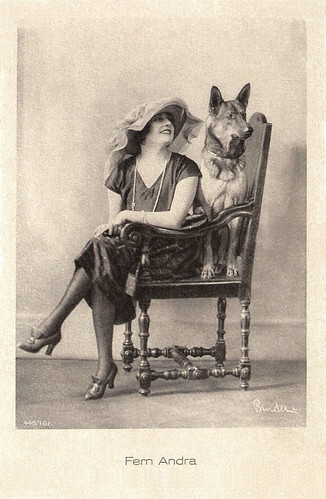
German postcard by Ross Verlag, Berlin, no. 445/1 gr., 1919-1924 Photo: Alex Binder.
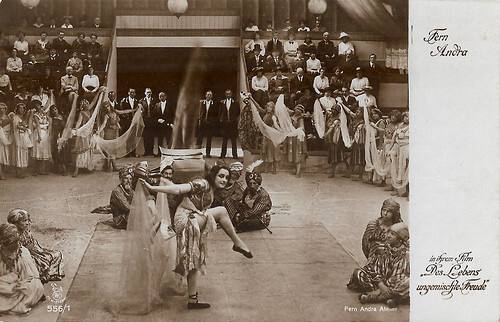
German postcard in the Film-Sterne series by Rotophot, no. 556/1. Photo: Fern-Andra-Atelier. Fern Andra in Des Lebens ungemischte Freude/Unmixed joy of life (Fern Andra, 1917).
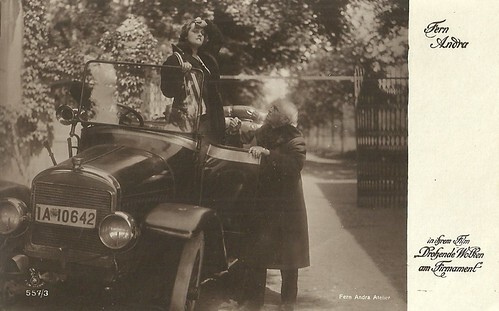
German postcard in the Film-Sterne series by Rotophot, no. 557/3. Photo: Fern-Andra-Atelier. Fern Andra in Drohende Wolken am Firmament/Threatening clouds in the sky (Fern Andra, 1918), scripted by Fern Andra.
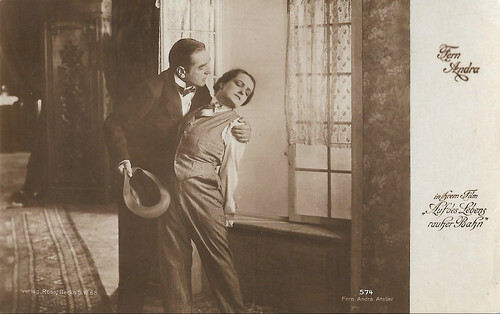
German postcard by Ross Verlag, no. 574. Photo: Fern-Andra-Atelier. Fern Andra and possibly Heinrich Braun in Auf des Lebens rauer Bahn/On the rough road of life (Georg Bluen, 1918).
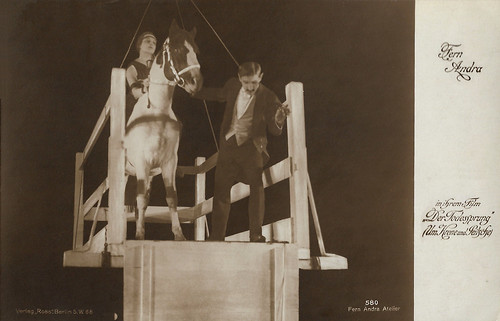
German postcard by Ross Verlag, no. 580. Photo: Fern-Andra-Atelier. Fern Andra in Der Todessprung/Um Krone und Peitsche/Crown and Whip (Georg Bluen, Fern Andra, 1919).
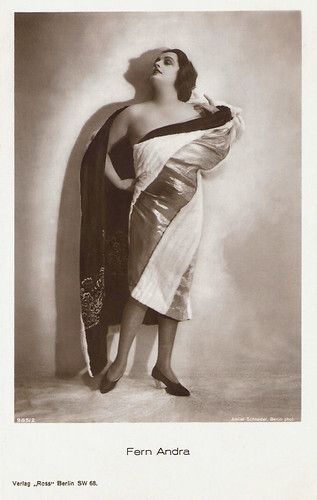
German postcard by Ross Verlag, Berlin, no. 982/2, 1925-1926. Photo: Atelier Schneider, Berlin.
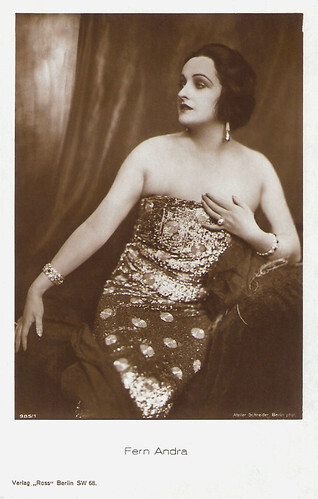
German postcard by Ross Verlag, Berlin, no. 985/1, 1925-1926. Photo: Atelier Schneider, Berlin.
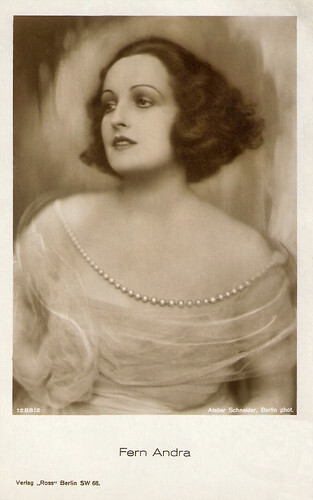
German postcard by Ross Verlag, Berlin, no. 1288/2, 1927-1928. Photo: Atelier Schneider, Berlin.
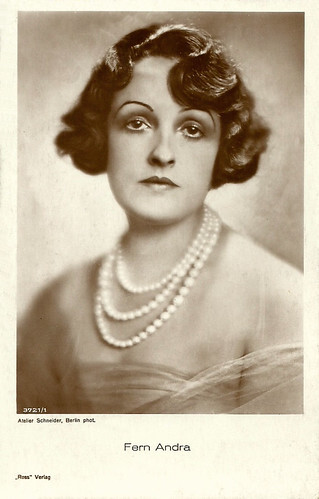
German postcard. Ross Verlag, no. 3721/1, 1928-1929. Photo: Atelier Schneider, Berlin.
Sources: Hans Michael Bock (Filmportal.de - German), Vittorio Martinelli (Le dive del silenzio) (Italian), Wikipedia (English and German) and .

German postcard by Ross Verlag, no. 643/10. Photo: Decla. Fern Andra and Hans Heinrich von Twardowski in Genuine (Robert Wiene, 1920).

German postcard by Neue Photographische Gesellschaft (NPG), no. 1018/6.

German postcard by NPG, no. G 1018/3.

German postcard by Deutsche Gaumont-Gesellschaft, Berlin, no. 15. Photo: Fern Andra Atelier.

German postcard by NPG, no. G 1019/4.

German postcard by NPG, no. G 1019/3.

German postcard by Verlag Hermann Leiser, Berlin, no. 2226.

German postcard by Verlag Hermann Leiser, no. 7132. Photo: Gerlach.

French postcard by Ed. Cinémagazine, no. 212.

German postcard by Ross Verlag, Berlin.
Circus Dancer
Fern Andra was born as Vernal Edna Andrews in Watseka, Illinois, USA, in 1893. She was the daughter of William P. Andrews and Sarah Emily Evett, also known as Sadie.
When William died in 1898, Sadie remarried Frank St. Clair, a vaudeville actor, circus performer and tight-rope walker. Andra was already appearing in public in a tightrope act by the age of four. She later trained in song and dance. Wikipedia mentions that she made her first film in New York in 1899, a version of Uncle Tom's Cabin, but IMDb does not mention this production, and Hans Michael Bock at Filmportal writes that it was her stage debut.
However, she remained with the circus, with which she embarked on an extensive tour across the United States, Canada and Europe. For a time, she was a member of Bird Millman's acclaimed troupe of wire artists. In London, she became an outrageous ballerina at the Ragtime Revue. In Vienna, she became a student of famed director-teacher Max Reinhardt and appeared in several of his plays and films.
In Berlin, French film director Charles Decroix convinced her to start a career in film. He launched her as André Fern, competing with the leading German stars of those days: Asta Nielsen and Henny Porten. In 1913, aged 19, she appeared in her first German film, Das Ave Maria/The Ave Maria (Charles Decroix, 1913).
Equipped with her aquiline nose, ephebic little body and malicious eyes, Fern showed in short films like Der Stern/The Star (Charles Decroix, 1914) and Ernst ist das Leben/Life is Serious (Fern Andra, 1916), that she possessed a completely 'modern' repertory. Still only moderately well known, she made her only Austrian film in 1915: Zwei Freunde/Two Friends.

German postcard by Rotophot, Berlin, in the Film Sterne Series, no. 128/3. Photo: Fern Andra Atelier.

German postcard by Rotophot in the Film-Sterne series, no. 129/4. Photo: Fern Andra Atelier 28.

German postcard by Rotophot in the Film Sterne series, no. 142/1. Photo: Fern Andra Atelier.

German postcard by Rotophot in the Film-Sterne series, no. 151/1. Photo: Fern Andra Atelier.

German postcard by Rotophot in the Film Sterne series, no. 513/4. Photo: Fern Andra Atelier. Still from Ernst ist das Leben/Life is Serious (Fern Andra, 1916). The actor is probably Fritz Delius. This card was sent to us by Gill4kleuren (Many thanks, Gill!).

German postcard by Rotophot in the Film-Sterne series, no. 514/4. Photo: Fern Andra Atelier. Fern Andra and (in the back) Alfred Abel in the film Ein Blatt im Sturm... doch das Schicksal hat es verweht (Fern Andra, 1917).

German postcard by Rotophot in the Film-Sterne series, no. 523/5. Photo: Fern Andra Atelier. Fern Andra in Es fiel ein Reif in der Frühlingsnacht (Fern Andra, Kurt Matull, 1915).

German postcard by Rotophot in the Film-Sterne series, no. 523/6. Photo: Fern Andra Atelier. Fern Andra in Es fiel ein Reif in der Frühlingsnacht (Fern Andra, Kurt Matull, 1915).

German postcard by Rotophot in the Film Sterne series, no. 558/2. Photo: Fern Andra Atelier. Still from Frühlingsstürme im Herbste des Lebens/Spring Storms (Fern Andra, 1918).
Victims of cruel events
After 4 or 5 of these films, André Fern left audiences breathless over so much defiance. She changed her name definitely into Fern Andra and started her own company, even directing her own films. Georg Glen was the manager of Fern Andra Atelier. The company produced more than 80 films during World War I.
When the USA entered World War I, Fern Andra became looked upon as an enemy and was suspected by Germany to be a spy because she was born in the USA. In order to make an end to these rumors she got married with the Prussian Baron Friedrich von und zu Weichs-Zur-Wenne who was killed in the war a short time later.
Right during the First World War, Fern made one film after another, always about women who are victims of cruel events but who are also determined to settle matters. From 1916 to 1918 she appeared almost exclusively on camera with Alfred Abel. She appeared mainly in sentimental dramas, but also impressed with artistic performances in circus films. The new star created a sensation by mastering tight roping, riding horses without a saddle, driving cars, motorcycles, slalom, bobsleighing, and even boxing.
Moonlight romance, theatres burning down, and luxurious parties in aristocratic milieux. Unfortunately, most of these films were never exported because of the war, and most are lost now. Her films included Eine Motte floh zum Licht/A Moth Flew To The Light (Fern Andra, 1915), Frühlingsstürme im Herbste des Lebens/Spring Storms (Fern Andra, 1918) and Drohende Wolken am Firmament/Threatening Clouds in the Sky (Fern Andra, 1918).
In 1919 she published a novel entitled 'Der Weg, der ins Glashaus führte. Roman eines Frauenlebens', followed in 1920 by an autobiography entitled 'Was ich über mich zu sagen weiss'. Fern Andra was also aware of how to promote her movies and herself. She was so to speak a pioneer of "Making-Of" trailers in which she reported about accidents during the shooting and the work behind the scenes.

German postcard by Ross Verlag, no. 185/4. Photo: Fern Andra Atelier.

German postcard by Ross Verlag, Berlin. Photo: Fern-Andra-Atelier.

German postcard by Ross Verlag, Berlin, no. 286/4, 1919-1924. Photo: Fern Andra Atelier.

German postcard by Verlag Ross, Berlin / Rotophot, no. 288/1, 1919-1924. Photo: Fern Andra Atelier. Caption: Fern Andra at home. This is one of the few postcards which contains both references to Verlag Ross (front side) and to the Film Sterne series by Rotophot (flip side). Heinrich worked for Rotophot but in 1919, he founded the postcard company that bore his name, Ross Verlag (originally Verlag Ross). In the beginning, Verlag Ross operated as a distributor of postcards but soon became a publisher.

German postcard by Ross Verlag, Berlin, no. 288/2, 1919-1924. Fern Andra Atelier. Caption: Fern Andra in ihrem Heim (Fern Andra at her home).

German postcard by Ross Verlag, no. 385/5, 1919-1924. Photo: Atelier Schneider, Berlin.

German postcard by Ross Verlag, no. 430/3, 1919-1924. Photo: Alex Binder.

German postcard by Ross Verlag, Berlin, no. 446/1, 1919-1924. Photo: Alex Binder.

German postcard by Ross Verlag, Berlin, no. 447/1, 1919-1924. Photo Alex Binder.

German postcard by Ross Verlag, Berlin, no. 447/2, 1919-1924. Photo: Alex Binder.

German postcard by Ross Verlag, Berlin, no. 447/3, 1919-1924. Photo: Alex Binder.

German postcard by Ross Verlag, Berlin, no. 530/2, 1919-1924. Photo: Alex Binder.
Mysterious Priest
In the early 1920s, Fern Andra's films became more sophisticated. She left direction to directors such as Robert Wiene. He directed her in Genuine (Robert Wiene, 1920), probably her best interpretation. Her Genuine is a vamp who uses her powers of seduction to torment and control the men who love her.
Wiene created Genuine as a follow-up to his massively successful film Das Cabinet des Dr. Caligari/The Cabinet of Dr. Caligari (1920), using the same writer, Carl Mayer, and cinematographer, Willy Hameister, who had worked on the earlier film. Production designer César Klein even returned to contribute his bizarre Caligari-like imagery to the film.
Andra's costumes in this film, specially designed for her by Klein, turned her mysterious priest of some cult into one of the most stylised characters of German expressionism. According to IMDb , he infuriated great arousal with an on her body painted costume by César Klein. However, the film did not do well at the box office.
On 4 July 1922, she was involved in the Hamburg-Berlin mail plane accident when the plane experienced engine failure and crashed. The pilot, Lothar von Richthofen, the younger brother of World War I flying ace Manfred von Richthofen (the Red Baron), was killed. Andra was initially misreported as dead but survived. Her companion, director Georg Bluen, also survived and continued working with her until 1925.
After a role as a femme fatale opposite the Italian apache Za-la-Mort (Emilio Ghione), in Der Traum der Za-la-Vie/The Dream of Za-la-Vie (Emilio Ghione, 1924), she said farewell to the German cinema with Frauen der Leidenschaft/Women of Passion (Rolf Randolf, 1926) in which she played Cléo de Mérode, and the comedy Funkzauber/Radio Magic (Richard Oswald, 1927) starring Werner Krauss and Xenia Desni .
In 1924, Fern Andra married the middleweight boxer Kurt Prenzel. The couple went to London where she made a few more films, including the drama Spangles (George Banfield, 1928). Then she moved to Hollywood, where she only made two films, the pre-Code dramas The Eyes of the World (Henry King, 1930) and Lotus Lady (Phil Rosen, 1930). Andra's activities on stage included acting at the Hollywood Playhouse in the 1930s. She also founded the Windsor Theater in Los Angeles. Her final stage appearance came in 1936.
Fern Andra was married four times. Her first husband was Baron Friedrich von und zu Weichs-Zur-Wenne. The marriage ended with his death in 1917. After her marriage to Kurt Prenzel had ended in a divorce, she was the wife of American film actor Ian Keith from 1934 to 1935. Her final husband was Gen. Samuel Edge Dockrell, from 1938 till his death in 1973. All of her unions were childless.
Fern Andra died in Aiken, South Carolina, in 1974, aged 80. She was interred at Cedar Hill Cemetery in Hartford, Connecticut.

German postcard by Ross Verlag, no. 530/3, 1919-1924. Photo: Atelier Binder.

German postcard by Ross Verlag, Berlin, no. 530/5, 1919-1924. Photo: Alex Binder.

German postcard by Ross Verlag, Berlin, no. 530/4, 1919-1924. Photo: Alex Binder, Berlin.

German postcard by Ross Verlag, Berlin, no. 445/1 gr., 1919-1924 Photo: Alex Binder.

German postcard in the Film-Sterne series by Rotophot, no. 556/1. Photo: Fern-Andra-Atelier. Fern Andra in Des Lebens ungemischte Freude/Unmixed joy of life (Fern Andra, 1917).

German postcard in the Film-Sterne series by Rotophot, no. 557/3. Photo: Fern-Andra-Atelier. Fern Andra in Drohende Wolken am Firmament/Threatening clouds in the sky (Fern Andra, 1918), scripted by Fern Andra.

German postcard by Ross Verlag, no. 574. Photo: Fern-Andra-Atelier. Fern Andra and possibly Heinrich Braun in Auf des Lebens rauer Bahn/On the rough road of life (Georg Bluen, 1918).

German postcard by Ross Verlag, no. 580. Photo: Fern-Andra-Atelier. Fern Andra in Der Todessprung/Um Krone und Peitsche/Crown and Whip (Georg Bluen, Fern Andra, 1919).

German postcard by Ross Verlag, Berlin, no. 982/2, 1925-1926. Photo: Atelier Schneider, Berlin.

German postcard by Ross Verlag, Berlin, no. 985/1, 1925-1926. Photo: Atelier Schneider, Berlin.

German postcard by Ross Verlag, Berlin, no. 1288/2, 1927-1928. Photo: Atelier Schneider, Berlin.

German postcard. Ross Verlag, no. 3721/1, 1928-1929. Photo: Atelier Schneider, Berlin.
Sources: Hans Michael Bock (Filmportal.de - German), Vittorio Martinelli (Le dive del silenzio) (Italian), Wikipedia (English and German) and .
Published on June 22, 2022 22:00
June 21, 2022
Le Hussard sur le toit (1995)
Le hussard sur le toit/The Horseman on the Roof (1995) is a French film directed by Jean-Paul Rappeneau and starring Juliette Binoche and Olivier Martinez. Based on the 1951 French novel 'Le hussard sur le toit' by Jean Giono, the film follows the adventures of a young Italian nobleman in France raising money for the Italian revolution against Austria during a time of cholera. The Italian struggle for independence and the cholera pandemic in southern France in 1832 are historical events. The film received César Awards in 1996 for Best Cinematography and Best Sound, as well as eight César Award nominations for Best Film, Best Costume Design, Best Actress (Binoche), Best Director, Best Editing, Best Music, Best Production Design, and Most Promising Actress (Isabelle Carré).
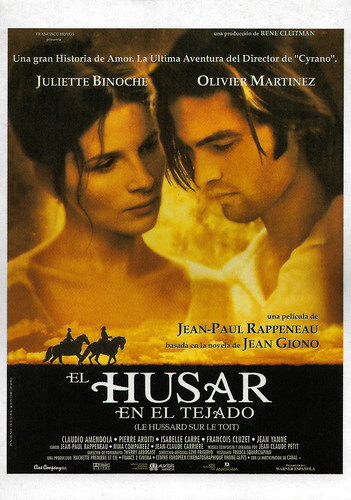
Spanish postcard by Memory Card, no 324. Image: Warner Espanola. Spanish poster of Juliette Binoche and Olivier Martinez in Le hussard sur le toit/The Horseman on the Roof (Jean-Paul Rappeneau, 1995). Spanish title is 'El husar en el tejado'.

Danish postcard by Go Card, no. 2194, 1996. Photo: Camera Film. Juliette Binoche and Olivier Martinez in Le hussard sur le toit/The Horseman on the Roof (Jean-Paul Rappeneau, 1995).
A young Italian nobleman in France raising money for the Italian revolution
In 1832, cholera ravages Provence (South of France). Italian patriots hiding out in Aix, France, are betrayed by one of their own, and Austrian agents are on their trail. One patriot, Giacomo, is dragged away and executed. His wife runs off to warn their friend, Angelo Pardi (Olivier Martinez), a young Italian nobleman in France raising money for the Italian revolution against the Austrian Empire. As the agents descend on his apartment, Angelo escapes into the countryside.
At Meyrargues, Angelo looks for his compatriot and childhood friend, Maggionari, and then continues on to another village, where he writes to his mother, "Always fleeing. When can I fight and show what your son can do?" His mother purchased his commission as a colonel in the Piedmont Hussars, and he's never seen battle. Angelo encounters Maggionari, who turns out to be the traitor. When the Austrian agents arrive, Angelo fights them off and escapes.
The next day, Angelo enters a village ravaged by a cholera epidemic. The sight of the corpses abandoned to the scavenging crows sickens him. He meets a country physician, who shows him how to treat cholera victims by vigorously rubbing alcohol on the skin. Angelo continues north, passing a small village where corpses are being burned. He meets a young woman and two children and accompanies them to the outskirts of Manosque. The young woman, who is a tutor and lover of books, gives him a copy of 'Rinaldo and Armida' as a parting gift.
While in Manosque, Angelo is captured by a paranoid mob who accuse him of poisoning the town fountain. He is taken to the authorities, who soon abandon their posts in fear. Angelo searches for a compatriot but encounters the Austrian agents. Angelo eludes them, and with a sword in hand, fights his way through the hysterical mob and escapes across the rooftops. From his refuge above the town, Angelo watches one of the agents chased down and beaten to death, and later watches the piles of corpses being burned in the night.
To escape the rain, Angelo enters a dwelling where he is discovered by Countess Pauline de Théus ( Juliette Binoche ). Apologising for his presence, Angelo reassures her that he is a gentleman. Pauline offers him food and drink, and soon he falls asleep from exhaustion. The following morning, Pauline is gone and Angelo joins the forced evacuation of the town. In the hills outside Manosque, Angelo meets his compatriot, Giuseppe, who possesses money raised for the Italian resistance, but which cannot now be delivered because of the quarantine and roadblocks. Angelo agrees to deliver the money to Milan using backroads. Before leaving, he encounters the traitor, Maggionari, who attempts to kill Angelo before succumbing to cholera.
Angelo and Pauline meet again, and she joins him in a daring river escape. At Les Mées, rather than head east toward the Italian border, Angelo accompanies Pauline north toward her castle near Gap. Angelo insists it is his duty, so they set off through the countryside, avoiding the plague-ridden towns. Forced to camp out in the open, romantic feelings develop between the two, but Angelo remains gallant. Asked if he comes from a military family, Angelo reveals he never knew his father, saying, "He came to Italy with Napoleon, then left." Everything he learned in life came from his mother...
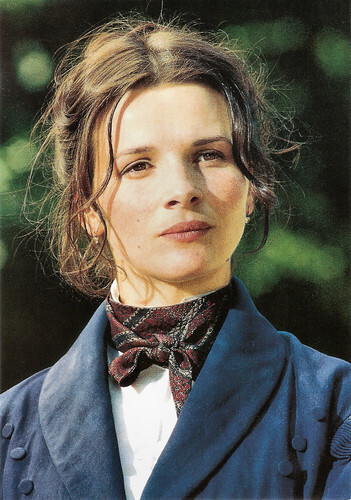
French postcard by CEC Rhone-Alpes. Photo: Mario Tursi. Juliette Binoche in Le hussard sur le toit/The Horseman on the Roof (Jean-Paul Rappeneau, 1995).

Vintage photo. Juliette Binoche and Olivier Martinez in Le hussard sur le toit/The Horseman on the Roof (Jean-Paul Rappeneau, 1995).
A rousing romantic epic about beautiful people having thrilling adventures
Le hussard sur le toit/The Horseman on the Roof (Jean-Paul Rappeneau, 1995) is a beautifully mounted historical drama. Reportedly, it was the most expensive French production ever made at the time of its release. Le Hussard Sur Le Toit was nominated for ten Cesar Awards, also known as the French Oscar. The film won two of them, Best Sound (Pierre Gamet, Jean Goudier and Dominique Hennequin) and Best Cinematography (Thierry Arbogast).
American critic Roger Ebert loved the film: "The Horseman on the Roof is a rousing romantic epic about beautiful people having thrilling adventures in breathtaking landscapes. Hollywood is too sophisticated (or too jaded) to make movies like this anymore; it comes from France, billed as the most expensive movie in French history. It's a grand entertainment, intelligently written, well-researched, set in the midst of a 19th-century cholera epidemic. (...) it satisfies an old hunger among moviegoers: It is pure cinema, made of action, beauty, landscape and passion, all played with gusto, and affection."
Incredibly handsome Oliver Martinez, as the hero, was at the time a new leading man in the style of the young Jean-Paul Belmondo , who starred in films like Cartouche. Binoche played a woman loyal to her husband, for whom duty is a higher calling than passion. Roger Ebert: "Her reserve, and the instinctive chivalry of Angelo, create a sexual tension between them that is more interesting because it is not acted upon. Their restraint sets the stage for an eventual development all the more romantic because it is based on love and faith, not carnal satisfaction."
Director Jean-Paul Rappeneau started out in film as an assistant and screenwriter collaborating with Louis Malle on Zazie dans le métro/Zazie in the Metro in 1960. In 1964, he was co-screenwriter for L'Homme de Rio/That Man from Rio (Philippe de Broca, 1964), which starred Jean-Paul Belmondo . The first film that he both wrote and directed was La Vie de château/A Matter of Resistance (Jean-Paul Rappeneau, 1966) starring Catherine Deneuve .
Since 1975, Rappeneau has written only for his own films, including Le Sauvage/Lovers Like Us (1975), starring Yves Montand and Catherine Deneuve , and Tout feu, tout flamme/All Fired Up (1981), again with Montand, who co-starred with Isabelle Adjani . In 1990, Rappeneau directed an elaborate and very successful film version of Cyrano de Bergerac, his adaptation of the classic French play by Edmond Rostand, starring Gérard Depardieu . Another success was his comedy Bon voyage (2003), which again starred Depardieu with Isabelle Adjani .
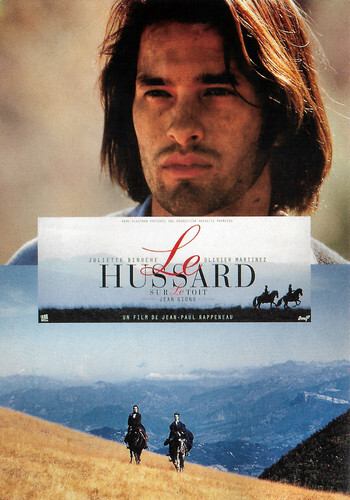
French postcard by Sonis, no. C. 561 Photo: Hachette Premiere / Mario Tursi / Le Moult. Olivier Martinez and Juliette Binoche in Le hussard sur le toit/The Horseman on the Roof (Jean-Paul Rappeneau, 1995).
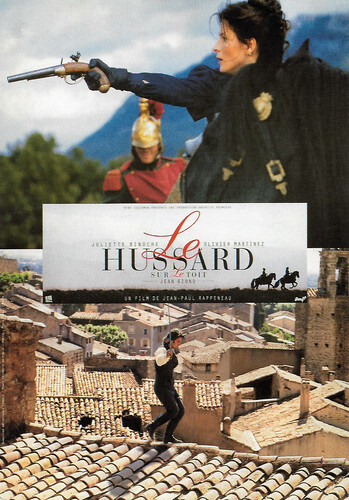
French postcard by Sonis, no. C. 562 Photo: Hachette Premiere / Mario Tursi, Fabian / Le Moult. Olivier Martinez and Juliette Binoche in Le hussard sur le toit/The Horseman on the Roof (Jean-Paul Rappeneau, 1995).
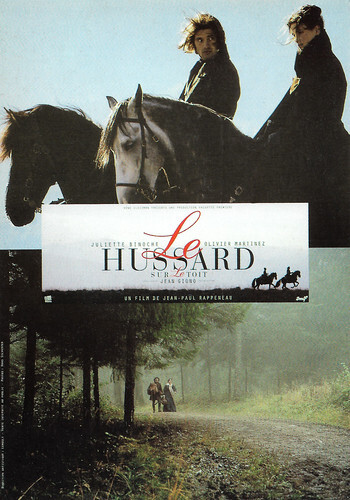
French postcard by Sonis, no. C. 563. Photo: Hachette Premiere / Hans Silvester, Rapho / Le Moult. Juliette Binoche and Olivier Martinez in Le hussard sur le toit/The Horseman on the Roof (Jean-Paul Rappeneau, 1995).
Sources: Roger Ebert (RogerEbert.Com), Mark Deming (AllMovie), Wikipedia (English and French) and IMDb.

Spanish postcard by Memory Card, no 324. Image: Warner Espanola. Spanish poster of Juliette Binoche and Olivier Martinez in Le hussard sur le toit/The Horseman on the Roof (Jean-Paul Rappeneau, 1995). Spanish title is 'El husar en el tejado'.

Danish postcard by Go Card, no. 2194, 1996. Photo: Camera Film. Juliette Binoche and Olivier Martinez in Le hussard sur le toit/The Horseman on the Roof (Jean-Paul Rappeneau, 1995).
A young Italian nobleman in France raising money for the Italian revolution
In 1832, cholera ravages Provence (South of France). Italian patriots hiding out in Aix, France, are betrayed by one of their own, and Austrian agents are on their trail. One patriot, Giacomo, is dragged away and executed. His wife runs off to warn their friend, Angelo Pardi (Olivier Martinez), a young Italian nobleman in France raising money for the Italian revolution against the Austrian Empire. As the agents descend on his apartment, Angelo escapes into the countryside.
At Meyrargues, Angelo looks for his compatriot and childhood friend, Maggionari, and then continues on to another village, where he writes to his mother, "Always fleeing. When can I fight and show what your son can do?" His mother purchased his commission as a colonel in the Piedmont Hussars, and he's never seen battle. Angelo encounters Maggionari, who turns out to be the traitor. When the Austrian agents arrive, Angelo fights them off and escapes.
The next day, Angelo enters a village ravaged by a cholera epidemic. The sight of the corpses abandoned to the scavenging crows sickens him. He meets a country physician, who shows him how to treat cholera victims by vigorously rubbing alcohol on the skin. Angelo continues north, passing a small village where corpses are being burned. He meets a young woman and two children and accompanies them to the outskirts of Manosque. The young woman, who is a tutor and lover of books, gives him a copy of 'Rinaldo and Armida' as a parting gift.
While in Manosque, Angelo is captured by a paranoid mob who accuse him of poisoning the town fountain. He is taken to the authorities, who soon abandon their posts in fear. Angelo searches for a compatriot but encounters the Austrian agents. Angelo eludes them, and with a sword in hand, fights his way through the hysterical mob and escapes across the rooftops. From his refuge above the town, Angelo watches one of the agents chased down and beaten to death, and later watches the piles of corpses being burned in the night.
To escape the rain, Angelo enters a dwelling where he is discovered by Countess Pauline de Théus ( Juliette Binoche ). Apologising for his presence, Angelo reassures her that he is a gentleman. Pauline offers him food and drink, and soon he falls asleep from exhaustion. The following morning, Pauline is gone and Angelo joins the forced evacuation of the town. In the hills outside Manosque, Angelo meets his compatriot, Giuseppe, who possesses money raised for the Italian resistance, but which cannot now be delivered because of the quarantine and roadblocks. Angelo agrees to deliver the money to Milan using backroads. Before leaving, he encounters the traitor, Maggionari, who attempts to kill Angelo before succumbing to cholera.
Angelo and Pauline meet again, and she joins him in a daring river escape. At Les Mées, rather than head east toward the Italian border, Angelo accompanies Pauline north toward her castle near Gap. Angelo insists it is his duty, so they set off through the countryside, avoiding the plague-ridden towns. Forced to camp out in the open, romantic feelings develop between the two, but Angelo remains gallant. Asked if he comes from a military family, Angelo reveals he never knew his father, saying, "He came to Italy with Napoleon, then left." Everything he learned in life came from his mother...

French postcard by CEC Rhone-Alpes. Photo: Mario Tursi. Juliette Binoche in Le hussard sur le toit/The Horseman on the Roof (Jean-Paul Rappeneau, 1995).

Vintage photo. Juliette Binoche and Olivier Martinez in Le hussard sur le toit/The Horseman on the Roof (Jean-Paul Rappeneau, 1995).
A rousing romantic epic about beautiful people having thrilling adventures
Le hussard sur le toit/The Horseman on the Roof (Jean-Paul Rappeneau, 1995) is a beautifully mounted historical drama. Reportedly, it was the most expensive French production ever made at the time of its release. Le Hussard Sur Le Toit was nominated for ten Cesar Awards, also known as the French Oscar. The film won two of them, Best Sound (Pierre Gamet, Jean Goudier and Dominique Hennequin) and Best Cinematography (Thierry Arbogast).
American critic Roger Ebert loved the film: "The Horseman on the Roof is a rousing romantic epic about beautiful people having thrilling adventures in breathtaking landscapes. Hollywood is too sophisticated (or too jaded) to make movies like this anymore; it comes from France, billed as the most expensive movie in French history. It's a grand entertainment, intelligently written, well-researched, set in the midst of a 19th-century cholera epidemic. (...) it satisfies an old hunger among moviegoers: It is pure cinema, made of action, beauty, landscape and passion, all played with gusto, and affection."
Incredibly handsome Oliver Martinez, as the hero, was at the time a new leading man in the style of the young Jean-Paul Belmondo , who starred in films like Cartouche. Binoche played a woman loyal to her husband, for whom duty is a higher calling than passion. Roger Ebert: "Her reserve, and the instinctive chivalry of Angelo, create a sexual tension between them that is more interesting because it is not acted upon. Their restraint sets the stage for an eventual development all the more romantic because it is based on love and faith, not carnal satisfaction."
Director Jean-Paul Rappeneau started out in film as an assistant and screenwriter collaborating with Louis Malle on Zazie dans le métro/Zazie in the Metro in 1960. In 1964, he was co-screenwriter for L'Homme de Rio/That Man from Rio (Philippe de Broca, 1964), which starred Jean-Paul Belmondo . The first film that he both wrote and directed was La Vie de château/A Matter of Resistance (Jean-Paul Rappeneau, 1966) starring Catherine Deneuve .
Since 1975, Rappeneau has written only for his own films, including Le Sauvage/Lovers Like Us (1975), starring Yves Montand and Catherine Deneuve , and Tout feu, tout flamme/All Fired Up (1981), again with Montand, who co-starred with Isabelle Adjani . In 1990, Rappeneau directed an elaborate and very successful film version of Cyrano de Bergerac, his adaptation of the classic French play by Edmond Rostand, starring Gérard Depardieu . Another success was his comedy Bon voyage (2003), which again starred Depardieu with Isabelle Adjani .

French postcard by Sonis, no. C. 561 Photo: Hachette Premiere / Mario Tursi / Le Moult. Olivier Martinez and Juliette Binoche in Le hussard sur le toit/The Horseman on the Roof (Jean-Paul Rappeneau, 1995).

French postcard by Sonis, no. C. 562 Photo: Hachette Premiere / Mario Tursi, Fabian / Le Moult. Olivier Martinez and Juliette Binoche in Le hussard sur le toit/The Horseman on the Roof (Jean-Paul Rappeneau, 1995).

French postcard by Sonis, no. C. 563. Photo: Hachette Premiere / Hans Silvester, Rapho / Le Moult. Juliette Binoche and Olivier Martinez in Le hussard sur le toit/The Horseman on the Roof (Jean-Paul Rappeneau, 1995).
Sources: Roger Ebert (RogerEbert.Com), Mark Deming (AllMovie), Wikipedia (English and French) and IMDb.
Published on June 21, 2022 22:00
June 20, 2022
Henny Porten, Part 2
Yesterday, we had Part 1 of our post on sturdy and blond Henny Porten (1890-1960), who was one of Germany's most important and popular film actresses of the silent cinema. She was also the producer of many of her own films. But what happened with her after the arrival of the sound film?

German postcard by Ross Verlag, no. 126/1. Photo: Atelier Schmoll, Berlin / Nero-Porten-Film. Henny Porten in Kohlhiesels Töchter/Kohlhiesel's Daughters (Hans Behrendt, 1930).
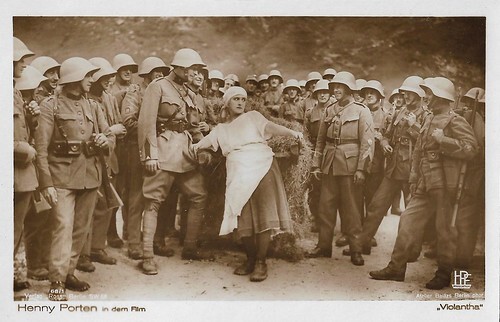
German postcard by Ross Verlag, no. 68/1. Photo: Atelier Balazs, Berlin / Henny Porten-Film. Henny Porten in the German silent drama Violantha (Carl Froehlich, 1927).
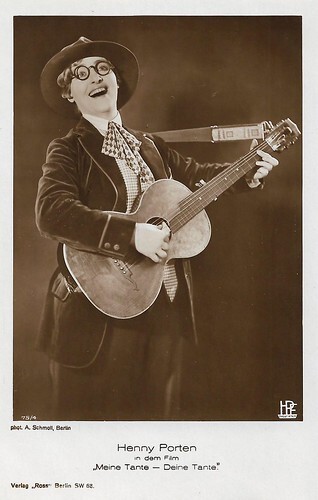
German postcard by Ross Verlag, no. 75/4. Photo: A. Schmoll, Berlin / Henny-Porten-Film. Henny Porten in Meine Tante - deine Tante (Carl Froehlich, 1927).
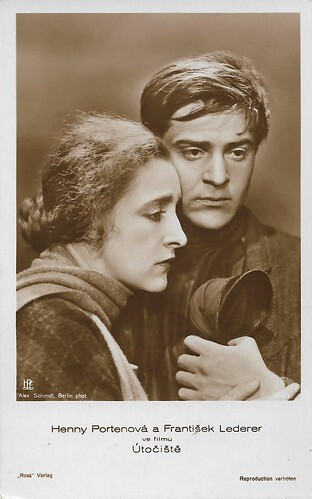
Yugoslavian postcard, based on a German postcard, Ross Verlag, no. 100/1. Photo: Atelier Schmoll, Berlin / Henny Porten Filmproduktion (HPF). Henny Porten and Franz Lederer in Zuflucht/Refuge (Carl Froelich, 1928). Released in former Yugoslavia as Utočište.
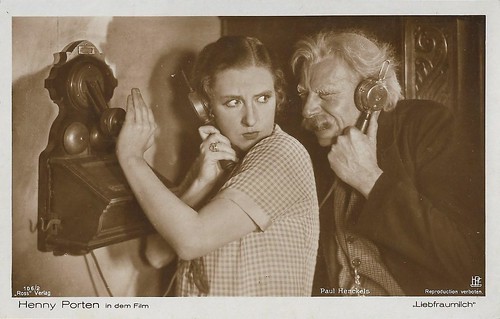
German postcard by Ross Verlag, no. 106/2. Photo: Henny Porten-Froehlich produktion (HPF). Henny Porten and Paul Henckels in Liebfraumilch/German Wine (Carl Froehlich, 1929).
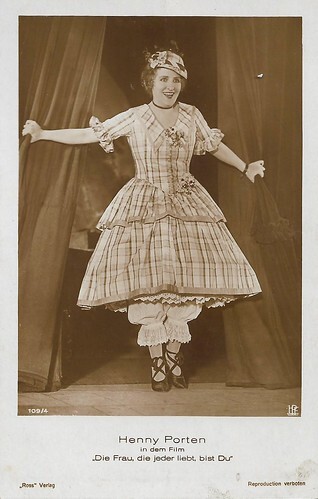
German Postcard by Ross Verlag, no. 109/4. Photo: Henny Porten-Froelich Produktion (HPF). Publicity still for Die Frau, die jeder liebst, bist Du (Carl Froehlich, 1929).
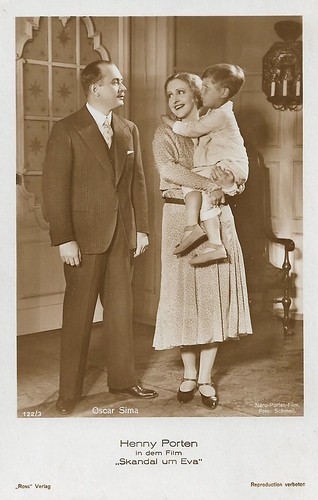
German postcard by Ross Verlag, no. 122/3. Photo: Schmoll / Nero-Porten-Film. Henny Porten and Oskar Sima in the German early sound film Skandal um Eva/Scandalous Eva (Georg Wilhelm Pabst, 1930).
Trouble with Goebbels
Henny Porten seemed to pass from silent to sound cinema without any obstacles. She starred in such films as Mutterliebe/Mother Love (Georg Jacoby, 1929) with Gustav Diessl , Die Herrin und ihr Knecht/The Boss and Her Servant (Richard Oswald, 1929) with Mary Kid , and a remake of Kohlhiesels Töchter/Kohlhiesel's Daughters (Hans Behrendt, 1930) opposite Fritz Kampers.
The following year she achieved her long-planned project, the film Luise, Königin von Preußen/Luise, Queen of Prussia (Carl Froelich, 1931) with Gustaf Gründgens, which ultimately bankrupted her company in the summer of 1932. After this project, Porten was considered to be a risk within the film industry. With no film engagements coming, she sought refuge on stage.
She achieved renewed film success in the autumn of 1933, with the sound film remake of Mutter und Kind/Mother and Child (Hans Steinhoff, 1933). She had become the quintessence of German womanhood, ladylike yet kindhearted and a not a little petit bourgeois.
There were years Henny Porten had done twelve films a year, but the Nazi takeover of Germany in 1933 brought her career to an almost standstill. Her refusal to divorce her Jewish husband Wilhelm von Kaufmann got her in trouble with propaganda minister Josef Goebbels.
When she resolved to emigrate to join Ernst Lubitsch in Hollywood, he denied her an exit visa to prevent a negative impression. Goebbels tried to ban her from the film industry, but she made a few films after the Allied bombardment started, and her placid and reassuring persona helped calm audiences.
In 1937 she was taken on by the Tobis company on a work for money basis but was never offered any work. Porten was permitted to work in such Austrian-made films as the comedy Der Optimist/The Optimist (E.W. Emo, 1938) with Viktor de Kowa and Theo Lingen , and the crime drama War es der im Dritten Stock/Was It Him on the Third Floor? (Carl Boese, 1938).
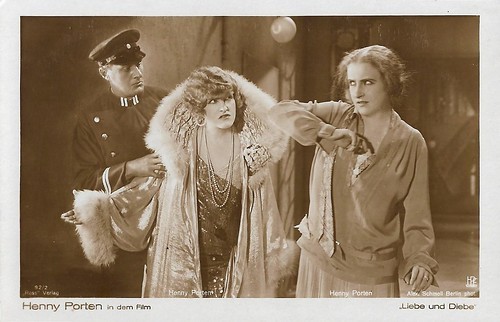
German postcard by Ross Verlag, no. 92/2. Photo Alex Schmoll, Berlin / Henny Porten-Froehlich Produktion. Henny Porten in a double role in Liebe und Diebe (Carl Froehlich, 1928).
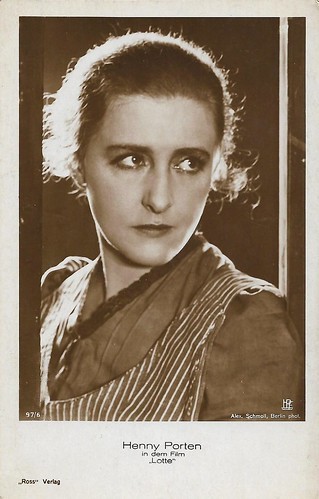
German postcard by Ross Verlag, no. 97/6. Photo: Alex Schmoll, Berlin / HPF (Henny Porten-Froehlich Produktion). Henny Porten in Lotte (Carl Froehlich, 1928).
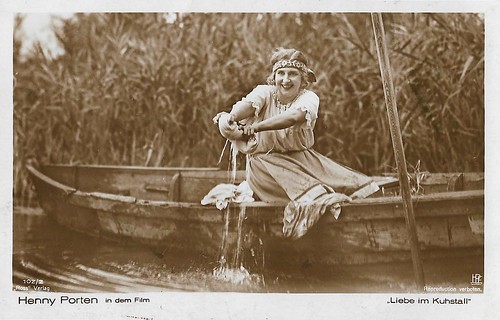
German postcard by Ross Verlag, no. 102/2. Photo: Henny Porten Freuhlich-Produktion. Henny Porten in Liebe im Kuhstall/Love in the Cowshed (Carl Froelich, 1928).
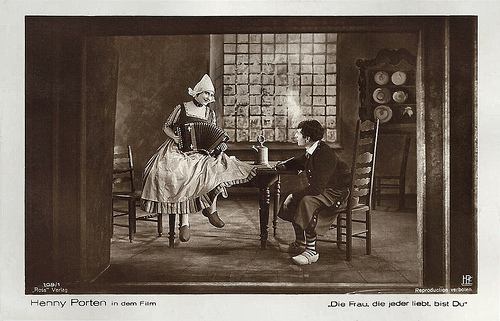
German Postcard by Ross Verlag, no. 109/1. Photo: Henny Porten Film. Publicity still for Die Frau, die jeder liebst, bist Du (Carl Froehlich, 1928-1929).
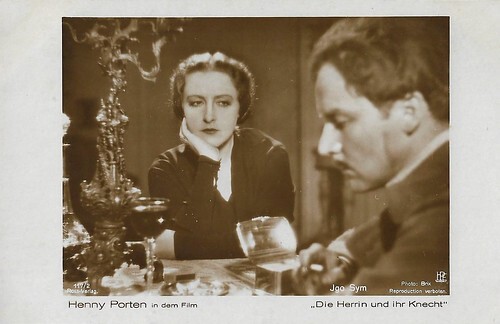
German postcard by Ross Verlag, no. 117/2. Photo: Brix /Henny Porten-Film Produktion. Henny Porten and Igo Sym in Die Herrin und ihr Knecht (Richard Oswald, 1929), a drama taking place at the German-Russian border shortly before and during the First World War.
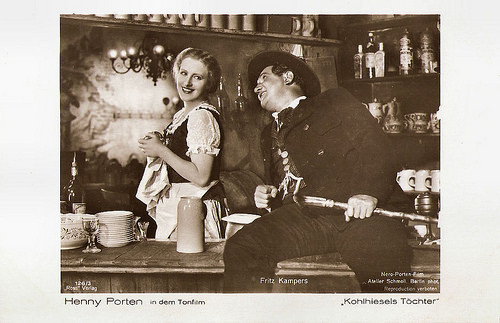
German postcard by Ross Verlag, no. 126/3. Photo: Atelier Schmoll, Berlin / Nero-Porten-Film. Publicity still for Kohlhiesels Töchter/Kohlhiesel's Daughters (Hans Behrendt, 1930) with Fritz Kampers.
Deserting to the DDR
Henny Porten was hired by old friend G.W. Pabst to play the duchess in Komödianten/The Comedians (Georg Wilhelm Pabst, 1941) with Käthe Dorsch and Hilde Krahl , and she was reunited with Carl Froelich for the homey comedy Familie Buchholz/The Buchholz Family (Carl Froelich, 1944).
In 1944, after an aerial mine destroyed their home, Porten and her husband were out on the streets, as it was forbidden to shelter a full Jew.
After the war, offers remained poor. Henny Porten lived in Ratzeburg and performed in Lübeck and the Hamburg Theater in 1947. She was given a small role in the comedy Absender unbekannt/Sender unknown (Ákos Ráthonyi, 1950).
So in 1953, she followed an invitation made by the DEFA studio to go east to the new DDR. There she played leading roles in Carola Lamberti - Eine vom Zirkus/Carola Lamberti - One From the Circus (Hans Müller, 1954) and the crime drama Das Fräulein von Scuderi/The Miss from Scuderi (Eugen York, 1955), which would prove to be her last film.
In the Western press, her step was branded as that of a 'deserter'. When Porten and her husband returned to Ratzeburg in 1955, they were evicted by their landlord. Von Kaufmann lost his practice. Through the press, Porten unsuccessfully asked for work in film.
They moved to Berlin in 1957, where Von Kaufmann died in 1959. In 1960, Henny Porten finally was awarded the Bundesverdienstkreuz, but she died after suffering a severe illness a few months later.
Between 1906 and 1955 Henny Porten appeared in over 170 films.

German postcard by Ross Verlag, no. 126/4. Photo: Atelier Schmoll, Berlin / Nero-Porten-Film. Henny Porten in Kohlhiesels Töchter/Kohlhiesel's Daughters (Hans Behrendt, 1930).
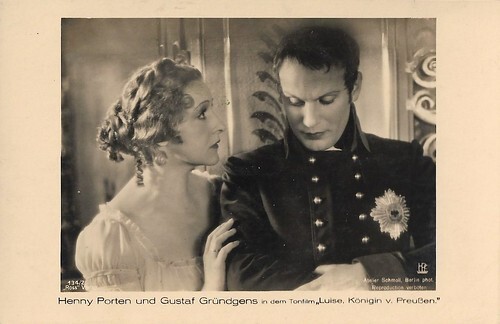
German postcard by Ross Verlag, Berlin, no. 134/2. Photo: Atelier Schmoll, Berlin / Henny Porten Filmproduktion (HPF). Henny Porten as Luise, Queen of Prussia and Gustav Gründgens as her husband, King Friedrich Wilhelm III, in the German early sound film Luise, Königin von Preußen/Luise, Queen of Prussia (Carl Froehlich, 1931).
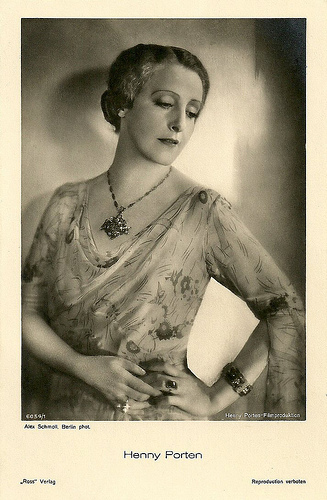
German postcard by Ross Verlag, no. 6059/4, 1931-1932. Photo Alex Schmidt, Berlin / Henny-Porten-Filmproduktion.
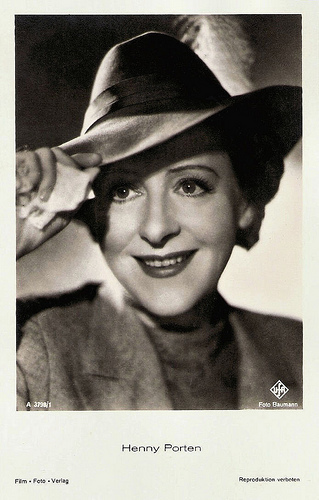
German postcard by Film-Foto-Verlag, no. A 3787/1, 1941-1944. Photo: Baumann / Ufa.
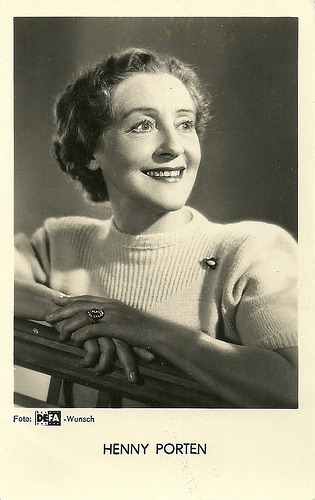
German postcard. Photo: DEFA / Wunsch.
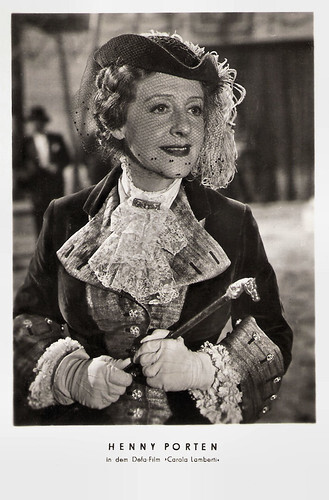
East-German postcard by VEB Volkskunstverlag Reichenbach I.V., Berlin, no. G 634, 1956. Photo: Wenzel. Henny Portern in Carola Lamberti (Hans Müller, 1954).
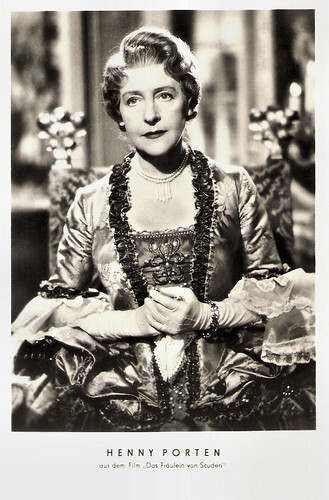
East-German postcard by VEB Volkskunstverlag Reichenbach I.V., Berlin, no. G 566, 1955. Photo: DEFA / Neufeld. Henny Portern in Das Fräulein von Scuderi (Eugen York, 1955).
Sources: Thomas Staedeli (Cyranos), Hans J. Wollstein (AllMovie), (IMDb), Filmportal.de, Wikipedia and .

German postcard by Ross Verlag, no. 126/1. Photo: Atelier Schmoll, Berlin / Nero-Porten-Film. Henny Porten in Kohlhiesels Töchter/Kohlhiesel's Daughters (Hans Behrendt, 1930).

German postcard by Ross Verlag, no. 68/1. Photo: Atelier Balazs, Berlin / Henny Porten-Film. Henny Porten in the German silent drama Violantha (Carl Froehlich, 1927).

German postcard by Ross Verlag, no. 75/4. Photo: A. Schmoll, Berlin / Henny-Porten-Film. Henny Porten in Meine Tante - deine Tante (Carl Froehlich, 1927).

Yugoslavian postcard, based on a German postcard, Ross Verlag, no. 100/1. Photo: Atelier Schmoll, Berlin / Henny Porten Filmproduktion (HPF). Henny Porten and Franz Lederer in Zuflucht/Refuge (Carl Froelich, 1928). Released in former Yugoslavia as Utočište.

German postcard by Ross Verlag, no. 106/2. Photo: Henny Porten-Froehlich produktion (HPF). Henny Porten and Paul Henckels in Liebfraumilch/German Wine (Carl Froehlich, 1929).

German Postcard by Ross Verlag, no. 109/4. Photo: Henny Porten-Froelich Produktion (HPF). Publicity still for Die Frau, die jeder liebst, bist Du (Carl Froehlich, 1929).

German postcard by Ross Verlag, no. 122/3. Photo: Schmoll / Nero-Porten-Film. Henny Porten and Oskar Sima in the German early sound film Skandal um Eva/Scandalous Eva (Georg Wilhelm Pabst, 1930).
Trouble with Goebbels
Henny Porten seemed to pass from silent to sound cinema without any obstacles. She starred in such films as Mutterliebe/Mother Love (Georg Jacoby, 1929) with Gustav Diessl , Die Herrin und ihr Knecht/The Boss and Her Servant (Richard Oswald, 1929) with Mary Kid , and a remake of Kohlhiesels Töchter/Kohlhiesel's Daughters (Hans Behrendt, 1930) opposite Fritz Kampers.
The following year she achieved her long-planned project, the film Luise, Königin von Preußen/Luise, Queen of Prussia (Carl Froelich, 1931) with Gustaf Gründgens, which ultimately bankrupted her company in the summer of 1932. After this project, Porten was considered to be a risk within the film industry. With no film engagements coming, she sought refuge on stage.
She achieved renewed film success in the autumn of 1933, with the sound film remake of Mutter und Kind/Mother and Child (Hans Steinhoff, 1933). She had become the quintessence of German womanhood, ladylike yet kindhearted and a not a little petit bourgeois.
There were years Henny Porten had done twelve films a year, but the Nazi takeover of Germany in 1933 brought her career to an almost standstill. Her refusal to divorce her Jewish husband Wilhelm von Kaufmann got her in trouble with propaganda minister Josef Goebbels.
When she resolved to emigrate to join Ernst Lubitsch in Hollywood, he denied her an exit visa to prevent a negative impression. Goebbels tried to ban her from the film industry, but she made a few films after the Allied bombardment started, and her placid and reassuring persona helped calm audiences.
In 1937 she was taken on by the Tobis company on a work for money basis but was never offered any work. Porten was permitted to work in such Austrian-made films as the comedy Der Optimist/The Optimist (E.W. Emo, 1938) with Viktor de Kowa and Theo Lingen , and the crime drama War es der im Dritten Stock/Was It Him on the Third Floor? (Carl Boese, 1938).

German postcard by Ross Verlag, no. 92/2. Photo Alex Schmoll, Berlin / Henny Porten-Froehlich Produktion. Henny Porten in a double role in Liebe und Diebe (Carl Froehlich, 1928).

German postcard by Ross Verlag, no. 97/6. Photo: Alex Schmoll, Berlin / HPF (Henny Porten-Froehlich Produktion). Henny Porten in Lotte (Carl Froehlich, 1928).

German postcard by Ross Verlag, no. 102/2. Photo: Henny Porten Freuhlich-Produktion. Henny Porten in Liebe im Kuhstall/Love in the Cowshed (Carl Froelich, 1928).

German Postcard by Ross Verlag, no. 109/1. Photo: Henny Porten Film. Publicity still for Die Frau, die jeder liebst, bist Du (Carl Froehlich, 1928-1929).

German postcard by Ross Verlag, no. 117/2. Photo: Brix /Henny Porten-Film Produktion. Henny Porten and Igo Sym in Die Herrin und ihr Knecht (Richard Oswald, 1929), a drama taking place at the German-Russian border shortly before and during the First World War.

German postcard by Ross Verlag, no. 126/3. Photo: Atelier Schmoll, Berlin / Nero-Porten-Film. Publicity still for Kohlhiesels Töchter/Kohlhiesel's Daughters (Hans Behrendt, 1930) with Fritz Kampers.
Deserting to the DDR
Henny Porten was hired by old friend G.W. Pabst to play the duchess in Komödianten/The Comedians (Georg Wilhelm Pabst, 1941) with Käthe Dorsch and Hilde Krahl , and she was reunited with Carl Froelich for the homey comedy Familie Buchholz/The Buchholz Family (Carl Froelich, 1944).
In 1944, after an aerial mine destroyed their home, Porten and her husband were out on the streets, as it was forbidden to shelter a full Jew.
After the war, offers remained poor. Henny Porten lived in Ratzeburg and performed in Lübeck and the Hamburg Theater in 1947. She was given a small role in the comedy Absender unbekannt/Sender unknown (Ákos Ráthonyi, 1950).
So in 1953, she followed an invitation made by the DEFA studio to go east to the new DDR. There she played leading roles in Carola Lamberti - Eine vom Zirkus/Carola Lamberti - One From the Circus (Hans Müller, 1954) and the crime drama Das Fräulein von Scuderi/The Miss from Scuderi (Eugen York, 1955), which would prove to be her last film.
In the Western press, her step was branded as that of a 'deserter'. When Porten and her husband returned to Ratzeburg in 1955, they were evicted by their landlord. Von Kaufmann lost his practice. Through the press, Porten unsuccessfully asked for work in film.
They moved to Berlin in 1957, where Von Kaufmann died in 1959. In 1960, Henny Porten finally was awarded the Bundesverdienstkreuz, but she died after suffering a severe illness a few months later.
Between 1906 and 1955 Henny Porten appeared in over 170 films.

German postcard by Ross Verlag, no. 126/4. Photo: Atelier Schmoll, Berlin / Nero-Porten-Film. Henny Porten in Kohlhiesels Töchter/Kohlhiesel's Daughters (Hans Behrendt, 1930).

German postcard by Ross Verlag, Berlin, no. 134/2. Photo: Atelier Schmoll, Berlin / Henny Porten Filmproduktion (HPF). Henny Porten as Luise, Queen of Prussia and Gustav Gründgens as her husband, King Friedrich Wilhelm III, in the German early sound film Luise, Königin von Preußen/Luise, Queen of Prussia (Carl Froehlich, 1931).

German postcard by Ross Verlag, no. 6059/4, 1931-1932. Photo Alex Schmidt, Berlin / Henny-Porten-Filmproduktion.

German postcard by Film-Foto-Verlag, no. A 3787/1, 1941-1944. Photo: Baumann / Ufa.

German postcard. Photo: DEFA / Wunsch.

East-German postcard by VEB Volkskunstverlag Reichenbach I.V., Berlin, no. G 634, 1956. Photo: Wenzel. Henny Portern in Carola Lamberti (Hans Müller, 1954).

East-German postcard by VEB Volkskunstverlag Reichenbach I.V., Berlin, no. G 566, 1955. Photo: DEFA / Neufeld. Henny Portern in Das Fräulein von Scuderi (Eugen York, 1955).
Sources: Thomas Staedeli (Cyranos), Hans J. Wollstein (AllMovie), (IMDb), Filmportal.de, Wikipedia and .
Published on June 20, 2022 22:00
June 19, 2022
Henny Porten, Part 1
Sturdy and blond Henny Porten (1890-1960) was one of Germany's most important and popular film actresses of the silent cinema. She was also the producer of many of her own films. She became the quintessence of German womanhood, ladylike yet kindhearted. Today, EFSP presents Part 1 of a post on her long career. Part 2 follows tomorrow.
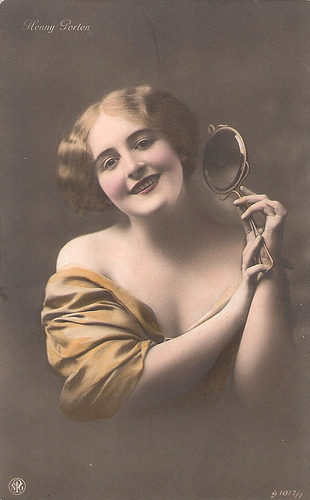
German postcard by NPG (Neue Photographische Gesellschaft), no. 1017/1.
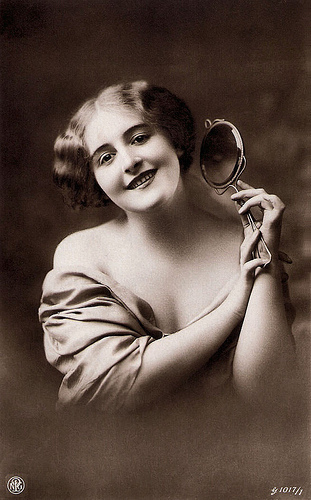
German postcard by NPG (Neue Photographische Gesellschaft), no. G 1017/1.
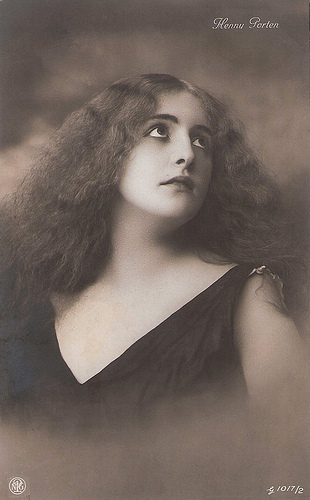
German postcard by NPG (Neue Photographische Gesellschaft), no. G 1017/2.
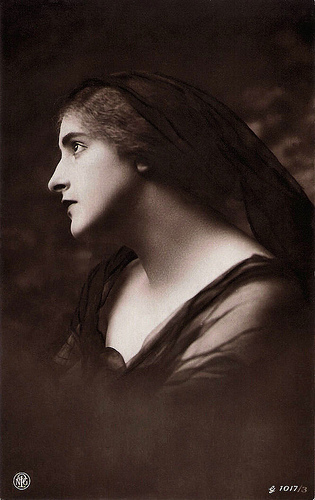
German postcard by NPG (Neue Photographische Gesellschaft), no. G 1017/3.
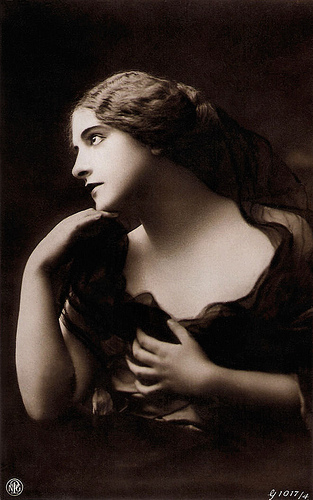
German postcard by NPG (Neue Photographische Gesellschaft), no. G 1017/4.
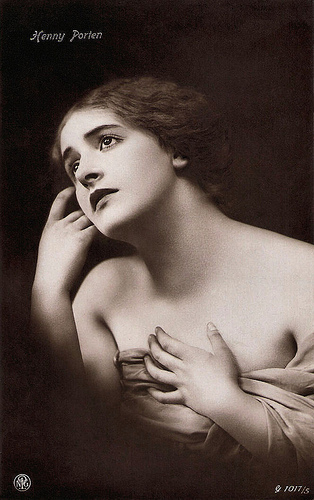
German postcard by NPG (Neue Photographische Gesellschaft), no. G 1017/5.
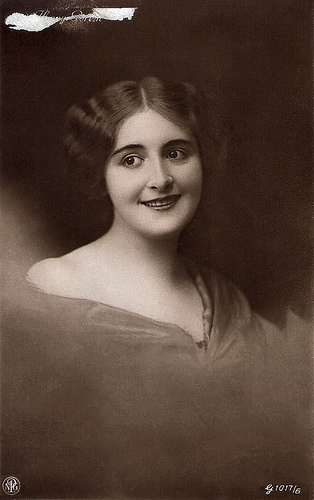
German postcard by NPG (Neue Photographische Gesellschaft), no. G 1017/6.
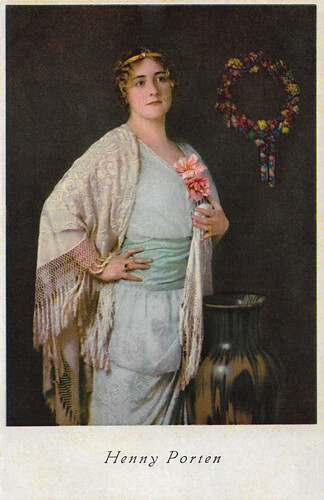
German postcard in the Künstler Postkarten Serie by Meissner & Buch, Leipzig, no. 2365.
Queen of the Mutoskop Peepboxes
Frieda Ulricke 'Henny' Porten was born in Magdeburg, Germany in 1890. She was the second daughter of Franz Porten, an opera baritone and actor-director at the Stadtheater of Magdeburg, and his wife Wincenzia, whose maiden name was Wybiral. Her older sister was the actress and script-writer Rosa Porten .
In January 1906, Franz Porten was engaged by film pioneer Oskar Messter to direct six Biophon-Sound Pictures. These were short early sound films that were projected with synchronously playing gramophone records.
So Henny made her film debut in Apachentanz/Apache Dance (Oskar Messter, 1906). This made her one of the earliest film actresses anywhere in the world.
She went on to perform in numerous sound pictures mostly for the Deutsche Mutoskop und Biograph GmbH, which included her work also in their Mutoskop peep boxes. Her work involved singing in three different languages by moving her lips in a synchronised fashion to a gramophone record. Despite having no training in acting, this work allowed her to become a highly experienced actress.
Five years later audiences were clamouring to know the name of the blonde (and blind) girl in Das Liebesgluck der Blinden/The joy of love of the blind (Heinrich Bolten Baeckers, Curt A. Stark, 1911), a melodrama written for her by her sister Rosa Porten .
In 1912 she married Curt A. Stark, who would direct most of her films until his death in 1916. In 1912 Messter concluded a one month contract with her, which had been repeatedly extended. After the success of Eva (Curt A. Stark, 1913), she started the Henny Porten Film Star Series, beginning with Der Feind im Land/The enemy in the country (Curt A. Stark, 1913).
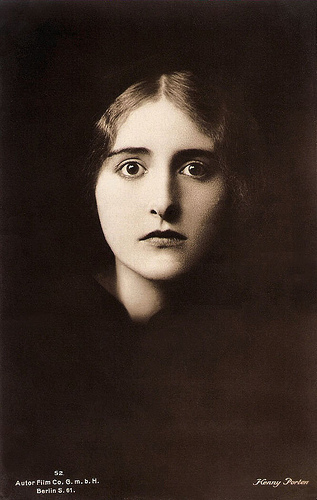
German postcard by Autor Film Co. G.m.b.H., Berlin, no. 52.
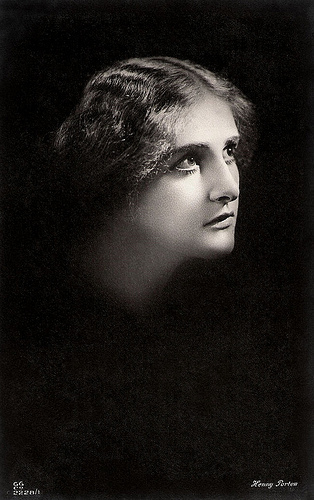
German postcard by GG Co., no. 2228/1. Sent by mail in the Netherlands in 1921.
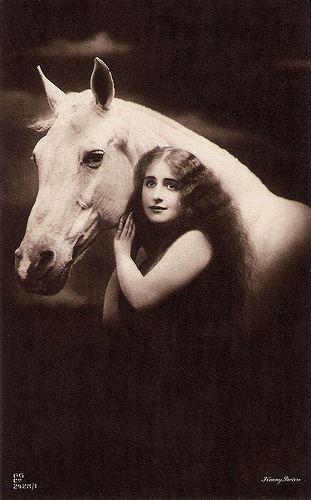
German postcard by GG Co., no. 2428/11.
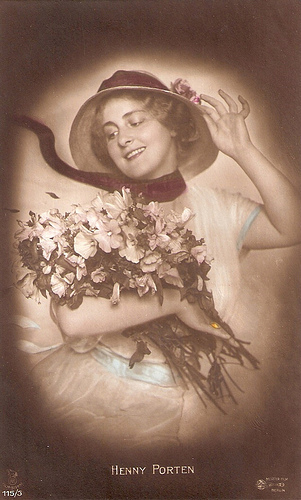
German Postcard by Rotophot in the Film Sterne series, no. 115/3. Photo: Messter-Film, Berlin.
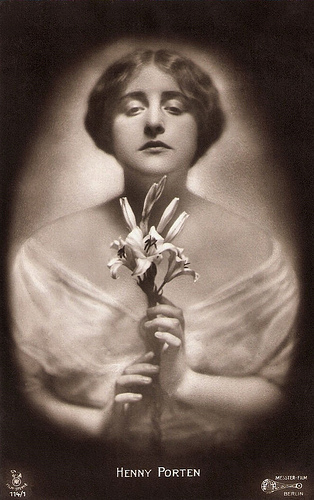
German postcard by Rotophot in the Film Sterne series, no. 114/1. Photo: Messter Film, Berlin.
The ultimate Wilhelminian actress
Following the exodus in the film industry at the beginning of the First World War, Henny Porten initiated, as if personally, the renaissance of the German cinema with Das Ende vom Liede/The end of the Song (Rudolf Biebrach, 1915) with Ludwig Trautmann .
Rudolf Biebrach, who in earlier films often played her father, now took on the job of the film director. The Porten films were at the peak of their success.
Henny Porten embodied the ultimate Wilhelminian actress, with her long, blond hair, her innocent-looking face and her rounds.
Though she often performed as the tragic, self-sacrificing woman, tormented by class conflicts and evil men, like in Alexandra (Curt A. Stark, 1915), she also proved to be an able comedienne, like in Gräfin Küchenfee (Robert Wiene, 1918) with Ernst Hofmann .
In 1916, her husband and director Curt Stark died on the Western Front.
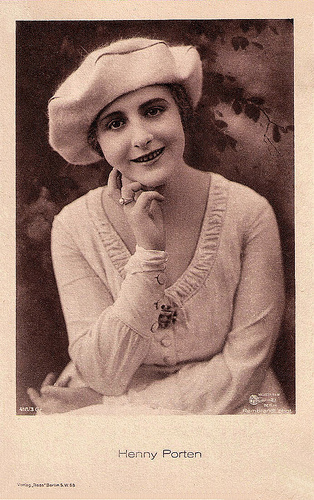
German postcard by Ross Verlag, no. 418/3 Gr. Photo: Rembrandt Photography / Messter Film, Berlin.
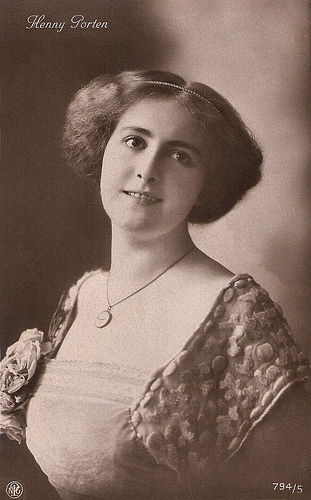
German postcard by NPG (Neue Photographische Gesellschaft), no. 794/5. Sent by mail in the Netherlands in 1921.
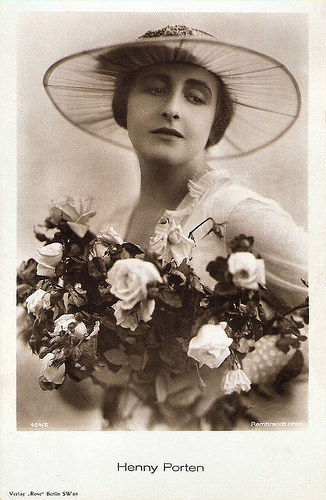
German postcard by Ross Verlag, no. 424/2, 1919-1924. Photo: Rembrandt.
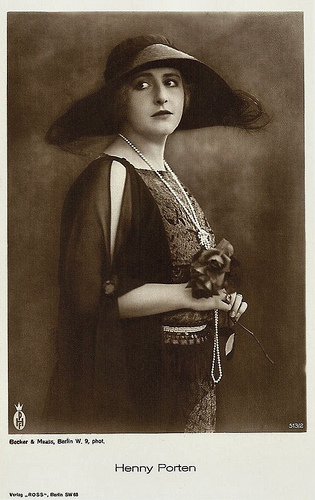
German postcard by Ross Verlag, no. 513/2, 1919-1924. Photo: Becker & Maass, Berlin / Henny Porten Film.
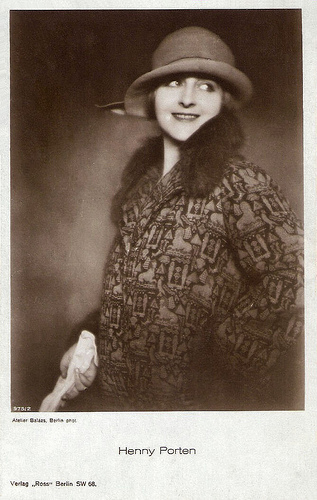
German postcard by Ross Verlag, no. 975/2, 1925-1926. Photo: Atelier Balázs, Berlin.
Invitation for Hollywood
Henny Porten reached a new height of her screen career under the gentle guidance of Ernst Lubitsch , who cast her as the title character in Anna Boleyn (Ernst Lubitsch, 1920), a biopic on the ill-fated second wife of the English king Henry VIII ( Emil Jannings ), and the comedy Kohlhiesels Töchter/Kohlhiesel's Daughters (Ernst Lubitsch, 1920) in which Porten played both Liesel the ugly daughter as well as her beautiful sister Gretel.
The success of these films resulted in an invitation for Porten and her co-star Emil Jannings to come to Hollywood, but Henny remained in Germany. In March 1921, she established the company Henny Porten Films GmbH, and that year she also married doctor Wilheim von Kauffman.
After the box office hit Die Geierwally/Wally of the Vultures (Ewald André Dupont, 1921) with Wilhelm Dieterle, Porten produced the highly ambitious studio film Hintertreppe/Backstairs (Paul Leni, Leopold Jessner, 1921). While highly praised by critics, the film was financially unsuccessful.
After three further years of rather unsuccessful films, Henny Porten's film company went bankrupt in 1923. In spite of this, she continued to have a longstanding and prolific acting career throughout the 1920s with films like Gräfin Donelli/Countess Donelli (Georg Wilhelm Pabst), 1924 and Mutter und Kind/Mother and Child (1924) with Friedrich Kayssler , the first of a series of films directed and produced by her former director of photography, Carl Froelich.
To be continued next week.
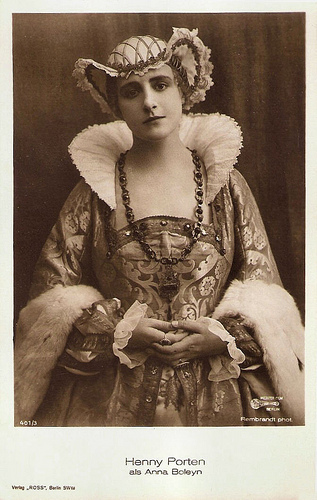
German postcard by Ross Verlag, Berlin, no. 401/3, 1919-1924. Photo: Rembrandt Phot. / Messter Film, Berlin. Publicity still for Anna Boleyn (Ernst Lubitsch, 1920).
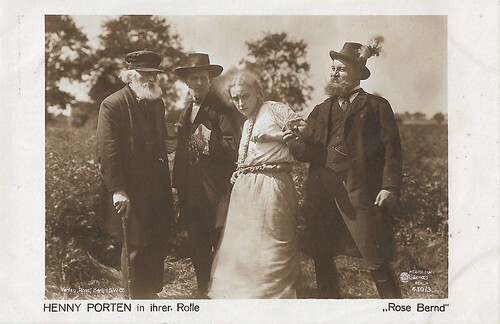
German postcard by Ross Verlag, no. 630/3. Photo: Messter-Film, Berlin. Henny Porten in Rose Bernd (Alfred Halm, 1919), adapted from the eponymous play by Gerhard Hauptmann. The man with the white beard may be Werner Krauß as Rose's father. To the right, Emil Jannings as the brutal suitor Arthur Streckmann.
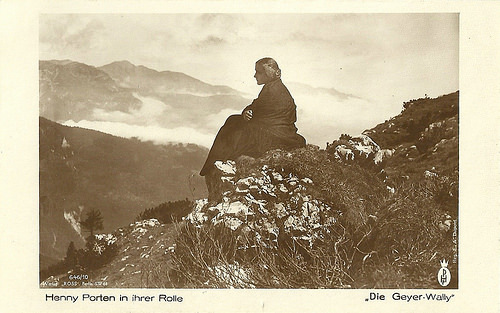
German postcard by Ross Verlag, no. 646/1. Photo: HPF (Henny Porten Film). Henny Porten in Die Geyer-Wally (E.A. Dupont, 1921), based on the novel by Wilhelmine von Hillern. The sets were by Paul Leni. Henny Porten as Wally.
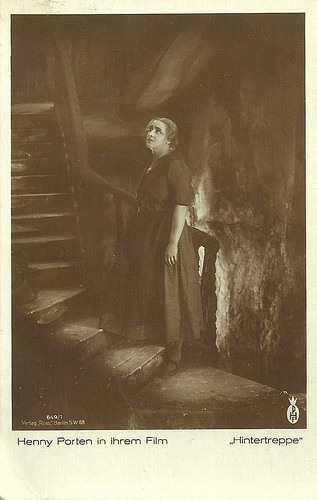
German postcard by Ross Verlag, no. 649/1. Photo: Henny Porten-Film. Henny Porten in the classic Kammerspiel film Hintertreppe (Leopold Jessner, 1921).
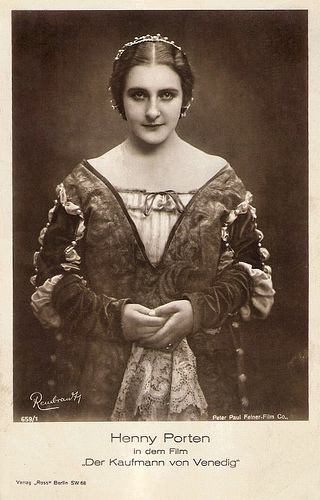
German postcard by Ross Verlag, no. 659/1, 1923-1924. Photo: Rembrandt / Peter Paul Felner-Film Co. Henny Porten as Porzia (Portia) in Der Kaufmann von Venedig (Peter Paul Felner, 1923), based on the play The Merchant of Venice by William Shakespeare.
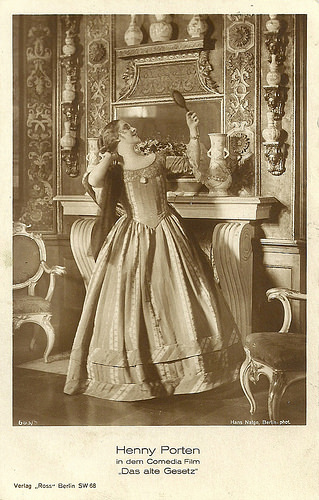
German postcard by Ross Verlag, no. 663/9. Photo: Hans Natge, Berlin. Henny Porten in Das alte Gesetz (E.A. Dupont, 1923).
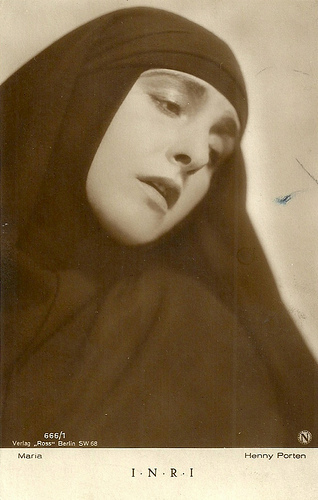
German postcard by Ross Verlag, no. 666/1. Photo: Neumann. Henny Porten as Mary in the Biblical film I.N.R.I. (Robert Wiene, 1923).
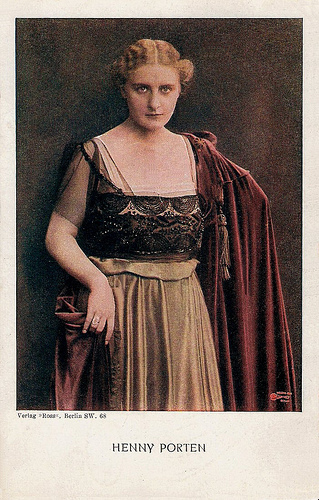
German postcard by Ross Verlag, no. 2001/11. Photo: Becker & Maass / Messter Film.
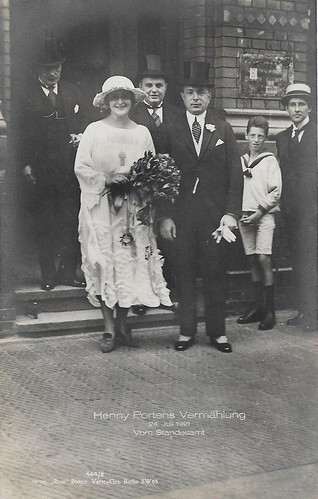
German postcard by Ross Verlag, Berlin, no. 448/2. Henny Porten's wedding, 24 July 1921, before the City Hall. Her husband was Wilhelm von Kaufmann (1888–1959), a doctor of Jewish origin, then director of the Sanatorium "Wiggers Kurheim", in Garmisch-Partenkirchen, who thereafter took charge of the production of Porten's films. Kaufmann was Porten's second husband, after Curt A. Stark, who died during at the Eastern Front WWI. NB English and German Wikipedia write that the wedding day was on 24 June 1921, so not July.
To be continued tomorrow.
Sources: Thomas Staedeli (Cyranos), Hans J. Wollstein (AllMovie), (IMDb), Filmportal.de , Wikipedia and .

German postcard by NPG (Neue Photographische Gesellschaft), no. 1017/1.

German postcard by NPG (Neue Photographische Gesellschaft), no. G 1017/1.

German postcard by NPG (Neue Photographische Gesellschaft), no. G 1017/2.

German postcard by NPG (Neue Photographische Gesellschaft), no. G 1017/3.

German postcard by NPG (Neue Photographische Gesellschaft), no. G 1017/4.

German postcard by NPG (Neue Photographische Gesellschaft), no. G 1017/5.

German postcard by NPG (Neue Photographische Gesellschaft), no. G 1017/6.

German postcard in the Künstler Postkarten Serie by Meissner & Buch, Leipzig, no. 2365.
Queen of the Mutoskop Peepboxes
Frieda Ulricke 'Henny' Porten was born in Magdeburg, Germany in 1890. She was the second daughter of Franz Porten, an opera baritone and actor-director at the Stadtheater of Magdeburg, and his wife Wincenzia, whose maiden name was Wybiral. Her older sister was the actress and script-writer Rosa Porten .
In January 1906, Franz Porten was engaged by film pioneer Oskar Messter to direct six Biophon-Sound Pictures. These were short early sound films that were projected with synchronously playing gramophone records.
So Henny made her film debut in Apachentanz/Apache Dance (Oskar Messter, 1906). This made her one of the earliest film actresses anywhere in the world.
She went on to perform in numerous sound pictures mostly for the Deutsche Mutoskop und Biograph GmbH, which included her work also in their Mutoskop peep boxes. Her work involved singing in three different languages by moving her lips in a synchronised fashion to a gramophone record. Despite having no training in acting, this work allowed her to become a highly experienced actress.
Five years later audiences were clamouring to know the name of the blonde (and blind) girl in Das Liebesgluck der Blinden/The joy of love of the blind (Heinrich Bolten Baeckers, Curt A. Stark, 1911), a melodrama written for her by her sister Rosa Porten .
In 1912 she married Curt A. Stark, who would direct most of her films until his death in 1916. In 1912 Messter concluded a one month contract with her, which had been repeatedly extended. After the success of Eva (Curt A. Stark, 1913), she started the Henny Porten Film Star Series, beginning with Der Feind im Land/The enemy in the country (Curt A. Stark, 1913).

German postcard by Autor Film Co. G.m.b.H., Berlin, no. 52.

German postcard by GG Co., no. 2228/1. Sent by mail in the Netherlands in 1921.

German postcard by GG Co., no. 2428/11.

German Postcard by Rotophot in the Film Sterne series, no. 115/3. Photo: Messter-Film, Berlin.

German postcard by Rotophot in the Film Sterne series, no. 114/1. Photo: Messter Film, Berlin.
The ultimate Wilhelminian actress
Following the exodus in the film industry at the beginning of the First World War, Henny Porten initiated, as if personally, the renaissance of the German cinema with Das Ende vom Liede/The end of the Song (Rudolf Biebrach, 1915) with Ludwig Trautmann .
Rudolf Biebrach, who in earlier films often played her father, now took on the job of the film director. The Porten films were at the peak of their success.
Henny Porten embodied the ultimate Wilhelminian actress, with her long, blond hair, her innocent-looking face and her rounds.
Though she often performed as the tragic, self-sacrificing woman, tormented by class conflicts and evil men, like in Alexandra (Curt A. Stark, 1915), she also proved to be an able comedienne, like in Gräfin Küchenfee (Robert Wiene, 1918) with Ernst Hofmann .
In 1916, her husband and director Curt Stark died on the Western Front.

German postcard by Ross Verlag, no. 418/3 Gr. Photo: Rembrandt Photography / Messter Film, Berlin.

German postcard by NPG (Neue Photographische Gesellschaft), no. 794/5. Sent by mail in the Netherlands in 1921.

German postcard by Ross Verlag, no. 424/2, 1919-1924. Photo: Rembrandt.

German postcard by Ross Verlag, no. 513/2, 1919-1924. Photo: Becker & Maass, Berlin / Henny Porten Film.

German postcard by Ross Verlag, no. 975/2, 1925-1926. Photo: Atelier Balázs, Berlin.
Invitation for Hollywood
Henny Porten reached a new height of her screen career under the gentle guidance of Ernst Lubitsch , who cast her as the title character in Anna Boleyn (Ernst Lubitsch, 1920), a biopic on the ill-fated second wife of the English king Henry VIII ( Emil Jannings ), and the comedy Kohlhiesels Töchter/Kohlhiesel's Daughters (Ernst Lubitsch, 1920) in which Porten played both Liesel the ugly daughter as well as her beautiful sister Gretel.
The success of these films resulted in an invitation for Porten and her co-star Emil Jannings to come to Hollywood, but Henny remained in Germany. In March 1921, she established the company Henny Porten Films GmbH, and that year she also married doctor Wilheim von Kauffman.
After the box office hit Die Geierwally/Wally of the Vultures (Ewald André Dupont, 1921) with Wilhelm Dieterle, Porten produced the highly ambitious studio film Hintertreppe/Backstairs (Paul Leni, Leopold Jessner, 1921). While highly praised by critics, the film was financially unsuccessful.
After three further years of rather unsuccessful films, Henny Porten's film company went bankrupt in 1923. In spite of this, she continued to have a longstanding and prolific acting career throughout the 1920s with films like Gräfin Donelli/Countess Donelli (Georg Wilhelm Pabst), 1924 and Mutter und Kind/Mother and Child (1924) with Friedrich Kayssler , the first of a series of films directed and produced by her former director of photography, Carl Froelich.
To be continued next week.

German postcard by Ross Verlag, Berlin, no. 401/3, 1919-1924. Photo: Rembrandt Phot. / Messter Film, Berlin. Publicity still for Anna Boleyn (Ernst Lubitsch, 1920).

German postcard by Ross Verlag, no. 630/3. Photo: Messter-Film, Berlin. Henny Porten in Rose Bernd (Alfred Halm, 1919), adapted from the eponymous play by Gerhard Hauptmann. The man with the white beard may be Werner Krauß as Rose's father. To the right, Emil Jannings as the brutal suitor Arthur Streckmann.

German postcard by Ross Verlag, no. 646/1. Photo: HPF (Henny Porten Film). Henny Porten in Die Geyer-Wally (E.A. Dupont, 1921), based on the novel by Wilhelmine von Hillern. The sets were by Paul Leni. Henny Porten as Wally.

German postcard by Ross Verlag, no. 649/1. Photo: Henny Porten-Film. Henny Porten in the classic Kammerspiel film Hintertreppe (Leopold Jessner, 1921).

German postcard by Ross Verlag, no. 659/1, 1923-1924. Photo: Rembrandt / Peter Paul Felner-Film Co. Henny Porten as Porzia (Portia) in Der Kaufmann von Venedig (Peter Paul Felner, 1923), based on the play The Merchant of Venice by William Shakespeare.

German postcard by Ross Verlag, no. 663/9. Photo: Hans Natge, Berlin. Henny Porten in Das alte Gesetz (E.A. Dupont, 1923).

German postcard by Ross Verlag, no. 666/1. Photo: Neumann. Henny Porten as Mary in the Biblical film I.N.R.I. (Robert Wiene, 1923).

German postcard by Ross Verlag, no. 2001/11. Photo: Becker & Maass / Messter Film.

German postcard by Ross Verlag, Berlin, no. 448/2. Henny Porten's wedding, 24 July 1921, before the City Hall. Her husband was Wilhelm von Kaufmann (1888–1959), a doctor of Jewish origin, then director of the Sanatorium "Wiggers Kurheim", in Garmisch-Partenkirchen, who thereafter took charge of the production of Porten's films. Kaufmann was Porten's second husband, after Curt A. Stark, who died during at the Eastern Front WWI. NB English and German Wikipedia write that the wedding day was on 24 June 1921, so not July.
To be continued tomorrow.
Sources: Thomas Staedeli (Cyranos), Hans J. Wollstein (AllMovie), (IMDb), Filmportal.de , Wikipedia and .
Published on June 19, 2022 22:00
June 18, 2022
Written by Jules Verne
Jules Verne (1828-1905) was a French author of adventurous travel stories using new technologies, to go to many parts of the earth and to unknown regions such as the deep sea, the bowels of the earth, and the moon. Verne is often seen as the father of Science Fiction. This is probably due to the fantastic nature of his stories, which, however, were usually inspired by the knowledge that existed at the time. Many of his books have been filmed.
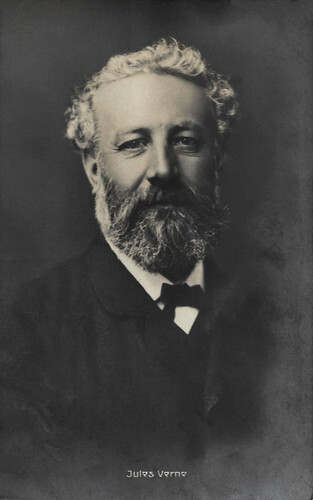
French postcard. Jules Verne.
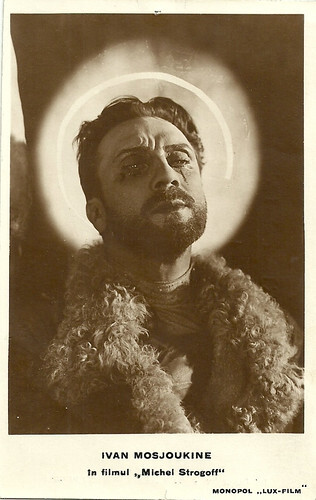
Romanian postcard by Editura Librariei SOCEC & Co. S.A., Bucuresti. Photo: Monopol "Lux-Film". Ivan Mozzhkukhin in Michel Strogoff (Victor Tourjansky, 1926).
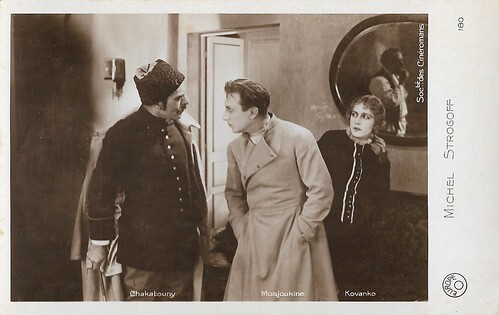
French postcard by Europe, no. 180. Photo: Société des Cinéromans. Ivan Mozzhukhin , Nathalie Kovanko and Acho Chakatouny in Michel Strogoff (Victor Tourjansky, 1926), based on Jules Verne's classic novel.
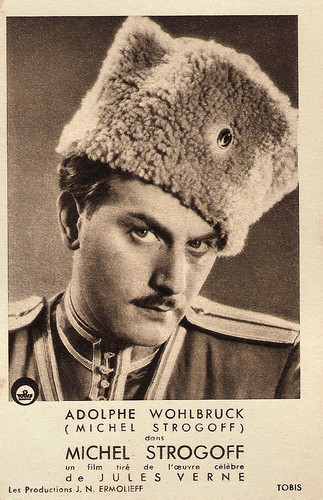
French postcard by Les Productions J.N. Ermolieff / Tobis. Adolf Wohlbrück in Michel Strogoff (Jacques de Baroncelli, Richard Eichberg, 1936), based on the novel by Jules Verne.
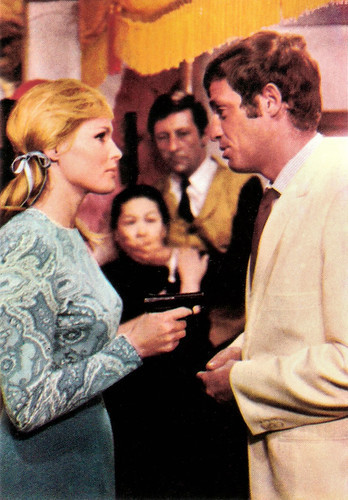
Italian postcard. Photo: Dear Film. Ursula Andress and Jean-Paul Belmondo in Les tribulations d'un Chinois en Chine/Up to His Ears (Philippe de Broca, 1965), based on the novel by Jules Verne from 1878.
Five Weeks in a Balloon
Jules Gabriel Verne was born in 1929 in Nantes, France. He was the eldest of five children of Pierre Verne, a Parisian lawyer from a family of lawyers, and Sophie Allotte de la Fuÿe. His father wanted Jules to succeed him, but Jules' heart was set on the sea.
The story that Verne only travelled in his stories is untrue. He made a train journey to Scotland and crossed the ocean in the first large steam-sailed passenger ship, the Great Eastern, to visit North America, including Niagara Falls. When he had earned a lot of money with his books, he bought a luxury yacht, Saint Michel III, with a crew of ten, and sailed the Mediterranean with it, making trips to England, Ireland, Holland, and Scandinavia.
In 1847, he went to Paris to study law. In 1857, he married Honorine de Viane, a widow who already had two daughters. In 1861 they had a son, Michel Jules Verne. Although Verne had finished his law studies, he wanted to become a writer. He wrote comedies in verse and prose, some of which were performed. In Paris, he met famous authors such as Alexandre Dumas père and his son, Alexandre Dumas fils, who gave him writing advice.
In 1862, he came into contact with the publisher Jules Hetzel. He had the plan to publish a popular scientific magazine. Verne had already published short stories in the illustrated family magazine, Musée de Familles. Hetzel's magazine Magasin d'Éducation et Récreation would publish most of Verne's novels in instalments and would subsequently publish his travel descriptions in the new series 'Voyages Extraordinaires', for which he entered into a contract with Verne for two to three books a year.
The first published scientific novel, as Verne called his work himself, was 'Cinq semaines en ballon' (Five Weeks in a Balloon). That novel was his breakthrough in 1863 and was published in several languages. Verne was already happy that he had reached his ideal and steady income. Therefore, he did not negotiate too much with the publisher, who would earn much more from Verne's novels than the author himself. The Verne family settled in Amiens in 1871.
Verne became a famous man. But at home, there were worries. His marriage was not happy and his difficult son Michel gave him many worries. Due to tensions in his early years, he suffered from stomach and facial pain. One evening an overworked cousin, whom he supported financially, fired at him with a revolver at low range. The wound on his left leg did not heal sufficiently. He had to walk with a stick. From 1888 onwards, Jules Verne served for sixteen years in the Amiens town council for the Republican party, where he devoted himself to education and the theatre. In 1905, Jules Verne died in Amiens at the age of 77, his grave is in Amiens.
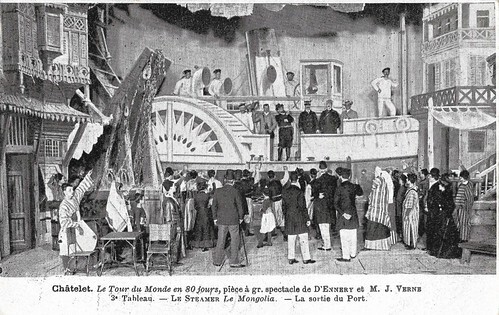
French postcard. Théâtre du Chatelet, Paris. 'Le Tour du Monde en 80 jours'. 3rd. tableau. 'Le Steamer le Mongolia - La sortie du port'. Play by Adolphe and D'Ennery and Jules Verne, after Verne's eponymous novel, written in 1873-1874, and first performed 7 November 1874 at the Théâtre de la Porte-Saint-Martin in Paris. Despite the enormous investments, even a real elephant was involved, the play was a giant success. People were queuing around the block to see how one could travel the whole world in eighty days, and in the case of the play, within the time span of just a few hours. From 1874 to the start of WWII, the play was constantly restaged and with great success. The version of this card must date from the early 1900s, while the first staging at the Châtelet dates from 1887, where it remained a crowd-puller for years.
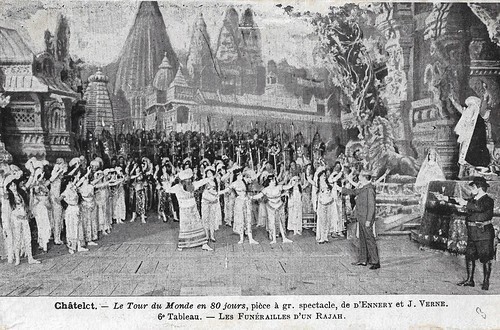
French postcard. Théâtre du Châtelet, Paris. Le Tour du Monde en 80 jours. 6th tableau. Les funerailles d'un rajah.
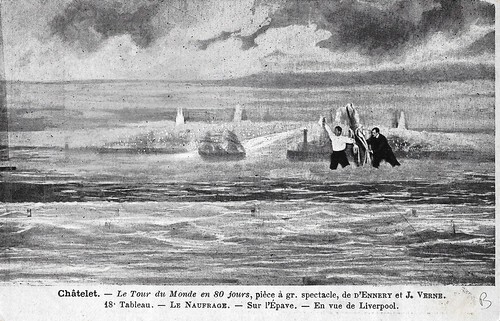
French postcard. Théâtre du Chatelet, Paris. Le Tour du Monde en 80 jours. 18th tableau. Le Naufrage - Sur l'Epave - En vue de Liverpool.
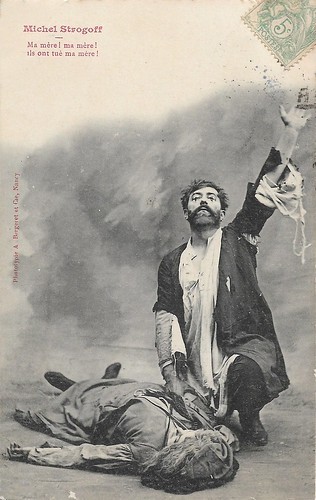
French postcard. Phototypie A. Bergeret et Cie., Nancy, 1900s. The setting may refer to a stage version but may simply also be staged for Bergeret's own interest. Around 1900 Jules Verne's 'Michel Strogoff' was one of the most popular adventure novels, set in 1860s Imperial Russia. In the 20th century, several film adaptations would be made in France, Germany, and elsewhere. Caption: My mother! My mother! They killed my mother!
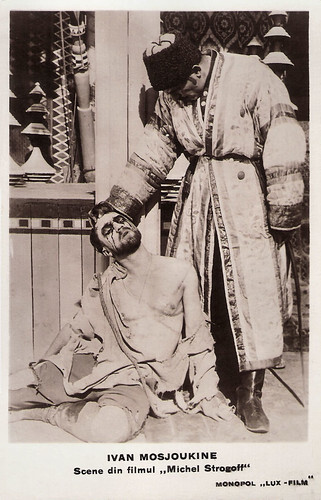
Romanian postcard by Editura Librariei SOCEC & Co. S.A., Bucuresti. Photo: Monopol "Lux-Film". Ivan Mozzhukhin in Michel Strogoff (Victor Tourjansky, 1926).
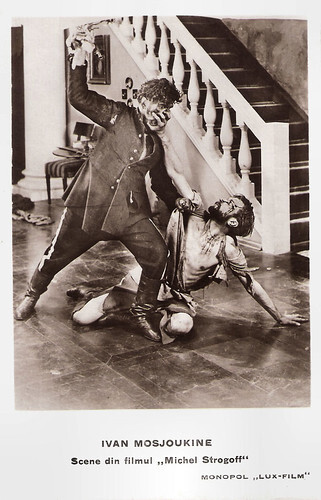
Romanian postcard by Editura Librariei SOCEC & Co. S.A., Bucuresti. Photo: Monopol "Lux-Film". Ivan Mozzhkukhin in Michel Strogoff (Victor Tourjansky, 1926).
Around the world in 80 days
Jules Verne had a Spartan way of working. He got up at five o'clock and worked on a book afterwards. In the afternoon, he could be found in a library documenting himself through books and magazines. In this way, he built up a collection of 20,000 fiche cards, from which he derived information for his stories. Verne had a technical interest, but his love was mainly for geography.
In 'Les enfants du capitaine Grant' (1867-1968; The Children of Captain Grant'), the geographer Jacques Paganel is the somewhat absent-minded but all-knowing companion of the travelling party that is searching for the lost captain through South America, Australia, and New Zealand. The interest in science and the belief in technical progress were great in the nineteenth century. There were plenty of travel journals, also from the century before.
'Le tour du monde en quatre-vingts jours' (1973; Around the world in 80 days) has been Verne's most successful novel, later also through film adaptations. By the time of his life, half a million copies had been sold. It first appeared as a serial in Le temps. Verne derived the itinerary from a magazine article and from a book about a trip around the world, published shortly before by William Perry Fogg, whom we know as the enterprising traveller Phileas Fogg from the story.
Even more lucrative than the fame he achieved with this were the revenues from putting the story on stage in a grand spectacle with real elephants on the stage, which became an enormous success. France began to become familiar with the concept of submarines. At the 1867 World's Fair in Paris, a model of 'Le Plongeur' (the diver) was on display, on which the illustrator of '20,000 Miles Under the Sea' based his work. The vessel operated on compressed air and proved very impractical. The nature of the deep sea could be studied in books and articles.
While writing, Verne discovered a follow-up story in the newspaper Le Petit Journal about a journey in a small submarine powered by electricity. It had been written by a member of the Amiens Scientific Academy, Verne's hometown. That Verne did not always test his imagination against reality is shown in the description of the submarine Nautilus. In the illustrations, the vessel appears narrow and closed, while inside there appear to be large spaces for a library, a dining room, and a large round window offering a view of the deep sea. Scientists, mostly stubborn and described with humour, are part of the crew and travelling companions. On the other hand, there is the engineer, a know-it-all, but often an inscrutable and fearsome man. Like Captain Nemo, inventor and pilot of the Nautilus, and Robur, skipper of the electricity-powered airplane the Albatross. This streamlined zeppelin-like airship has rows of propeller masts on its upper deck, powered by an electric motor.
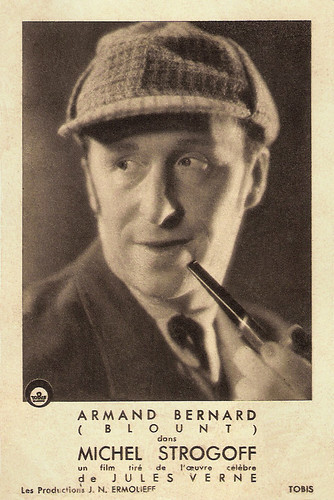
French postcard by Tobis. Photo: Les productions J.N. Ermolieff. Armand Bernard played the British correspondent Blount in Michel Strogoff (Jacques de Baroncelli, Richard Eichberg, 1936).
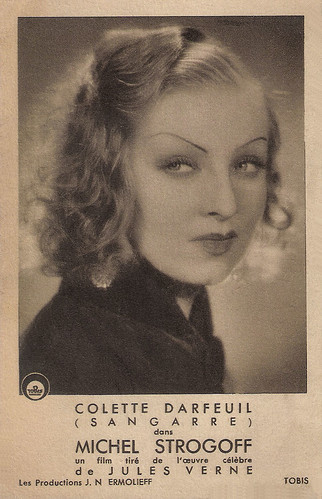
French postcard. Colette Darfeuil as the evil Sangarre, who plots together with Ivan Ogareff (Charles Vanel) in the French sound film Michel Strogoff (Jacques de Baroncelli & Richard Eichberg, Les productions J.N. Ermoliev/ Tobis 1936). Postcard for the showing of the film at the Paris cinema Marivaux. Adaptation of the famous novel by Jules Verne.
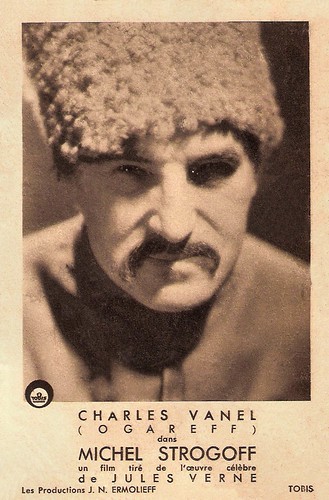
French postcard. Photo: Tobis / Les Productions J.N. Ermolieff. Charles Vanel as Ogareff in Michel Strogoff (Jacques de Baroncelli, 1936).
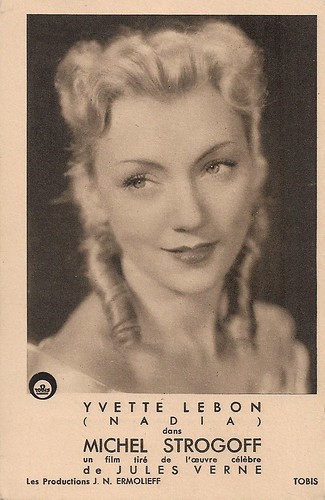
French postcard. Photo: Les productions J.N. Ermoliev / Tobis. Yvette Lebon as Nadia in the French sound film Michel Strogoff (Jacques de Baroncelli, Richard Eichberg, 1936). Caption: A film based on the famous novel by Jules Verne. On the back: shown at the Cinema Stanislas, between Thursday 8 and Monday 12 October. Nancy had a Cinema Stanislas (opened in 1925), but e.g. also Lunéville had one. Thursday 8 October refers to the year 1936, the year the film was released. The film premiered in Paris on 10 March 1936.
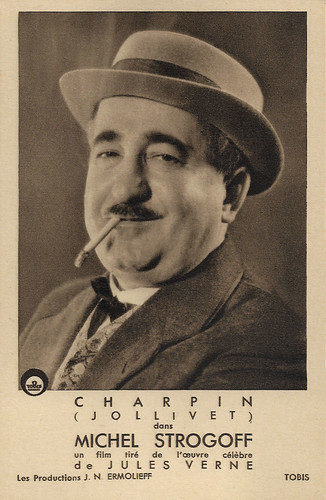
French postcard. Photo: Les productions J.N. Ermoliev / Tobis. Charpin as Jolivet in the French sound film Michel Strogoff (Jacques de Baroncelli, Richard Eichberg, 1936). Caption: A film based on the famous novel by Jules Verne.
The mysterious island
Not all Jules Verne books have a geographical exploration as their subject. A well-known type of novel is the so-called Robinsonade. Adults or boys end up on an island, where they try to build an existence with the available resources and their knowledge like Robinson Crusoe did. Examples are 'L'Île mystérieuse' (1873-1875: The mysterious island) and 'Deux ans de vacances' (1886-1887; Two Years' Vacation). The latter is a story written for children. Also 'Un capitaine de quinze ans' (1877-1878; A Captain of Fifteen), in which the young hero embarks on an adventurous journey on a twisted compass, can be counted among these.
In other stories by Verne, the events take place against the background of a historical event, a ghost story or a love story. A novel with a political meaning is 'Les cinq cents millions de la Bégum' (1879; Eldorado and the Monster Cannon of Steel City). In it, the inhabitants of a peaceful new French town are confronted with the threat of a new German town, entirely devoted to steel production. The enormous cannon, a predecessor of the Dicke Bertha from World War I, is both the symbol and the open danger. The Franco-German conflict after the war of 1870-1871 is clearly the background to this story.
A book with a patriotic slant and with a warning is 'Face au drapeau' (1896; Facing the Flag) The story focuses on a new enormous explosive mélinite, invented by the French Eugène Turpin. The latter figures here as the mad inventor Thomas Roch. The publisher and writer were sued by Turpin, which they won, assisted by the well-known French lawyer and statesman Raymond Poincaré. The work 'Paris in the 20th century', from Verne's early years, also contains a sharp critique of an over-engineered technical society. However, the melodramatic and satirical story was unbalanced.
Publisher Hetzel, therefore, did not wish to publish the manuscript, a decision to which Verne agreed. It was not until the 1990s that the text was found again and published. Verne is best known as the writer who "predicted the future". In his books, he described many things that were considered fantasy at the time, but later became reality in an impressive number of cases. He foresaw a journey to the moon that was first realised just over 100 years later during the Apollo programme. But there are also essential differences between this book and space travel.
Jules Verne's moon travellers, for example, are shot with a giant cannon and not launched with a rocket. The moon travellers do not land on the moon either but fly around it and then return, something that would happen later in the Apollo programme with Apollo 8 (1968, planned) and Apollo 13 (1970, unplanned, after an explosion on board). It is noteworthy that the launch site was also at Cape Canaveral and the place where Apollo 11 came down to earth was only a few kilometres different from the bullet in Verne's book.
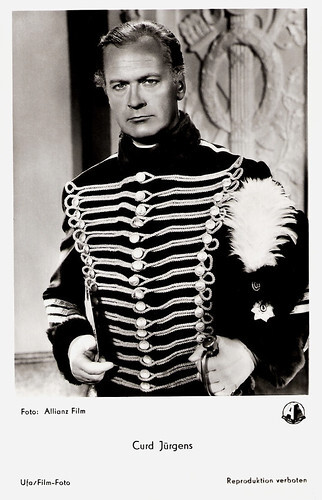
German postcard by Ufa, Berlin-Tempelhof, no. FK 3413. Photo: Allianz Film. Curd Jürgens in Michel Strogoff/Michael Strogoff (Carmine Gallone, 1956).
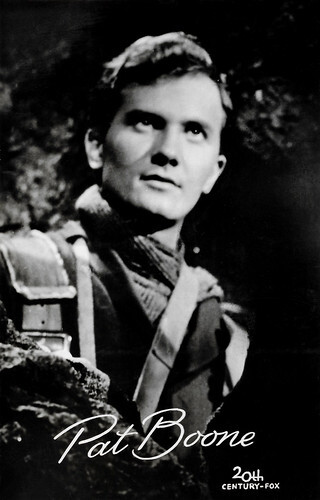
Dutch postcard by Uitgeverij Takken, Utrecht, no. AX 4213. Photo: 20th Century Fox. Pat Boone in Journey to the Center of the Earth (Henri Levin, 1959).
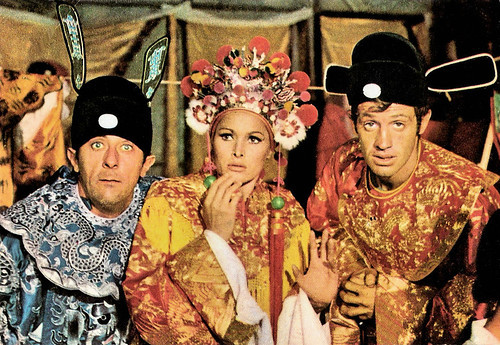
Spanish postcard by Postal Oscarcolor, no. 481. Photo: Jean Rochefort , Ursula Andress and Jean-Paul Belmondo in Les tribulations d'un Chinois en Chine/Up to His Ears (Philippe de Broca, 1965), based on the novel by Jules Verne from 1878.
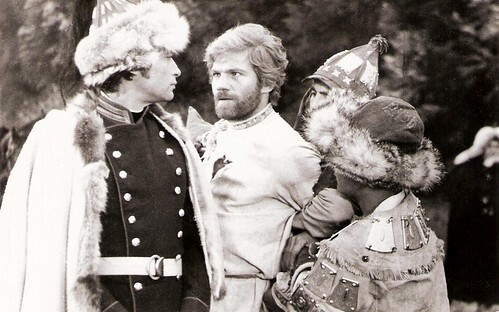
Vintage postcard. German actor Raimund Harmstorf (1939-1998) became famous as the protagonist in the German TV series Michael Strogoff: Der Kurier des Zaren/Michel Strogoff (1975), based on Jules Verne's adventure novel. Harmstorf was unforgettable as the handsome hero with a secret mission in an old Russia threatened by Kozaks and frozen rivers, wearing woolly hats and serious faces.
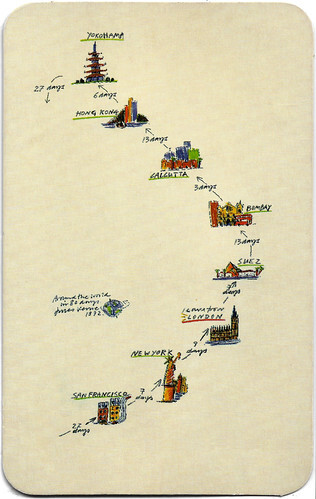
Italian postcard by Keep Moving in the Travel Card series, no. 1. Caption: Jules Verne (1828-1905), Round the world in 80 days (1873).
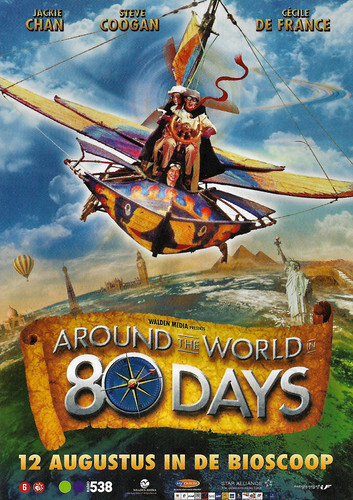
Dutch postcard by Young Media Group. Image: Walden Media / Independent Films. Poster for Around the World in 80 Days (Frank Coraci, 2004) with Jackie Chan, Steve Coogan and Cécile de France was based on the novel by Jules Verne.
Sources: Wikipedia (Dutch) and .

French postcard. Jules Verne.

Romanian postcard by Editura Librariei SOCEC & Co. S.A., Bucuresti. Photo: Monopol "Lux-Film". Ivan Mozzhkukhin in Michel Strogoff (Victor Tourjansky, 1926).

French postcard by Europe, no. 180. Photo: Société des Cinéromans. Ivan Mozzhukhin , Nathalie Kovanko and Acho Chakatouny in Michel Strogoff (Victor Tourjansky, 1926), based on Jules Verne's classic novel.

French postcard by Les Productions J.N. Ermolieff / Tobis. Adolf Wohlbrück in Michel Strogoff (Jacques de Baroncelli, Richard Eichberg, 1936), based on the novel by Jules Verne.

Italian postcard. Photo: Dear Film. Ursula Andress and Jean-Paul Belmondo in Les tribulations d'un Chinois en Chine/Up to His Ears (Philippe de Broca, 1965), based on the novel by Jules Verne from 1878.
Five Weeks in a Balloon
Jules Gabriel Verne was born in 1929 in Nantes, France. He was the eldest of five children of Pierre Verne, a Parisian lawyer from a family of lawyers, and Sophie Allotte de la Fuÿe. His father wanted Jules to succeed him, but Jules' heart was set on the sea.
The story that Verne only travelled in his stories is untrue. He made a train journey to Scotland and crossed the ocean in the first large steam-sailed passenger ship, the Great Eastern, to visit North America, including Niagara Falls. When he had earned a lot of money with his books, he bought a luxury yacht, Saint Michel III, with a crew of ten, and sailed the Mediterranean with it, making trips to England, Ireland, Holland, and Scandinavia.
In 1847, he went to Paris to study law. In 1857, he married Honorine de Viane, a widow who already had two daughters. In 1861 they had a son, Michel Jules Verne. Although Verne had finished his law studies, he wanted to become a writer. He wrote comedies in verse and prose, some of which were performed. In Paris, he met famous authors such as Alexandre Dumas père and his son, Alexandre Dumas fils, who gave him writing advice.
In 1862, he came into contact with the publisher Jules Hetzel. He had the plan to publish a popular scientific magazine. Verne had already published short stories in the illustrated family magazine, Musée de Familles. Hetzel's magazine Magasin d'Éducation et Récreation would publish most of Verne's novels in instalments and would subsequently publish his travel descriptions in the new series 'Voyages Extraordinaires', for which he entered into a contract with Verne for two to three books a year.
The first published scientific novel, as Verne called his work himself, was 'Cinq semaines en ballon' (Five Weeks in a Balloon). That novel was his breakthrough in 1863 and was published in several languages. Verne was already happy that he had reached his ideal and steady income. Therefore, he did not negotiate too much with the publisher, who would earn much more from Verne's novels than the author himself. The Verne family settled in Amiens in 1871.
Verne became a famous man. But at home, there were worries. His marriage was not happy and his difficult son Michel gave him many worries. Due to tensions in his early years, he suffered from stomach and facial pain. One evening an overworked cousin, whom he supported financially, fired at him with a revolver at low range. The wound on his left leg did not heal sufficiently. He had to walk with a stick. From 1888 onwards, Jules Verne served for sixteen years in the Amiens town council for the Republican party, where he devoted himself to education and the theatre. In 1905, Jules Verne died in Amiens at the age of 77, his grave is in Amiens.

French postcard. Théâtre du Chatelet, Paris. 'Le Tour du Monde en 80 jours'. 3rd. tableau. 'Le Steamer le Mongolia - La sortie du port'. Play by Adolphe and D'Ennery and Jules Verne, after Verne's eponymous novel, written in 1873-1874, and first performed 7 November 1874 at the Théâtre de la Porte-Saint-Martin in Paris. Despite the enormous investments, even a real elephant was involved, the play was a giant success. People were queuing around the block to see how one could travel the whole world in eighty days, and in the case of the play, within the time span of just a few hours. From 1874 to the start of WWII, the play was constantly restaged and with great success. The version of this card must date from the early 1900s, while the first staging at the Châtelet dates from 1887, where it remained a crowd-puller for years.

French postcard. Théâtre du Châtelet, Paris. Le Tour du Monde en 80 jours. 6th tableau. Les funerailles d'un rajah.

French postcard. Théâtre du Chatelet, Paris. Le Tour du Monde en 80 jours. 18th tableau. Le Naufrage - Sur l'Epave - En vue de Liverpool.

French postcard. Phototypie A. Bergeret et Cie., Nancy, 1900s. The setting may refer to a stage version but may simply also be staged for Bergeret's own interest. Around 1900 Jules Verne's 'Michel Strogoff' was one of the most popular adventure novels, set in 1860s Imperial Russia. In the 20th century, several film adaptations would be made in France, Germany, and elsewhere. Caption: My mother! My mother! They killed my mother!

Romanian postcard by Editura Librariei SOCEC & Co. S.A., Bucuresti. Photo: Monopol "Lux-Film". Ivan Mozzhukhin in Michel Strogoff (Victor Tourjansky, 1926).

Romanian postcard by Editura Librariei SOCEC & Co. S.A., Bucuresti. Photo: Monopol "Lux-Film". Ivan Mozzhkukhin in Michel Strogoff (Victor Tourjansky, 1926).
Around the world in 80 days
Jules Verne had a Spartan way of working. He got up at five o'clock and worked on a book afterwards. In the afternoon, he could be found in a library documenting himself through books and magazines. In this way, he built up a collection of 20,000 fiche cards, from which he derived information for his stories. Verne had a technical interest, but his love was mainly for geography.
In 'Les enfants du capitaine Grant' (1867-1968; The Children of Captain Grant'), the geographer Jacques Paganel is the somewhat absent-minded but all-knowing companion of the travelling party that is searching for the lost captain through South America, Australia, and New Zealand. The interest in science and the belief in technical progress were great in the nineteenth century. There were plenty of travel journals, also from the century before.
'Le tour du monde en quatre-vingts jours' (1973; Around the world in 80 days) has been Verne's most successful novel, later also through film adaptations. By the time of his life, half a million copies had been sold. It first appeared as a serial in Le temps. Verne derived the itinerary from a magazine article and from a book about a trip around the world, published shortly before by William Perry Fogg, whom we know as the enterprising traveller Phileas Fogg from the story.
Even more lucrative than the fame he achieved with this were the revenues from putting the story on stage in a grand spectacle with real elephants on the stage, which became an enormous success. France began to become familiar with the concept of submarines. At the 1867 World's Fair in Paris, a model of 'Le Plongeur' (the diver) was on display, on which the illustrator of '20,000 Miles Under the Sea' based his work. The vessel operated on compressed air and proved very impractical. The nature of the deep sea could be studied in books and articles.
While writing, Verne discovered a follow-up story in the newspaper Le Petit Journal about a journey in a small submarine powered by electricity. It had been written by a member of the Amiens Scientific Academy, Verne's hometown. That Verne did not always test his imagination against reality is shown in the description of the submarine Nautilus. In the illustrations, the vessel appears narrow and closed, while inside there appear to be large spaces for a library, a dining room, and a large round window offering a view of the deep sea. Scientists, mostly stubborn and described with humour, are part of the crew and travelling companions. On the other hand, there is the engineer, a know-it-all, but often an inscrutable and fearsome man. Like Captain Nemo, inventor and pilot of the Nautilus, and Robur, skipper of the electricity-powered airplane the Albatross. This streamlined zeppelin-like airship has rows of propeller masts on its upper deck, powered by an electric motor.

French postcard by Tobis. Photo: Les productions J.N. Ermolieff. Armand Bernard played the British correspondent Blount in Michel Strogoff (Jacques de Baroncelli, Richard Eichberg, 1936).

French postcard. Colette Darfeuil as the evil Sangarre, who plots together with Ivan Ogareff (Charles Vanel) in the French sound film Michel Strogoff (Jacques de Baroncelli & Richard Eichberg, Les productions J.N. Ermoliev/ Tobis 1936). Postcard for the showing of the film at the Paris cinema Marivaux. Adaptation of the famous novel by Jules Verne.

French postcard. Photo: Tobis / Les Productions J.N. Ermolieff. Charles Vanel as Ogareff in Michel Strogoff (Jacques de Baroncelli, 1936).

French postcard. Photo: Les productions J.N. Ermoliev / Tobis. Yvette Lebon as Nadia in the French sound film Michel Strogoff (Jacques de Baroncelli, Richard Eichberg, 1936). Caption: A film based on the famous novel by Jules Verne. On the back: shown at the Cinema Stanislas, between Thursday 8 and Monday 12 October. Nancy had a Cinema Stanislas (opened in 1925), but e.g. also Lunéville had one. Thursday 8 October refers to the year 1936, the year the film was released. The film premiered in Paris on 10 March 1936.

French postcard. Photo: Les productions J.N. Ermoliev / Tobis. Charpin as Jolivet in the French sound film Michel Strogoff (Jacques de Baroncelli, Richard Eichberg, 1936). Caption: A film based on the famous novel by Jules Verne.
The mysterious island
Not all Jules Verne books have a geographical exploration as their subject. A well-known type of novel is the so-called Robinsonade. Adults or boys end up on an island, where they try to build an existence with the available resources and their knowledge like Robinson Crusoe did. Examples are 'L'Île mystérieuse' (1873-1875: The mysterious island) and 'Deux ans de vacances' (1886-1887; Two Years' Vacation). The latter is a story written for children. Also 'Un capitaine de quinze ans' (1877-1878; A Captain of Fifteen), in which the young hero embarks on an adventurous journey on a twisted compass, can be counted among these.
In other stories by Verne, the events take place against the background of a historical event, a ghost story or a love story. A novel with a political meaning is 'Les cinq cents millions de la Bégum' (1879; Eldorado and the Monster Cannon of Steel City). In it, the inhabitants of a peaceful new French town are confronted with the threat of a new German town, entirely devoted to steel production. The enormous cannon, a predecessor of the Dicke Bertha from World War I, is both the symbol and the open danger. The Franco-German conflict after the war of 1870-1871 is clearly the background to this story.
A book with a patriotic slant and with a warning is 'Face au drapeau' (1896; Facing the Flag) The story focuses on a new enormous explosive mélinite, invented by the French Eugène Turpin. The latter figures here as the mad inventor Thomas Roch. The publisher and writer were sued by Turpin, which they won, assisted by the well-known French lawyer and statesman Raymond Poincaré. The work 'Paris in the 20th century', from Verne's early years, also contains a sharp critique of an over-engineered technical society. However, the melodramatic and satirical story was unbalanced.
Publisher Hetzel, therefore, did not wish to publish the manuscript, a decision to which Verne agreed. It was not until the 1990s that the text was found again and published. Verne is best known as the writer who "predicted the future". In his books, he described many things that were considered fantasy at the time, but later became reality in an impressive number of cases. He foresaw a journey to the moon that was first realised just over 100 years later during the Apollo programme. But there are also essential differences between this book and space travel.
Jules Verne's moon travellers, for example, are shot with a giant cannon and not launched with a rocket. The moon travellers do not land on the moon either but fly around it and then return, something that would happen later in the Apollo programme with Apollo 8 (1968, planned) and Apollo 13 (1970, unplanned, after an explosion on board). It is noteworthy that the launch site was also at Cape Canaveral and the place where Apollo 11 came down to earth was only a few kilometres different from the bullet in Verne's book.

German postcard by Ufa, Berlin-Tempelhof, no. FK 3413. Photo: Allianz Film. Curd Jürgens in Michel Strogoff/Michael Strogoff (Carmine Gallone, 1956).

Dutch postcard by Uitgeverij Takken, Utrecht, no. AX 4213. Photo: 20th Century Fox. Pat Boone in Journey to the Center of the Earth (Henri Levin, 1959).

Spanish postcard by Postal Oscarcolor, no. 481. Photo: Jean Rochefort , Ursula Andress and Jean-Paul Belmondo in Les tribulations d'un Chinois en Chine/Up to His Ears (Philippe de Broca, 1965), based on the novel by Jules Verne from 1878.

Vintage postcard. German actor Raimund Harmstorf (1939-1998) became famous as the protagonist in the German TV series Michael Strogoff: Der Kurier des Zaren/Michel Strogoff (1975), based on Jules Verne's adventure novel. Harmstorf was unforgettable as the handsome hero with a secret mission in an old Russia threatened by Kozaks and frozen rivers, wearing woolly hats and serious faces.

Italian postcard by Keep Moving in the Travel Card series, no. 1. Caption: Jules Verne (1828-1905), Round the world in 80 days (1873).

Dutch postcard by Young Media Group. Image: Walden Media / Independent Films. Poster for Around the World in 80 Days (Frank Coraci, 2004) with Jackie Chan, Steve Coogan and Cécile de France was based on the novel by Jules Verne.
Sources: Wikipedia (Dutch) and .
Published on June 18, 2022 22:00
Paul van Yperen's Blog
- Paul van Yperen's profile
- 13 followers
Paul van Yperen isn't a Goodreads Author
(yet),
but they
do have a blog,
so here are some recent posts imported from
their feed.



